Home >
Mashonaland West >
Thomas Baines journey to present-day Mashonaland: His first journey described from 16 February 1870 to 9 January 1871 (Vol 2)
Thomas Baines journey to present-day Mashonaland: His first journey described from 16 February 1870 to 9 January 1871 (Vol 2)
Introduction
This synopsis is taken from The Northern Goldfields Diaries of Thomas Baines (1869 – 1972) Volume 2 edited by J.P.R. Wallis. Note I have generally given Baines’ spelling first followed by later and present-day spellings in brackets. There are notes on the diaries in the article on Vol 1 of Thomas Baines diaries.
February 1870
Baines continues his stay at John Lee’s between Makhobe’s and Manyame’s kraals
15-Feb Robert Jewell prepares to leave for Tati with Dr Coverley,[i] Henry Hartley,[ii] Sam Edwards[iii] and Carl (Karel) Lee.[iv] After cleaning out his tent, Baines started an oil painting of Mohr’s wagons on the Market Square at Maritzburg. The rains have stopped at last.
17-Feb Baines continues with his painting with Mohr sitting at his side drawing charts. In the evening Arthur Levert[v] arrived bringing compliments from Nobengulu (Lobengula) Levert had asked Lobengula if travellers were permitted to go to the northern goldfields but did not receive a definitive answer although he received permission for himself to go. He asked Lobengula what would happen if Matjen, chief of the Bamangwato was attacked by the amaNdebele and was told the Tati miners would not be ejected and would only have to pay their annual tribute to the amaNdebele instead of Matjen.
Lobengula wanted to have messengers sent down to his brother in Natal [Kuruman] and says he was forced to accept the chieftainship.
18-Feb Levert left for Tati. Baines writes an amusing tale of the insects that fly onto the wet paint on his pictures…”I am sorry my art causes such a great destruction to insect life, but I cannot help it!”
In the evening word came that Du Plessis, a Zoutpansberg hunter has been missing for four days as his little assistant brought in his wagon. A party of searchers was made up…it is said this is not the first time he has lost himself.
20-Feb The search party has been out, but about 11am Du Plessis arrived at Lee’s having shot an elephant and carrying 102 lb of ivory.
Mohr has a letter from Hübner saying Nelson’s servants Kameela and Palhallah deliberately allowed Nelson’s oxen to stray and then hindered there being found and drove off his herd of goats with the result Nelson had to pay two guns to Matjen to recover them. Baines decides to write to Matjen for an explanation.
A party of English officers hunting in the district lost all six of their horses to horse-sickness.
A long line of amaNdebele fully equipped for war passed on their way to Tati, each carrying two assegai’s and provisions on their heads and with six slaughter oxen. Captain Elton[vi] and Baines visit John Lee and learn that these warriors have been sent to overtake and kill Babizaan and another who have been sent by Umbeko of the Zwangendaba regiment to learn about Kuruman. The warriors carry a letter stating they intend no harm to white men but have orders to kill the two messengers.
21-Feb Left Livingstone pills with Lee for his sick son. Du Plessis gives Baines geographical details on the Limpopo and Sabi river but they are so inaccurate as to be useless.
Feb-22 Baines does not know yet, but the installation of Lobengula as the king of the amaNdebele took place this day about 18 months after the death of Mzilikazi. The young king’s first acts being the sacrifice of cattle for his father and to the Mlimo at Inthlathlangela.
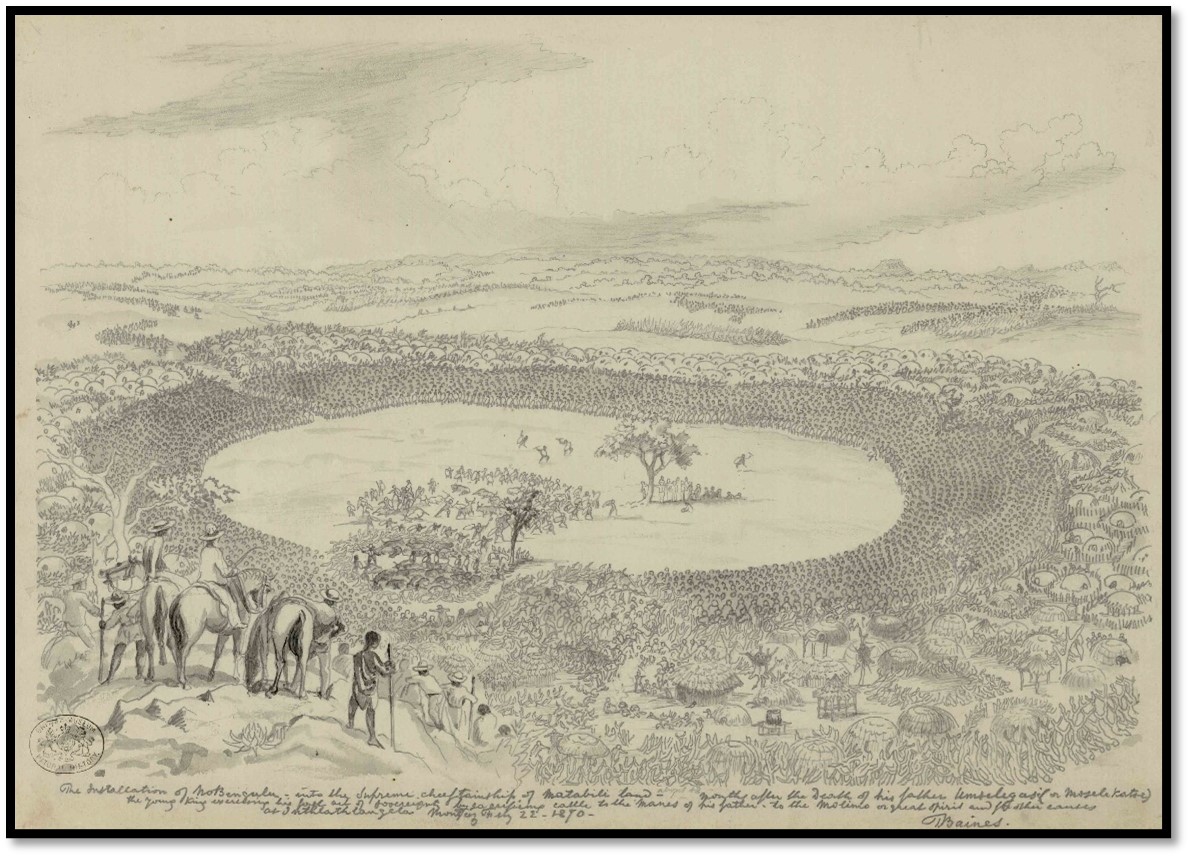
NHM (London) Baines Collection No 36: Installation of Lobengula as king on 22 February 1870
23-Feb Captain Elton and the officers are copying Baines maps as they wish to visit the Victoria Falls.
24-Feb Baines planes a plank in the saw-pit and sets Charley, his wagon driver, to work on others and he gets on very well. Lee’s driver gives Baines a beetle, 4 inches long, of a kind he has not yet seen.
25-Feb Confused messages from the warriors who have returned from Tati with the king’s cattle. One said seven messengers who had been sent by Umbeko to Natal to find out about Kuruman had been killed. Others said the white men would not let them kill the messengers. Others said Umbeko’s messengers had been warned to get out the country and fled to Matjen’s.
26-Feb Daniel Kisch, the London and Limpopo Mining Company storekeeper wants to go to the Victoria Falls with Elton and the officers Mitchell, McGrath and Saner and they left for Manyame’s kraal with a letter and blanket that Manyame refused to receive. He insisted they bring their wagons and remain there whilst the message was sent as has been the custom. They refused and wrote to Lobengula.
Jewell, finding Captain Escalez [Echalez][vii] has not arrived with heavy mining machinery because of flooding on the Marico river, has decided to go up the Ramaquaban (present-day Ramokgwebane) river with the wagon to trade for goats with the Makalakas.[viii]
27-Feb Manyame has sent the letter and blanket left by the English officers back to Lee saying he has no orders to take presents from people ‘in the veldt’ and all parties wishing to enter the country must come to his place.
Cruickshank, a trader at Hopetown,[ix] brought a letter from Nelson saying Kameela and Palhallah had escorted him to Seruli, where the petty chief attempted to make him pay tribute with guns. It was settled that Matjen at Shoshong would decide, but the oxen were driven away and only returned when he paid over the two guns. All parties then went to Shoshong where Matjen said the men were wrong and should get nothing, but he would keep the guns. The goats which also went missing, were returned to Nelson.
28-Feb Manyame’s councillor came to Lee’s and explained to the English officers why the message could not be sent.
March 1870
1-Mar The officers and Kisch leave for Tati.
2-Mar Baines bought 13 goats for goods worth £2-3s and gave ½ lb of blue beads for the headman worth 2s. In the evening the horse purchased from John Lee was brought. It is guaranteed against horse-sickness for the remainder of the rainy season (i.e. until May) but not for other causes.
3-Mar Marked outside-chests for the wagon that can be joined to form a boat.
John Lee to see Lobengula. Baines gave him 24 lbs of beads in part payment of the horse. Whilst painting Captain Elton’s picture some amaNdebele came from Lobengula. Lee says some were sent to escort the English officers; others will remain at Tati to ensure no messengers are sent to Kuruman with any of the London and Limpopo Mining Company wagons.
Babizaan has returned to the Zwangendaba regiment and has not been molested…any blame must attach to Umbeko. Baines says Lobengula seems moderate and politic, if not merciful. Lobengula says he will not kill Umbeko, but that he must go and seek another country and all who wish for another king must leave also. Umgnabo, a subordinate Zwangendaba chief said: “we have been in the wrong, but we were led by our chief Umbeko and thus it was not we, but he who was in fault, for our duty was to obey him.”
Yesterday was the feast of first fruits [the Inxwala] when samples of sorghum, corn, pumpkins and all the produce of the field are brought to the king to be tasted, after which the people may lawfully enjoy their produce.
4-Mar Lee left to see Lobengula and may bring up the subject of land purchase by the South African Gold Fields Exploration Company if he feels the timing is right.
5-Mar Charley is improving at sawing. Rest of the day painting. Mohr leaves on Monday for the Victoria Falls and then thinks of travelling downriver to the Portuguese towns of Tete and Sena. Baines advises him if he reaches Zumbo to turn up the Panjamey[x] river and try to join the hunters on the Ganyana [Manyame] river.
Baines writes to Matjen, the Bamangwato chief at Shoshong, not in the hope of getting the guns handed over by Nelson back, but to check further extortion.
7-Mar Mohr and Baines sewed up the neck of one of Mohr’s ostriches, now about 5ft high. Mohr is about to leave for Tati then up the Westbeech road to Daka (Deka) and to the Victoria Falls and then to follow the river to Baines’ former house at Logier Hill near Wankie’s village. At midnight Baines hearing a noise went outside but saw nothing.
Next day Jennings comes to say that an ox was heard in the night, uttering half-stifled cries as if a lion had a tight grip on its nostrils and sure enough, a red ox lately obtained from Lee, was missing. But the ox was later found and the noise remained a mystery.
In the evening Jan Vrei brought a small native boy that had been bitten by a snake. They tied a ligature above the puncture wound, squeezed the leg and Baines washed the wound with some ammonia in water. From the boy’s description it seemed to be a cobra.
9-Mar unloaded the wagon and repaired the damage caused by rats in the sorghum and other bags. Worked on painting of the expedition at Market Square, Maritzburg.
10-Mar Jennings helped saw and plane planks. Jennings snr wants a painting of elephant hunting.
11-Mar An expedition of gold prospectors arrived from Australia and New Zealand having left Maritzburg in November with two wagons. They are anxious to get to the Zambesi at its confluence with the Gwaai river and to prospect around Logier Hill.
Jacob brought in only 7 oxen; 11 having strayed. They have been seen far down the river and Jacob and Jonas must fetch them back tomorrow.
12-Mar Charley, Jacob and Jonas return in the afternoon with the oxen. Baines painted a herd of elephants with one being shot by Jennings snr. Payment to be in sorghum. The flies are most troublesome and prevent Baines from painting.
13-Mar He visits the newly-arrived prospecting party consisting of four North Germans or Swedes from Australia and New Zealand. Two have gone to Manyame’s kraal to seek permission to travel from the king. They have a buck-wagon without a tent, although most travellers use a Cape wagon with its tilt.
14-Mar Baines and Jennings snr have settled on £10 for the painting to be paid in meal or other stores. Jennings about to leave for the king’s prior to going hunting. Baines now alone at Lee’s once populous camping ground. An intense lightning storm at sunset accompanied by thunder.
15-Mar Threatening clouds and wind, but it rained elsewhere.
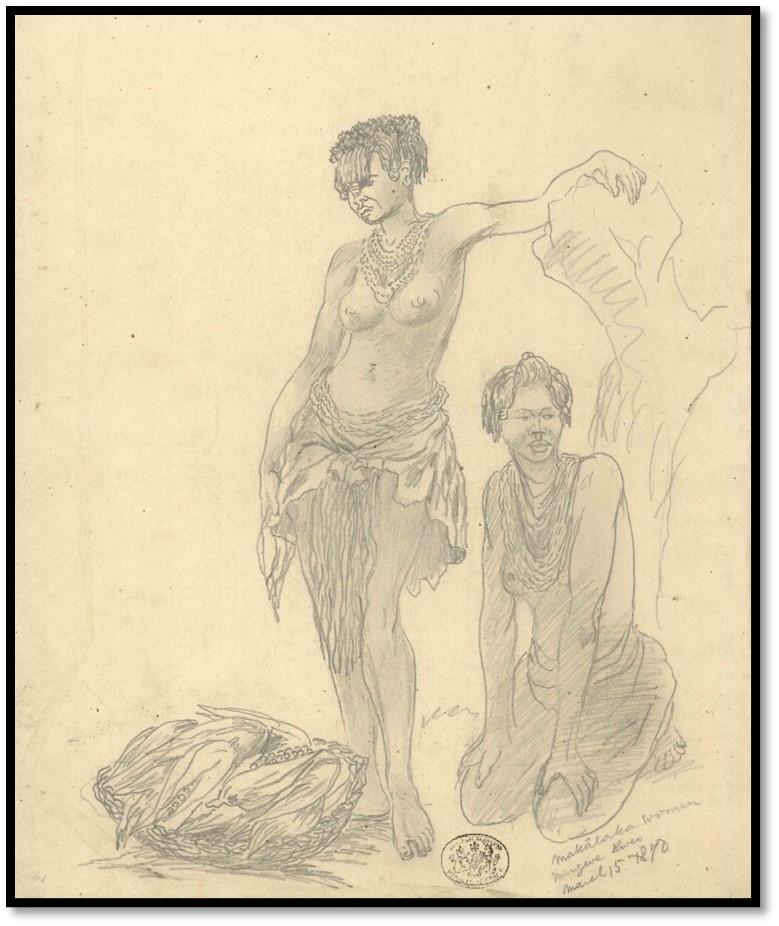
NHM (London) Baines Collection No 80: Makalaka women trading at Mangwe
16-Mar Jennings snr rode in leaving his wagons at Manyame’s. Heavy storm clouds in the distance.
Robertson, the Australian party leader walked from Inthlathlangela, 60 miles away, in two days having seen the king and leaves for the north tomorrow. Baines shows them a map and gives what information he can before a heavy storm blows up and he makes his bed in the kadel or bed-frame of his wagon. There is no interval between the blinding lightning flashes and crashing peals of thunder.
17-Mar He checks the boxes for water damage. Worked at Jennings snr’s painting and puts a foresight of hippo ivory on Charley’s rifle. Bartered bags of sorghum with a party of Mashona.
18-Mar Du Plessis and Karel Lee arrive from their hunt having killed a rhino and 4 buffalo…enough to make 300 shoe soles worth 1/6 per pair, plus sjamboks and whips. Then John Lee arrived, he was at Inthlathlangela when the Australians arrived and helped them get permission to travel to the Zambesi.
Lee has discussed with Lobengula that Baines went with Nelson to Hartley Hill with Ncumbata’s[xi] permission. Lee tells Lobengula on his return Baines was told “the owner of the land is not here” and postponed his business. Then Baines visited Lobengula with Lee, but as Lobengula was not yet appointed king he did not press his business. Lee says to Lobengula: “now, I believe I find you at home.” “Yes” he answered: “All this is true. I am at home and at liberty to hear him.”
Lee says Baines has been sent by his company from England with a view to purchasing the northern goldfields and he has been waiting until you [Lobengula] are able to give him an answer. Lee then said he had been appointed as the company’s agent and asked for an answer. The king replied that everything said was true and he was satisfied so “Yes, Mr Baines can have the northern goldfields.”
Lee asked what kind of goods or amount would Lobengula expect in payment and the king said he could not at present tell and would settle when Baines came.
Lee says the hunting question has not been satisfactorily settled. The king is not refusing the Europeans permission but wants his hunters to go first before the elephants flee into the tsetse-fly belts. Lobengula has become quite wide awake as to the value of ivory, but whilst he wants to get as much as possible, he does not want to lose the fees paid to him by the hunters.
Lobengula is also anxious to settle the southern border claiming the territory as far as Bamangwato and saying Matjen was appointed by Mzilikazi. He wants to regulate the admission of elephant hunters as far as the Macloutsie river. Lee believes this will be very difficult in such undeveloped and almost uninhabitable country with the Limpopo being capable of being crossed in many places.
19-Mar Baines sends a letter to Jewell at Tati by Jonas. In the evening Thomas Leask[xii] arrives from Potchefstroom with Captain Echalez, the crushing mill on wagons two days behind. Cruickshank arrives from the king’s saying the Zwangendaba are still unsettled, but most amaNdebele are at peace under Lobengula.
21-Mar Paul Zeitzmann [Zietsman)[xiii] wants a painting. Baines says he owes him for goats, if he does a ten-guinea painting they can repay the debt and acquire more goats. The subject to be an elephant hunt in which Zietsman successfully shoots two elephants.
Baines writes a letter to the directors of the South African Gold Fields Exploration Company noting John Lee’s advice to pay for land in a varied assortment of goods made up of horses, muskets, powder, lead, caps, blankets, clothing, calico, brass wire and knives. Karel Lee will post the letter at Marico.
22-Mar Leask and Robertson leave for Matabeleland. Cruickshank also wants a painting and gives ten guineas worth of assorted goods comprising:


Lee, Byles and Cruickshank all want to take shares in the South African Gold Fields Exploration Company that Baines takes as a good sign.
23-Mar Mrs Zietsman repairs the red ensign on Baines’ wagon very neatly. Zietsman has sold a rhino horn to Cruickshank that is 3 feet 10 inches long and weighs 22 lbs.
Jonas returns from Tati having left the letter to Jewell at the London and Limpopo Mining Company store as Jewell is still away north of Tati buying goats.
24-Mar Lee comes in and Baines shows him the list of goods to be offered to the king as the purchase price for the goldfields. Lee thinks Lobengula will view the valuable items as horses, saddles and bridles, muskets and ammunition, blankets, beads and brass wire. Lee recommends they wait for the king to state his price first as it may be lower then what they might offer him.
AmaNdebele resentment over the Tati district
Baines speaks to Lee about Matjen, the Bamangwato chief. Matjen was the son of Ingwati, Sekhomi was the son of Ingwati’s second wife, but was older than Matjen as the first wife only bore daughters at first. Mzilikazi conquered Ingwati, Matjen was taken prisoner and treated as a Maholi or serf before being admitted as a majokka [Majaka] or young warrior. Secheli [Sechele] and Sekhomi could not agree on the succession until Robert Moffat requested from Mzilikazi that Matjen be named as ruler. Mzilikazi agreed and Matjen was made chief with the Macloutsie river as his territorial boundary.
Baines writes that Tati is out of Matjen’s jurisdiction which is why the amaNdebele are indignant that he levies tribute and licence fees from those mining there. His refusal also to allow amaNdebele messengers to pass through his territory to seek Kuruman is also resented. They say to the Bamangwato: “We gave you your king and now you will not give us a road to seek ours.” [xiv]
25-Mar Lee obtained some arsenic from Tati and Baines has some success killing rats. Another was ‘harpooned’ by Baines but got away with an inch of sewing needle in its side.
George Westbeach [Westbeech] has returned from Inthlathlangela and says he thinks there will be more fighting over the succession issue. Westbeech says in going to Mashonaland in 1869 they went parallel but about 10-15 miles more south of Baines route [the Hunter’s Road] and closer to Thaba Enzimbi [Insimbe – Iron Mine Hill) They crossed the Ganyana [Manyame river] 25-30 miles above the Hartley campsite before turning east and reaching Golatima’s kraal. He is the brother of Watah [Hwata] a tributary chief of the amaNdebele living further east in the Mazoe Valley. Westbeech reached the Mazare [Mazowe] and found lemon trees planted by the Portuguese.
27-Mar The rats have caused some damage to trading stock; Baines decides to move his tent to a fresh piece of ground. Below a sketch from the diary with both ends of the tent open to let the air through.
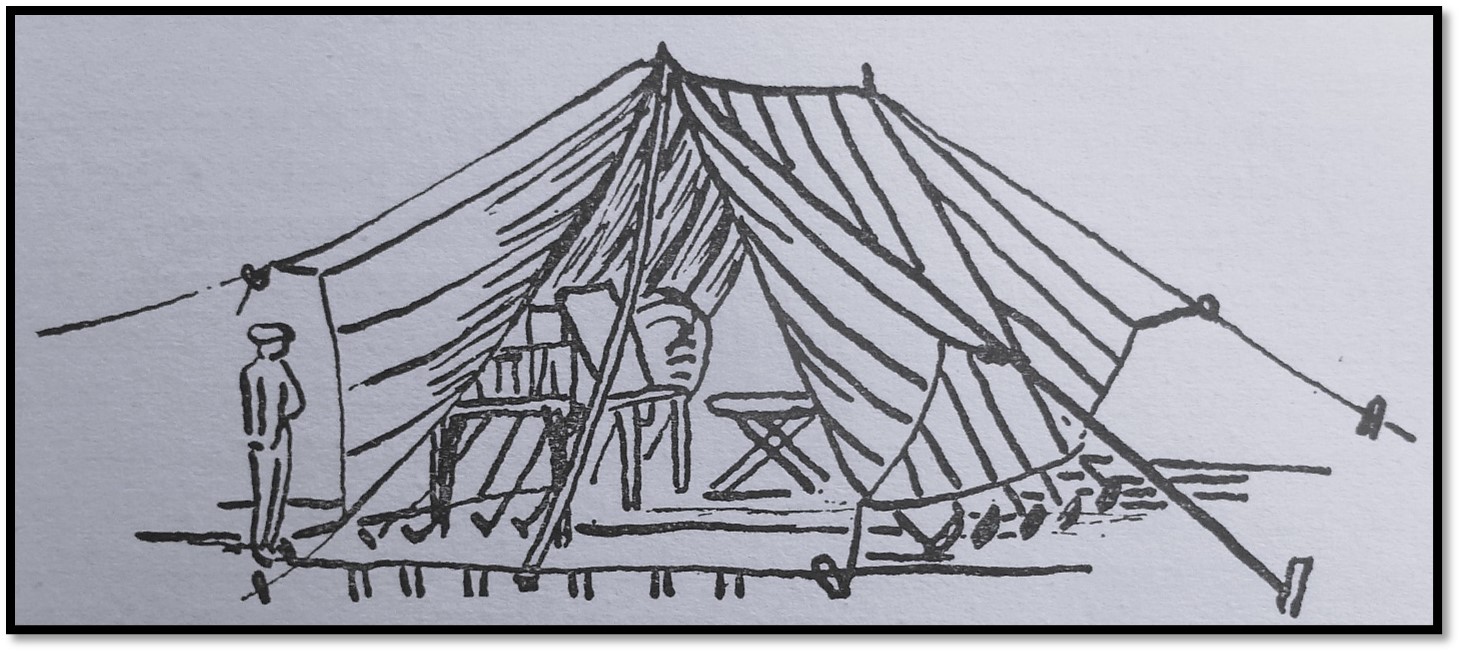
Westbeech, Thomas the trader, Zietsman and Meyers are leaving for Tati.
28-Mar Baines’ servants are constructing a platform 3 feet high to store the sacks of meal and sugar and defeat the rats.
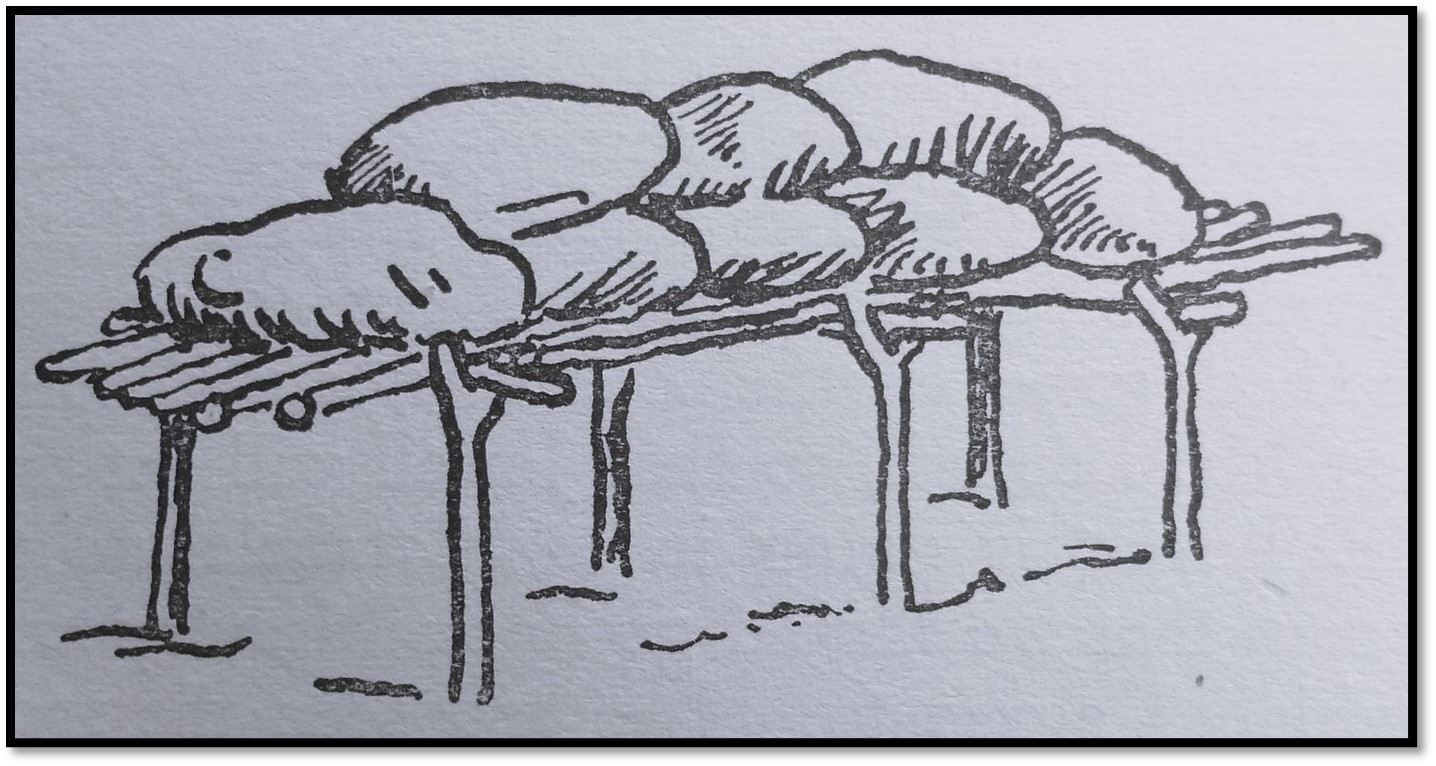
Tonight the oxen are missing. A lion was heard that may have frightened them. Charley and Jacob will follow their spoor tomorrow.
29-Mar A lion threatening in the night, but an hour after sunset Charley brought in all the oxen.
The servants unpack the wagon in preparation for painting it. Baines works on Cruickshank’s painting ‘The Traders Camp’ that he thinks will come out well. Lee arrives from Tati and reports that Jewell has 40-50 sheep and goats. Lee suggests that they should visit the king at Inthlathlangela. He has seen the spoor of 10-15 natives crossing the road and established they are Zwangendaba going to seek Kuruman and has sent a letter to the king reporting the event.
30-Mar Zietsman’s painting is finished that will be paid in goats to the value of £10. Maloney and Watson arrive. They have brought goats from villages north of Tati. Maloney [Henry Hartley’s son-in-law] has brought a letter from Hartley saying he is much recovered from his near-fatal brush with a rhino and is willing to supply the South African Gold Fields Exploration Company with sorghum and horses.
Baines writes that the Transvaal Republic claims the territory as far north as Lake Ngami and most of Matabeleland, but they are utterly unable to defend or occupy it.
31-Mar Maloney went to Manyame’s village and Watson cut out wood to make frames for the paintings. The servants catch a ringhals snake that spits toxic venom. By holding a glass plate in front of it Baines caught some venom that he examined under a microscope. His description is very accurate of its habits.
April 1870
1-Apr Watson cuts up two planks and they leave their botany and entomology specimens in a box at Lee’s to be sent to Natal whenever there is an opportunity. John Cooksley passed through on his way to Durban and states amaNdebele warriors are gathering to attack the Zwangendaba regiment.
2-Apr Jewell arrives and the wagons outspan side by side. He has purchased about 40 sheep, some were repaid for previous loans, but the servants let the remainder all stray. Mail has arrived at Tati with Captain Echalez. The Illustrated London News has Baines’ painting of the Deka camp in the Zambesi valley.
Nelson has arrived but says “it is not yet time to purchase land” without giving any reasons. It has become widely known in Natal that his rock specimens from Hartley Hill were gold-bearing and Baines thinks competitors will soon be in the field.
3-Apr Jewell gave Lee 336 lbs of beads for salted horses.
4-Apr All are hard at work packing the wagons. Baines takes the position of the Mangwe sawpit as:
Latitude 20° 44´ 40" Longitude 28° 13´ 48"
5-Apr Inspanned before midday and rode to the Semokhie (Simukwe) river and through fields of finger-millet and after sunset outspanned at Manyame’s.
6-Apr Some rain, but in the night a commotion in the sheep and goat kraal. Everyone is up with fire brands and they saw a wolf (leopard) with its victim surrounded by the dogs 70 yards from the wagons. John Mackenzie fired a shot, but the dogs made it difficult. One goat was found badly bitten and cut up for food next day.
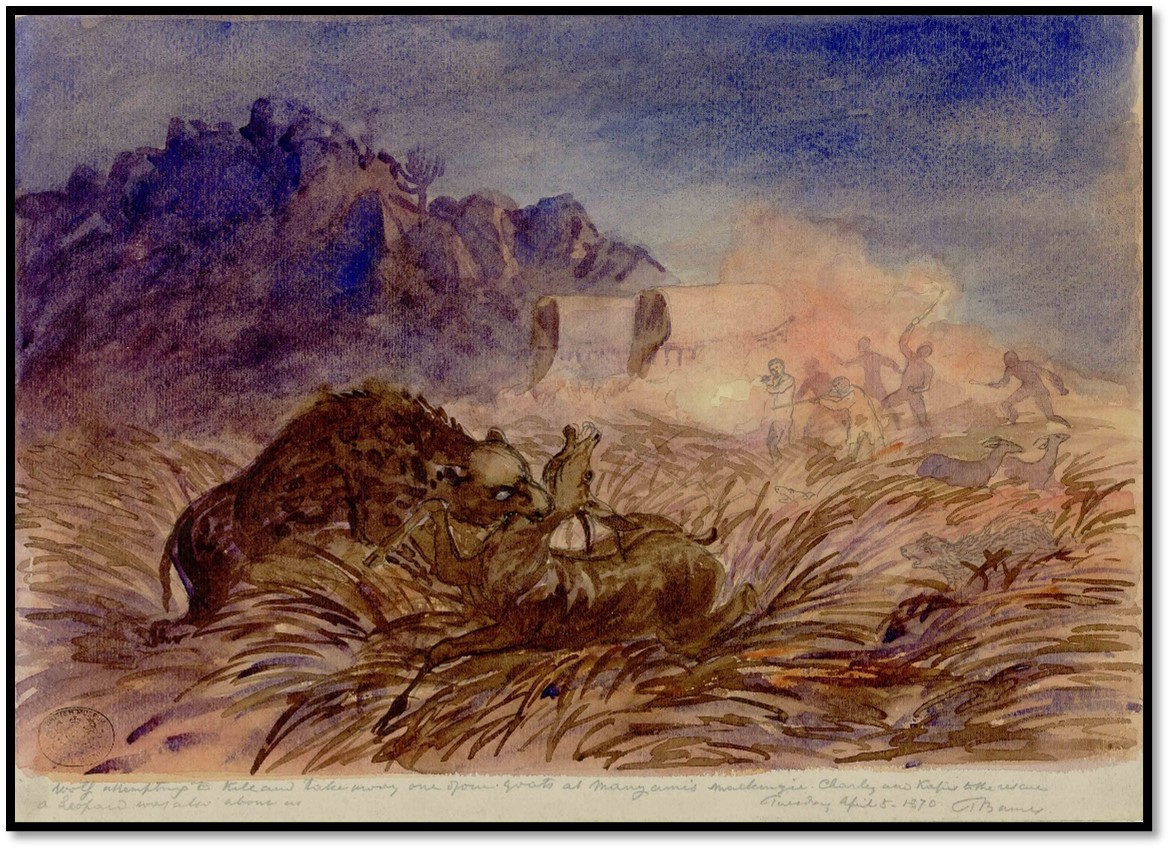
NHM (London) Baines Collection No 91: A leopard in the goat scherm at Manyame’s village
Manyame arrived and accepted a coat and gave the wagons permission to pass as they are going direct to the king at Inthlathlangela. The rivulet at Manyame’s is the first spruit of the Shashani and four more are crossed before reaching the Shashani itself…all run towards the Limpopo. After passing ‘the Top of the hill’ and trekking along the watershed they reach the first tributary of the Gwaai that runs north towards the Zambesi.
7-Apr They trek along the watershed, sometimes to the north and at other times to the south. The 3 oxen being cared for by Umvonubu are in good condition and he receives a blanket as reward.
Watson tells Baines of the Amatongas deception of the honey-bird. When guided to a bee’s nest by the honey-bird they give it only a small portion covered in snuff. The poor bird then believes the honey is poor quality and guides them to a new nest!
They pass to the north of Inthlathlangela and outspan at the Kumalo river. Lee’s servant William shoots 3 ostriches with feathers worth about £40.
8-Apr They cross the Kumalo drift and follow its path to its source passing a considerable village and continued east until they reach the king’s new town sited on the south slope of the watershed. Lee meets Kokotooi, the most senior councillor after Ncumbata and after some talk went to the king’s wagon, a fine kap-tented wagon filled with guns and articles presented to him. Thomas Maloney, George Phillips, Grant Robertson, Thomas Leask and others are already present with some councillors.
Hunks of meat were taken from huge clay pots on the fires. Baines writes: “lifted up a filthy looking mass which an inspector of flesh markets at home would most decidedly have condemned outright as unfit for human food.” The hungry waiting warriors chorused the praises of the king: “one ample vessel was placed before us and Lee, drawing his large clasp knife, commenced cutting the largest piece in thick slices and, each of us taking one and paring away the outside as we would the rind of cheese, soon found the wisdom of the proverb which teaches us not to judge solely by appearances.”
9-Apr Baines learns that lung-sickness is prevalent and sends the servants to build a strong kraal on the Kumalo river above the drift.
The king came and spoke to Lee about the South African Gold Fields Exploration Company. He admired their span of young oxen and examined Baines’ compass with interest. After a brandy and coffee he left saying he would send for Baines later in the day.
The tent was spread over the wagons as a dining and sleeping shelter. The ladies of the royal family were paying them a visit when a messenger arrived calling them to the king. Lobengula asked to see the portrait Baines had made of the royal jester, recognising him at once, and showing it to the circle of councillors who displayed their appreciation. They joined the group of Europeans and shared a huge calabash of beer. 30-40 warriors came in and seated themselves in a semi-circle, one shouting praises to the king, the others joining in the chorus.
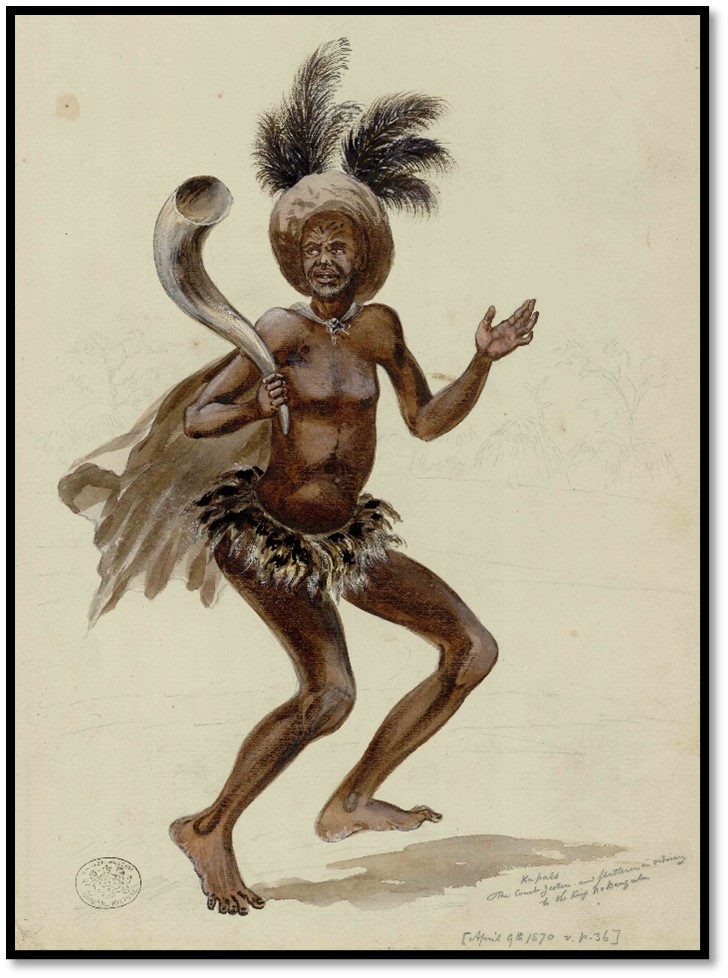
NHM (London) Baines Collection No 81: ‘Kafaes the Court Jester and Flatterer-in-Ordinary to the king Nobengula (sic) 9 April 1870’
Large chunks of meat appear and are passed from mouth to mouth until they disappear. Suddenly Kapaes himself appeared blowing into the big end of his ox-horn. When Lee showed him his picture, he is in no way disconcerted, but points out his hat feathers and other accessories, saying: “now I too shall go, like the other great people, to be seen by Kuruman and the great white men.”
Baines gets Lee to ask Umlomo Ngaba to pronounce the king’s name and is afterwards inclined to write it as Lobengula rather than Nobengulu. He is usually addressed as Kumalo or ‘Your Majesty.’
At length the meal is finished and the guests departed. Lee approaches the front of the wagon and tells the king that Baines is present and is invited to make his request. Baines tells him he had entered the country by permission of Ncumbata, had examined it as far as was practicable in the time he had and returned according to his promise and reported what he had seen. And he had sent Mr Nelson to make a report to the Natal governor. Now, if the king was disposed to sell, he was willing to purchase as much land as he would let him have.
Lee said Baines should state the boundaries, at the same time giving a hint not to make them too small. Baines then asked if he would grant from the Gwailo [Gweru] to the Ganyana [Manyame] and Lobengula answered that as he was only newly seated on his father's throne, he could not at once sell the land or define boundaries, but he would give Baines permission to go and search for gold anywhere within those limits and permission to dig and to use tools or machinery for crushing rocks as necessary. He would also give free passage to all the wagons in the service of the South African Gold Fields Exploration Company to come and go.
Lee then said Baines would require a house to live in and store houses as it would not be possible for the company to carry the heavy quartz-crushing machinery backwards and forwards every season. The king said all this was included in his permission to dig for gold and that it was Baines’ business to know what was necessary. All these details were included in his permission to dig for gold. But he also expected that Baines would not exceed the permission he had been given or do anything which would cause him [Lobengula] to regret having made such a concession in Baines’ favour.
Baines replied that he had done all that Ncumbata had asked of him and that now he would give his word not to exceed the king’s permission and if he required more, would approach the king and await his answer. The king said that the feelings of his heart were most friendly to Baines; he was disposed to grant him what he asked, but that other white men would come and make requests and that some white men were wicked.
Lee said Baines request was on behalf of the South African Gold Fields Exploration Company, he (Lee) as the company agent would not prejudice any other person or company and the king should grant or refuse any future request from others as he chose. The king said he would have preferred to see the whole company and was unsure why Nelson had left before the succession was settled in Matabeleland. Baines said that it was his duty to report to his company and the Natal governor; he had done so by letter but some things were better explained verbally than by letter. Also, Nelson needed to obtain stores and equipment for the expedition.
The king did not seem entirely satisfied with this explanation but said he had given his permission to dig for gold and to use machinery. He trusted Baines to adhere strictly to the terms of his permission. Baines thanked the king for his permission and gave the required promise.
Lee said as agent of the company he would act between Baines as local leader of the company and the king to which the king agreed.
The king asked when he would go and Baines said he would go when the present moon was spent and that Nelson would follow him. Lee said that there were rumours that the Portuguese and the tribes in the Zambesi valley were preparing for war and to get information Baines might walk to Tete to speak to the Portuguese and obtain information. The king did not object but said if there was any intention to invade his territory: “every dog would defend his own food.”
Lobengula’s food was now served and he urged Lee and Baines to join him.
When they get back to camp, Lee and Baines discussed a suitable present for the king. They believe a salted horse, saddle, bridle and good rifle, but these items are impossible to get at present. Their span of oxen have been admired by the king, but replacements would be hard to find. The king has plenty of wagons, a better one could only be obtained in the Craddock or George districts. They believe a couple of small cannon would be most acceptable, say two Armstrong or Whitworth small mountain carriage guns and ammunition.
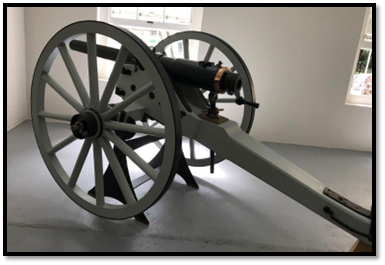
https://www.gunners.org.za/two-historic-2-5-inch-rifled-breech-loader-ar...
20-Apr Baines writes that since the 9-April it has been impossible to write his diary. Correspondence to London and Natal, finishing Cruickshank’s painting that has already been paid for in blankets and goods and preparations for trekking have kept him busy. Instead of being at Inyati mission, they are still on the Umzingante [Umzingwane] river with the king where a new royal village is springing up.
On 10 Apr the amaNdebele rain-doctor [rain-maker] protested that their red ensign was certain to prevent the rains arriving. The king said his people were firmly fixed in their beliefs saying: “If you wish to hang up the ‘cloth’ why don’t you hang it up inside the house?” (i.e. the tent) adding: “We do not believe that the killing of an ox or burning particular herbs makes rain., but these are the means by which we ask it, just as you ask it, by reading in your book and saying prayers.”
Baines letter on the royal succession
Baines writes a letter to Major Erskine in Natal giving the numbers and position of those who supported Kuruman and those who are disaffected and still hope for Kuruman. Baines read the letter, Lee interpreting for the king and after some minor corrections, he said he wanted Baines to write it on his behalf.
Baines wrote that the majority of amaNdebele became tired of seeking the missing heir and estimated between 9,000 – 10,000 people watched Lobengula installed at Inthlathlangela as king on 24 January 1870.[xv] They no longer believed Kuruman was living. The regent Ncumbata said he was ordered by Mzilikazi to kill Kuruman, that he attacked and killed the people of the kraal, but Kuruman was not there. He was however killed near a hill called Ntaba Induna, or ‘hill of the chief.’ The man who took his life was produced and gave evidence before the nation. Lobengula was saved by a man who hid him in the shield-house.
The disaffected number only 1,500 men, the biggest group from the Zwong Endaba [Zwangendaba] regiment have between 600-700 and they are headed by Umbeko. Umbeko is not amaNdebele, but a fugitive from Masuko’s tribe and became a favourite of Umselegasi [Mzilikazi] He is supported by his men because of their obedience to their inDuna and partly from distrust of the promise of immunity made by Lobengula. Other small regiments such as the Ngoba are also undecided, but Baines says these disaffected are not living in their towns and mostly scattered around the country and will most likely give in when they hear the person in Natal is not Kuruman.
Baines document for the king
On the Royal Service Matabili land [Matabeleland]
Notice.
All travellers, hunters or traders wishing to enter Matabili land are requested to come by the main road from Ba-Mangwato to Manyame’s where they are to report themselves as usual and obtain permission to come on to the king's residence and received their respective licences.
The hunter’s fee for the districts south and west of Shashani river will be one gun of the value of £15 British sterling, one 5 lb bag of powder, two 6 lb bars of lead and one bag of 500 caps. No occupation of the country is allowed nor are any houses to be built except by the king’s special permission.
This notice does not in any way affect the Tati gold diggings. In special cases, reference can be made to Mr. John Lee of Mangwe river, who has full power to act as the officer and agent of the king for the southern and Western District of this country.
All persons desirous of proceeding to the northern or eastern districts are to report themselves at Manyame’s and obtain permission to come to the king's residence to receive their licences as usual.
Given at the town of Gibbeklaik
11th of April 1870
Lo Bengulu
(Signed with) his X mark
King of the Matabili nation.
There followed another official letter written by Baines appointing John Lee of Mangwe river: “to be my lawful officer and agent on the southern boundary of my kingdom to receive all applications from travellers, hunters, traders or other persons desirous of entering my country and to grant or withhold permission according to my instructions now given or hereafter to be given to you from time to time…”
“…And I also appoint you to act generally as my agent according to your discretion and best ability for the benefit of myself and of the Matabili nation, pending the receipt of definite instructions from me…”
Baines would have liked to keep ‘Fritz’ the salted horse recently purchased from Lee for £65 worth of beads, but it was necessary to make a present and let the people see the gift, so the horse was offered to and accepted by Lobengula.
Baines says the royal ladies have the run of their stores and most days are seen in the vicinity of the wagon. A favourite ploy is to appear “with as little dress as Matabelean modesty will permit – a few inches of blue Selampore[xvi] shred up into a fringe and tastefully bordered with blue beads, forming about such a petticoat as the French lady is said to have mistaken for a necklace – and then ask for a blanket…”
He pays Umnombata [Ncumbata] a visit, says he is feeble with age but his mind is as sound as ever and talks freely on various subjects. “I have given him two black blankets and a hat and blankets, shirts and hats to his son Umthlaba and his chief attendant Umslanga and another. One induna, Sipho demanded a present on account of a wound given him by the Boers several years ago. We tell him to find out the Boer who shot him and ask him for compensation.”
Baines works on Cruickshank’s painting which is much admired by all who come to visit. The king sent down hard fat that Watson made into candles and then he wanted a candlestick, so Baines gave him the fancy biscuit tin he had converted into a lantern.
Rain and cold wind make it difficult to dry clothes and when Charley had hung up all their washing, the rain-maker brought the king and ordered all the white shirts and trousers to be taken in, wet or not, just as they were, because they might stop the rain.
Baines painted a zebra, an elephant, a wildebeest and a lion on sheets of paper that were much admired by the councillors. The king sent down a large lump of beef.
Latitude 20° 18´ 11"
18-Apr Packed the wagons, struck the tents, presents to Ncumbata and the king. “He accepted those but nevertheless would not let us go.” George Phillips was fitting out the king’s wagon and many of Baines’ spare items including straps and gear were pressed into service. Jewell and Watson are left to come on with the wagons, Baines leaves with Manyame’s guide, Sequati, and walks to the south-east crossing the Umzingwane river and then to the south-west to reach the intended halting place. The king has not arrived and they sleep at a deserted kraal on couches of grass.
19-Apr They walk over to their former camp at Gibbeklaik which is deserted but follow the tracks of three wagons to the new location where the king’s wagon has just outspanned and share a coffee and plate of boiled beef with him.
His ‘black oxen’ as Lobengula humorously calls his warriors hauled his wagon under the shade of a tree and soon made a stout fence around it. In the afternoon our wagons arrived, the trocheameter showing 22 miles, but the difference of latitude was just 4½ miles.
In the afternoon nearly 200 majokkas or young warriors assembled in full war dress wearing headdresses and capes of black ostrich feathers with anklets of animal fur that radiates around and overhangs the foot. The shields of ox-hide are about 3 ft 6 inches (107 cm) long and 2 ft 3 inches (68 cm) wide with the hide beaten and mixed with a little grease to make it pliant. Two slits are cut each side of the centre with a staff laid down the middle and used as the handle. The assegai has a 6 – 10 inch blade and a shaft of 3 – 4 feet and has iron at the butt end. Some carry knobkerries which are thrown with great skill and force.
They ran several times in a figure of 8 before forming the segment of a circle in front of the king about 50 yards away – the front comprising 50 warriors and about 4 rows deep and chanted the king’s praises in a deep chorus, lowering or raising their shields and striking them with their assegai’s, their feet being raised and brought down again with a heavy stamp. Their commander walked slowly to the music; at intervals the singing stopped, there was a wild shout and they charged within 6 yards of the king, then dropped to their knees, covered themselves with their shields, raised a shout in his honour and then retreated.
After the charges by the mass, individuals rushed out and encouraged by their comrades, boasted of their deeds through a pantomime and gave direct thrusts into the air for the number of enemies they had actually killed. They were given a couple of oxen and left after praising his generosity. Usually the oxen are killed cleanly with a thrust behind the shoulder, but sometimes it is only wounded and makes frantic efforts to escape, charging at the ranks, receiving fresh wounds and often carrying assegai’s that cannot be withdrawn.
Today the doctors and medicine men are working on the king and will have his body marked with charcoal and pipe-clay. They had visits from Zeitzmann [Paul Zietsman] and Kisch[xvii] from Tati and Baines was sorry to hear the confirmation of the death of Mr Harley at the Tati from fever. “Our deceased friend was a general favourite with the community on account of his general cheerfulness and general manners…”[xviii]
Latitude at the new king’s kraal 20° 22´ 46"
23-Apr They welcomed the Revd and Mrs John Boden Thomson of the London Missionary Society. Watson interpreted for him with Lobengula who was still in his ‘medicine paint’ and kilt of cat-skins over which he wore a shirt, hat and boots. Lobengula said he was sorry Thomson was in a hurry to get to Inyati mission and readily gave permission for Thomson’s wagon of personal goods to follow on. Great interest was shown in the household pet, a sleek white cat with a few black spots that attracted great attention as did its manner of playing with a caught mouse and scratching the noses of those who came too close.
24-Apr The king visited and seemed sorry that Thomson had not held Sunday morning service. When Thomson offered to do so, Lobengula seemed perplexed that there was no fixed time and this was not of vital importance. He thought: “there was but one word and began to find out that there were many.” Baines cleared his tent and threw open the front flaps, seated the king on one side of the table, Thomson on the other with the remainder forming a circle whilst Thomson repeated the Lord’s prayer, Watson interpreting and then a chapter from the New Testament followed by a general prayer with a plain and sensible sermon to follow on the theme ‘Them that honour me, I will honour.’ In the afternoon they sat with the king and drank tea and ate meat with him.
25-Apr The king came down early and looked through some of Baines’ portrait albums. Baines gave him a pair of large woollen blankets as a farewell present and the king asked where they intended to sleep. Rev and Mrs Thomson gave him an assortment of stud links for coats, vests and shirts. The ladies of the royal household were toosahed with a piece of chintz for a dress which Mrs Thomson was immediately asked to make. “The royal ladies exhausted all the blandishments of which female art is capable…”
The king then sent for them to eat a farewell meal of roast meat and said his heart was sore and he would feel lonely to lose all his white friends at once. Baines said Hartley was coming, but Lobengula said Hartley would go after elephants and would not stay with him.
The wagons trekked east about 3½ miles down the Umzingwane river before meeting George Phillips bringing Ncumbata in one of the king’s wagons accompanied by Kisch, Robinson, Hudson and others. In another mile the Umzingwane river was crossed and the long trek up to the watershed began. Here Baines gathered several specimens of white, milky and crystalline quartz, some oxidised red and others cloudy blue.[xix] However he limited his searches and did not break rocks to give the appearance of searching for gold.
26-Apr They reach Gibbeklaik with the trocheameter showing over 11 miles; Baines cannot account for the 22 miles going the other way.
Latitude at Gibbeklaik 20° 18´ 01"
Lieutenant Levert and Captain Elton arrive. Baines says Levert is likely to regain trust for the London and Limpopo Mining Company that it lost under Swinburne. He no longer supports bringing up Kuruman from Natal as it would bring about civil war. However Baines does not altogether believe Ncumbata’s story that Kuruman was killed at Ntaba Induna but thinks he may say this to settle the succession story by shutting out any hope of there being an alternative king to Lobengula.
Captain Elton has given up on his plan of going to the Zambesi and will explore the Limpopo instead. He has a workman at Tati building a boat and will use donkeys to get to the navigable part of the river.[xx]
In the afternoon they trekked north to Lobengula’s old village before turning north east along the watershed. Jewell’s wagon stuck fast in mud up to the fore axle and had to be dragged out from the rear. The servants cut brush and trees to corduroy the river bed.
27-Apr The three wagons crossed the drift and later passed Umzinyati village and crossed the Umghoosi [Umguza] river called the Umslambo Boloi (Bath of Majesties) at the crossing of the Kumalo road. A wife and child of the late Mzilikazi came to be toosahed and the headman gave them a jar of beer. They passed to the south of Thaba Induna.
Latitude 20° 05´ 18"
28-Apr Passed Elebaine and other villages.
29-Apr Crossed the Bembesi river, leaving the Zwangendaba hills on the left, steering for Inyati hill. Heavy showers near the Inkokwesi (Ingwingwisi) river. Rev Thomson outspanned at Revd Sykes’ house, the others on the rising ground behind.
Baines asks Sykes of what would happen if Kuruman came up to Matabeleland. He said Lobengula’s supporters would desert him, Kuruman would be made king and Lobengula and his councillors massacred. According to Sykes a letter from Theophilus Shepstone to Sykes played a big part in Ncumbata in electing Lobengula as the person in Natal at first denied being Kuruman, but afterwards stated he was Kuruman.
May 1870
1-May An English service held in the afternoon, Thomson conducting it.
2-May Revd Thomas[xxi] said Lobengula had granted Levert and the London and Limpopo Mining Company a mining concession of the Tati district between the Shashe and Ramaquaban rivers. Revd Thomas is leaving for Kuruman mission and Revds. Sykes and Thomson will visit Lobengula to discuss the future purpose of the Inyati mission and the question of traders bringing alcohol into the country.
3-May Letters going out with Thomas. Jewell re-arranging the cargo after collecting the goods Revd Sykes kindly stored for us. Watson making new side-boxes for the wagon with pointed ends so they don’t get torn off by thick bush. The drivers making yoke-skeis and veldt-schoens; Stone and Lawson converting our Potts muskets from flintlock to percussion cap. Baines finishing off Cruikshank’s painting.
Inyoka, Henry Hartley’s guide and Umnyakangya visit and are toosahed with shirts. Inyoka’s knowledge of old Mashona gold workings may prove useful to the expedition.
4-May In the afternoon Baines heard a scuffle and Booi, one of the herdsmen, came in hotly pursued by a warrior with shield and assegai. Baines seized the assegai and the drivers drove the man out of the tent. It appeared our cattle had got into his maize field and trampled it. Baines said if the man had come to him properly and complained, he would have been compensated, but instead he had taken the law into his own hands and pursued Booi, breaking one of his fingers.
Chief Mpoorto was sent for and Baines laid the case before him. The chief listened carefully and then to the man and told him he should have come peacefully and properly to Baines and he would have given compensation. Instead he beat the herdsman and had broken his finger and has therefore received compensation. Mpoorto then stayed for supper.
5-May Finished Cruickshank’s painting. Watched a column of black ants on the march carrying the corpses of white ants.
6-May Made a box for the paintings that was left with Revd Thomson to send to Lee or Levert. Thomas and Mrs McMaster arrive today from Marico. Stone and Lawson plan to journey to the Victoria Falls.[xxii]
7-May Baines draws a map from Mangwe to Inyati mission by the direct route and also by the ‘loop-road’ going by Gibbeklaik.
8-May Bulana visits and brings a sheep that was stolen last year at Zwangendaba. Bulana much offended when offered tinned herring and even an egg for breakfast, mutton however soothed his outraged dignity. In the afternoon Thomson preached to a congregation of six at an English service.
9-May In the afternoon their two wagons headed east, the heavy cases being left for Nelson who follows behind. Some trouble crossing small rivulets and only 6½ miles travelled.
Latitude 19° 41´ 38"
10-May Double spans of 26 oxen required to pull each wagon through the black mud. In the afternoon Baines wagon went nearly nave deep in mud and the disselboom broke. Jewell’s stout 3½ inch trek-touw rope broke three times before Baines put up his tent and had the wagon unloaded. Watson cut a strong pole of Mkondo wood and the oxen were secured in a kraal as lion could be heard in the distance. A spare trek-touw of ox-hide was taken by hyena during the night.
11-May All hands fixing the damages and preparing a new disselboom; the wagon lifted out with levers and a double span of oxen. Short treks were made, dragging each wagon a few hundred yards crossing the Issikombo and Shongo rivulets and finding a hard place to outspan at sunset.
Watson set traps for the hyenas. The sun had hardly gone down when a musket went off and Jewell and Watson left their supper and hurried after the servants. The hyena had received a shot through its neck and would not have felt Mackenzie’s blows given in revenge for the loss of his trek-touw. It turned out to be a spotted hyena in good condition, not like most of the mangy creatures seen. Baines gives a good description, saying it was a young male with Jewell using the skin for voorslags or whip-lashes and the flesh eaten by the servants.
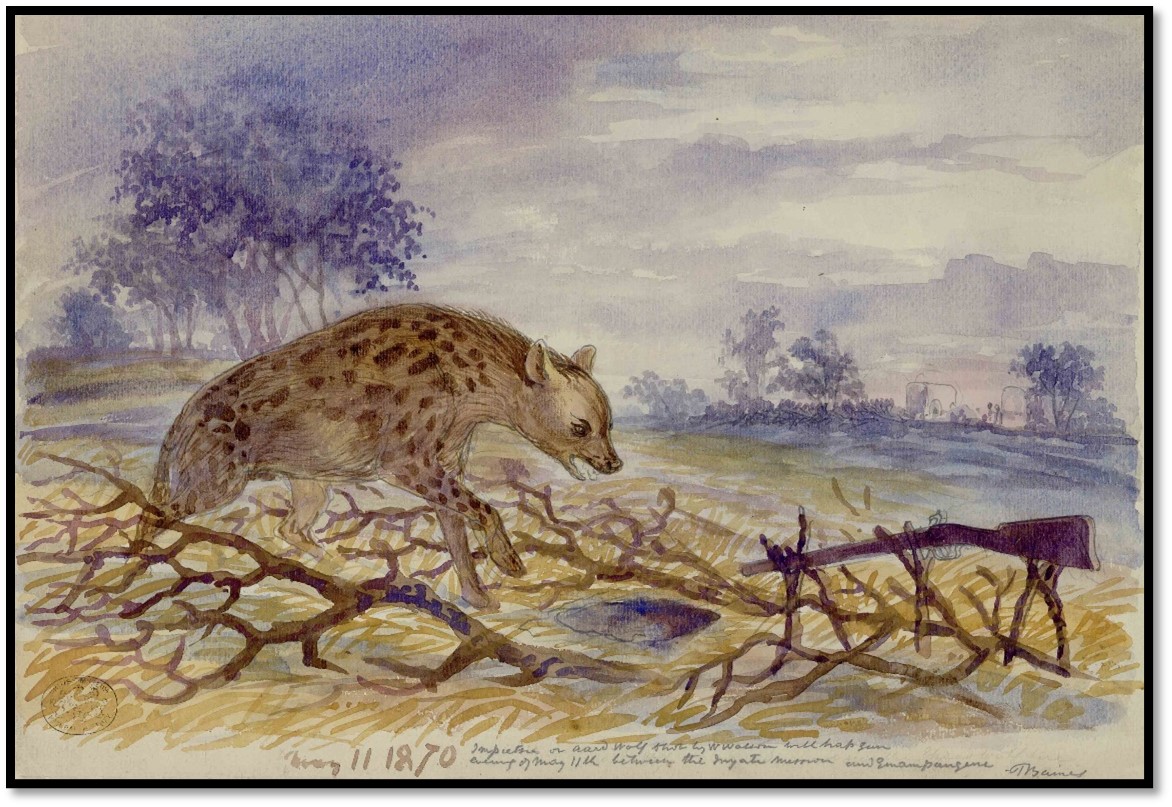
NHM (London) Baines Collection No 92: Spotted hyena shot by Watson’s trap-gun on 11 May 1870
12-May The first trek was a little more than a mile with two spans alternatively on each wagon and keeping their tracks apart from each other through the soft soil. A burrowing edible frog was unearthed and Jewell said the flesh, when roasted on a ramrod, was as tender as a chicken, but Watson would not eat it.
In the afternoon three spruits of the Shongwe [Longwe?] river were crossed.
13-May Generally firmer ground today. Baines walked to the Ngangas or doctor’s (spiritual healer) village and talked with the people until the wagons came up two hours later. At one place Jewell’s wagon sank to the floor boards on one side breaking the wooden casing of the fore-axle. At Induba’s kraal nearby, hyenas have taken ten persons, mostly children.
14-May Jewell bartered an ox and sheep for gun-powder and lead. They have to avoid sorghum fields and trek 5¾ miles to reach Emampanjene or Umbanjin where they meet old friends Umthlabba and Umslanga, Ncumbata’s councillors and some patients who were treated on the previous trek.
Latitude 19° 42´ 39"
15-May After Sunday service Baines went with Umslanga to see his wife and gave her medicine but had little hope it would do any good.
16-May Jewell bought sheep and goats and sorghum. Watson fired his forge, but rain stopped work. Hyenas are becoming a nuisance.
17-May A hyena took the kaross that Jacob had wrapped around his head to sleep. Patients came to be treated for eye infections. Cayenne pepper is given to the doubtfuls.
18-May Sent letters to Inyati and a map for Rev Sykes. As they packed to leave there were many claimants for medicine with most being given cayenne pepper, ginger and nutmeg with some children being treated for eye infections.
Left about noon with Inyassi once more as guide and after giving Ncumbata’s wives a bunch of blue beads each they crossed the Shangani river at the drift. Here Baines killed a puff-adder with a knobkerrie and whilst the wagons were being driven up the steep eastern river bank took the skin off the snake.
Then crossed the Dumas[xxiii] or Thomas river and outspanned on an open grassy ridge. Watson and Imvundusi went out looking for honey and came across a lion and his pride feasting on a buffalo, Watson fired a shot to scare them off and they collected the buffalo skin. The oxen must be well kraaled with watch-fires on both sides. The puff-adder was cooked for supper, its flesh white and firm and tasting almost like chicken; Jewell joined Baines, but again Watson declined.
19-May Crossed a small tributary of the Dumas and came to the Tyabensi and made a drift by digging away the banks and filled the riverbed with trees and brush. By breakfast they crossed the river and travelled 1½ miles. To grease the wagon wheels a fork was cut and the wagon lifted with a long stout pole. After a delay for rain several spruits of the Tyabensi are crossed; the Tyabensi is an eastern tributary of the Shangani, the countryside grassy and undulating and open with clumps of trees resembling the Kameeldoorn (Camel thorn, although in Southern Africa it is the giraffe that likes to browse on this tree)
20-May Left the spruits of the Tyabensi and reached the first spruit of the Umvungu [Vungwana?] with the main watershed about 30 miles (50 kms) south of their path. Saw the spoor of a large herd of buffalo. Inyassi and Mackenzie wounded a large white rhino grazing with a herd of tsessebe and Watson shot a sable antelope, called by the Boers Zwaartwitpens (or black-white-belly) Baines sketched and measured the sable antelope and gives a good description of its appearance.
Latitude 19° 27´ 46"
23 May Watson set off to hunt hippo (Zeekoe) in the Umvungu but did not reach the pools. Baines intended mapping, but Charley sent word he had shot a tsessebe so Baines measured and sketched the male animal. Again, a very detailed and meticulous description. Watson cooked the tsessebe head in an oven cut into the side of an ant-hill 10 feet high and 30 feet wide.
24-May Trekked with everything wet after yesterday’s showers. On a boulder in a rivulet with steep sides were several nests built by Hammerkop (Scopus umbretta) out of reach of snakes or small mammals that Baines sketched whilst the wagons were coming up. They came across a large reef of pure white quartz from which Baines took samples and then crossed the Matcapuekapa river with steep banks that joins the Ngamo, both of which flow into the Gwailo [Gweru] river. There is no mention of crossing the Vungu river.
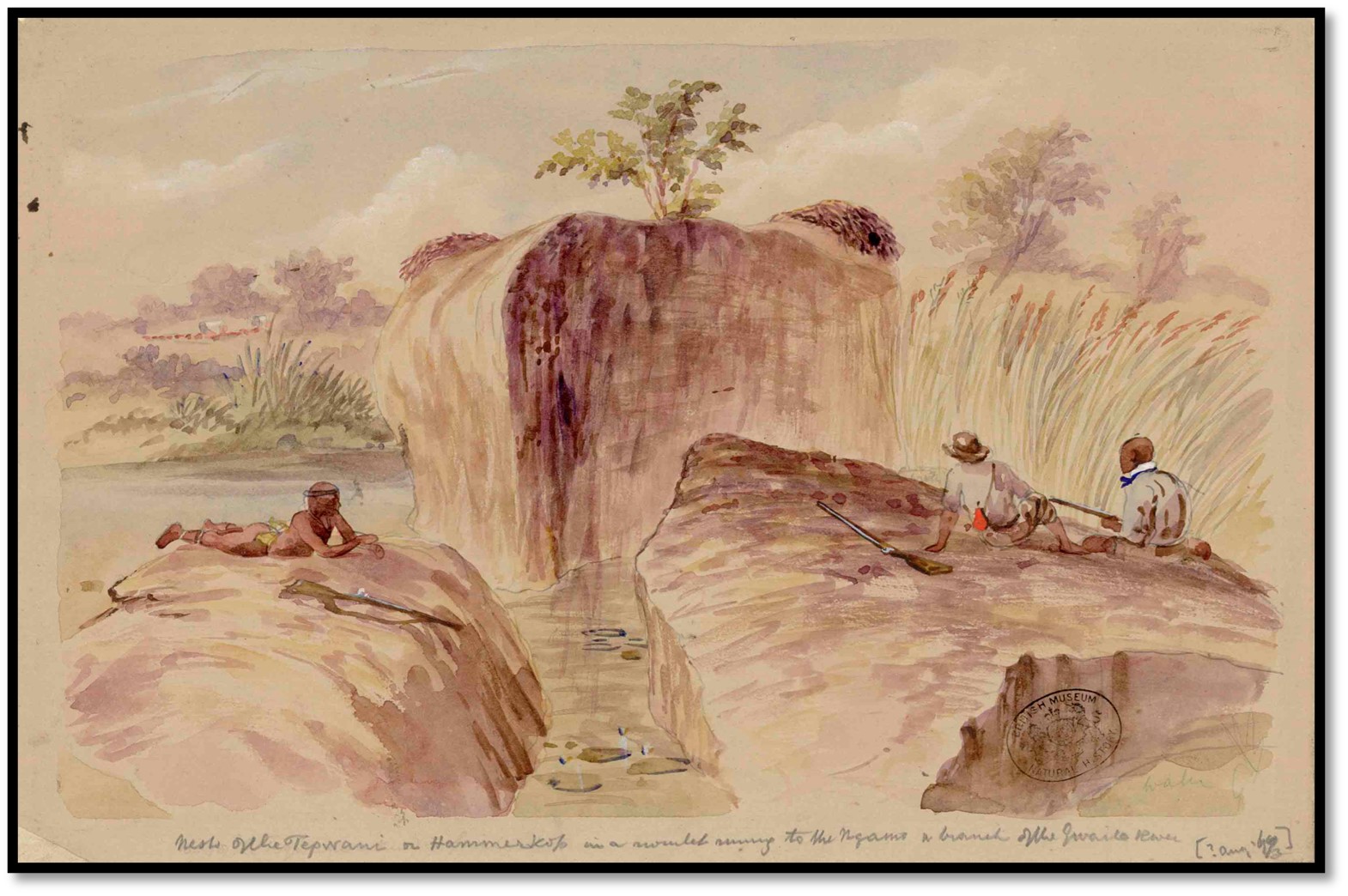
NHM (London) Baines Collection No 15 Hammerkop (Scopus umbretta) nest in a rivulet running to the Ngamo, a tributary of the Gwailo (Gweru) river
Here they outspanned whilst Jewell and the driver made a drift and in a further 1½ miles reached the Gweru river and crossed its stony stream bed. Shots fired at a small herd of eland but without result.
Latitude 19° 21´ 30"
25-May Trekked north-east for 7 miles through long wet grass that soaked their clothes passing through groves of mopane and kondjie trees passing the Moquegua hills and came to the road and outspanned by a kraal last used by Thomas McMaster.
Latitude 19° 21´ 30"
26-May Crossed the Inchoomba rivulet and outspanned. The Quaequae (Kwekwe) river runs strongly, knee-deep and about 35 yards (32 metres) wide but was crossed without difficulty at the drift and they camped under some shady trees to await the arrival of Nelson with Henry Hartley.
27-May Watson and Baines go hunting and find a mile down the river to the north-east a fine reef of white quartz and old Mashona gold workings that the amaNdebele with them thought were game pits.
28-May Three of the servants had fever and are given tartar emetic. Tried fishing, Watson caught some barbel.
30-May Baines spent the day adding to his map. Saw and caught a night adder swimming across the river.
31-May Worked again on the map. Watson caught more fish and set a trap gun that went off during the night and mortally wounded a hyena.
June 1870
1-June Baines caught a good sized barbel. Left the Quaequae (Kwekwe) river about 9am passing through park-like groves of Matchabeela and kondjie trees. Rested on a quartzose hill beside the road and reached the Impembesi (Bembezana) river at sunset. Little game seen as water is plentiful. The Bembezana has very steep reedy banks much ploughed up by buffalo. Watson caught 3 or 4 barbel, the amaNdebele watching with great interest. It is against their custom to eat fish, but some have made up their minds to eat what we do.
2-June Baines takes Inyassi, his son Macuthlumba and Golube (pig) to the north-east after crossing the Bembezana and found a Mashona village on a hill, but the huts are deserted and falling down. Came across a fine quartz reef and took specimens for Nelson. Then Baines shot a rietbok (reedbuck) doe and the carcase was taken back to the wagons.
Latitude 18° 58´ 45"
3-June Left the Impembesi [Bembezana] river and trekked towards the Sebaque [Sebakwe] river. The Sebakwe was broad and clear about knee-deep and 30 yards wide, although the sandy bed was over 120 yards wide. They outspanned near a clump of dwarf palms and one of the herdsmen brought some buffalo dung that was still warm. Watson and the men cast bullets for their guns and after a breakfast of barbel and reedbuck took up the spoor.
The buffalo herd was easy to follow and went across a good sized tributary of the Sebakwe and afterwards Golube pointed out a dark object under a mopane tree of a buffalo. Baines’ bullet from his Wilson gun struck the centre of the buffalo’s shoulder with a second soon after. The animal turned and came for Baines, but Jewell put his bullet from his 12-bore Wesley Richards just behind the first shot. The drivers, Charley and Mackenzie also fired. Another shot hit the hind leg, and Jewell gave it another bullet entering above the left eye.
They chased after a second buffalo, Umfundusi firing in front of Baines causing the animal to turn with the servants chasing and firing a volley and then rushing in with their assegai’s. A mighty bull, the patriarch of the herd tossed in mortal agony, but was still dangerous. Baines fired behind the ear, Jewell did the same and the buffalo finally collapsed. Baines wanted Jewell to take a photo and they waited for the oxen spans to arrive whilst Baines sketched the carcase as he sat on a wood stump.
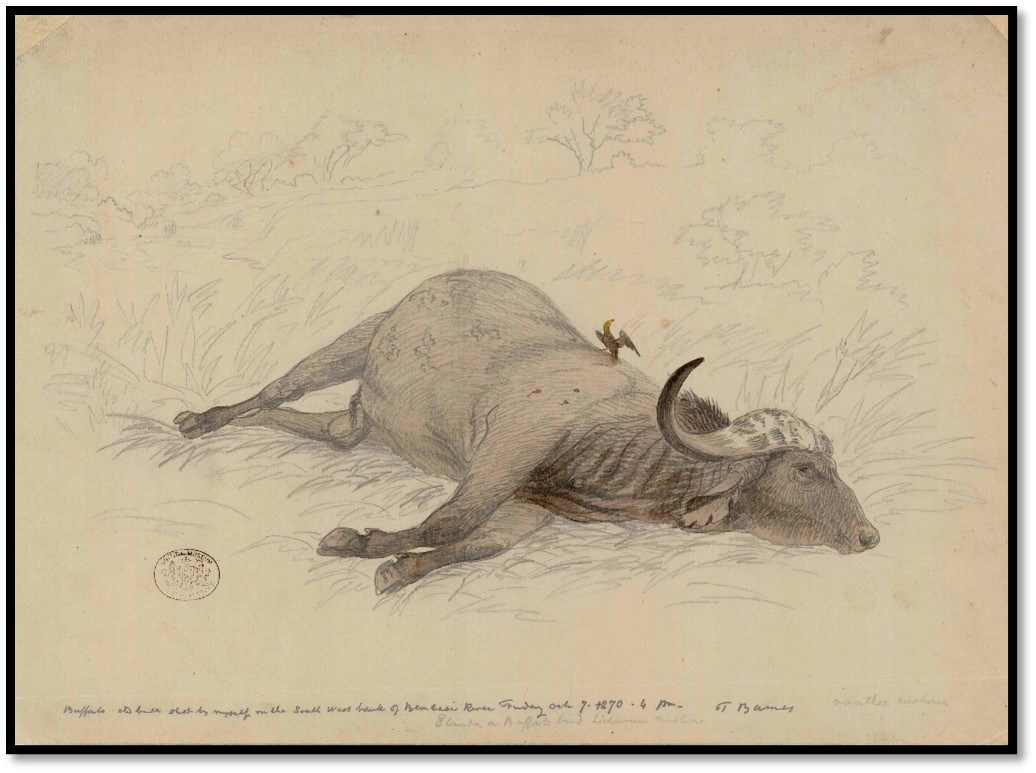
NHM (London) Baines Collection No 134: Thomas Baines sketch of a Buffalo and yellow-billed oxpecker (Buphagus africanus)
The buffalo were skinned, their meat cut into strips with a little salt and hung on lines and poles from tree to tree to dry in the sun. Jewell got a good photo of the men grouped around the wagon and a clump of dwarf palms in the rear.
4-June Mackenzie cut a trek-touw from the hide of the smaller bull. Umfundusi shot a hyena, that night they were all around the camp making the night hideous with their cries.
Latitude 18° 55´ 07"
5-June Charley ill with fever and given tartar emetic, which relieved him. During the night Watson heard a lion crunching the buffalo bones and the whole force with 7 guns went down, the servants with fire-brands. The lion retreated at their approach and was not heard again that night.
6-June Charley still not well. Watson’s trap-gun discharged after dark but no carcase was found.
7-June The old tent patched up with light showers expected so Baines can do some mapping, writing or painting and Jewell can do accounts or photographs.
In the evening a loud altercation. Watson had intended to lie in wait for lion tonight and told Macuthlumba to cut poles to make a platform in a tree, but he had refused saying it was dark and unsafe because lions were prowling around. Words were exchanged and he complained Watson had struck him. Inyassi said they would all leave.
Baines said they could leave, but that he would not allow any man to be struck. Watson was the man in danger as he would be on the platform that night and only wanted Macuthlumba to cut poles and build a platform. If he had done what was required nobody would have struck him. Inyassi attempted to keep up the controversy with Watson, but Baines told him that anything that was said should be through him. Baines would speak to Watson privately at the first opportunity.
Watson went on his platform and at 10pm fired a shot at a hyena, but it got away. After midnight he fired again and this time killed a hyena of a much darker colour than usual.
8-June Lion around the camp at night. Baines sketched the hyena.
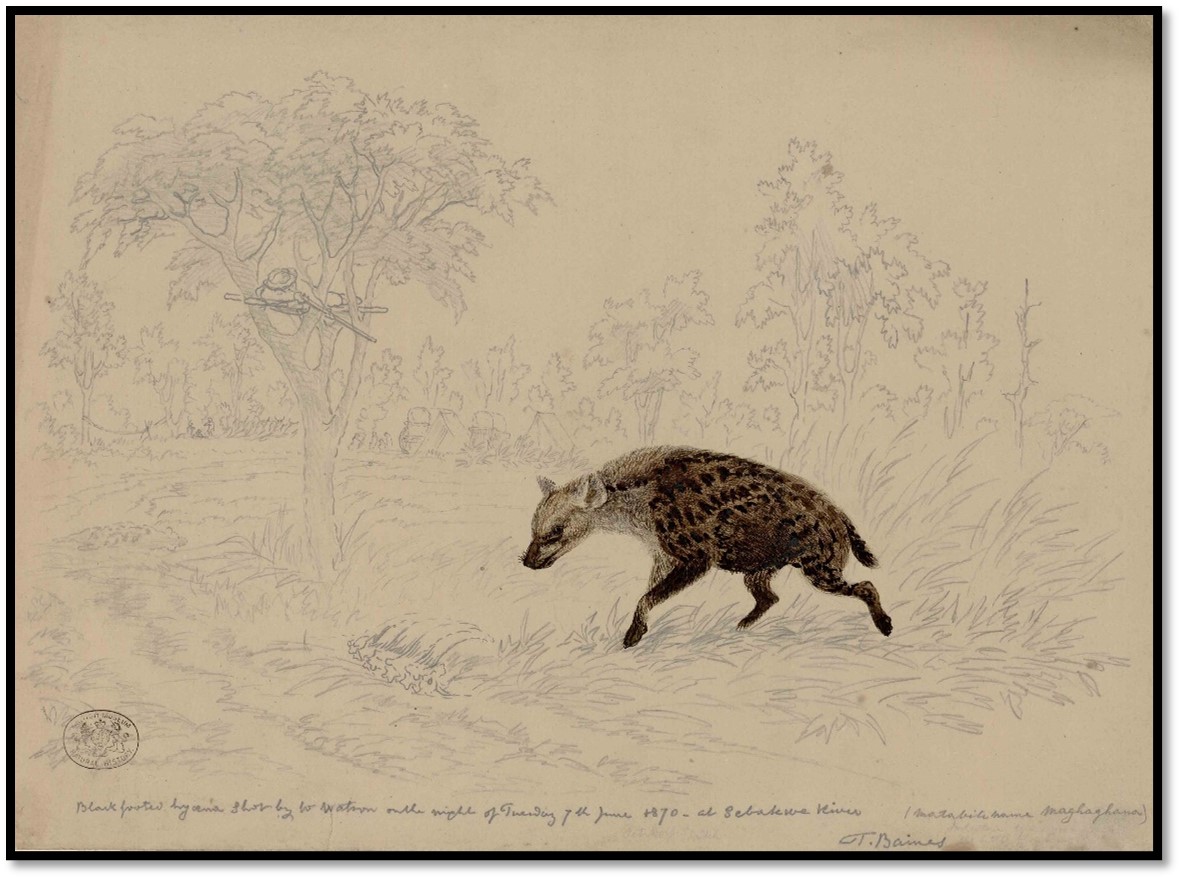
NHM (London) Baines Collection No 94: lack-footed Hyena shot by Watson at the Sebakwe river
To distract the men’s thoughts Baines left Jewell with Charley and the herdsmen to guard the camp and taking Watson, Mackenzie, Inyassi, John Vrei and half a dozen servants went north with the men in open order. A zebra got away, next a sable antelope was wounded but escaped. Then a roan antelope was seen, but Umfundusi ran in front of Baines and spoilt the shot and a wolf [leopard] was tracked into a kopje but not seen. Finally a bee’s nest was removed from an ant-hill, most of them getting well stung during the process.
9-June The drivers cut up the second buffalo skin for reims. The herder Booi reported buffalo at the river. Watson set a trap gun and shot a jackal.
10-June Baines sketched the jackal with a good description and measurements and then walked about 10 miles to the south-east getting long shots at a wildebeest and some eland, but without a kill.
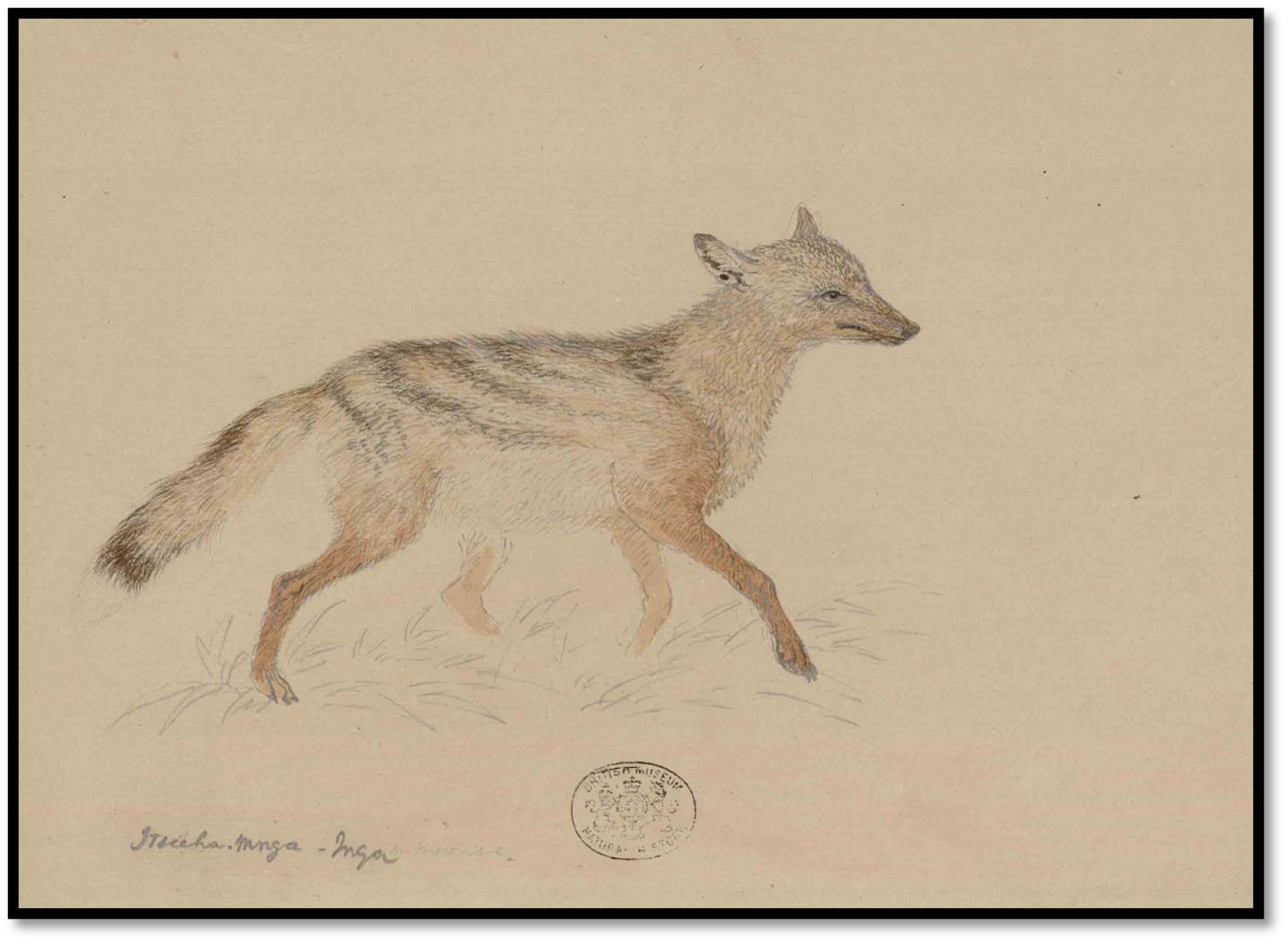
NHM (London) Baines Collection No 95: Side-striped Jackal (Lupulella adustus)
11-June Watson’s trap gun wounded another jackal.
12-June Watson shot a large brown vulture[xxiv] with naked head, pink and bluish skin and wattles under the throat, the wing span between 8-9 feet. Baines shot and sketched the same species at Lake Ngami. A lively scene at the fire that night…everyone busy or singing.
13-June Struck the tents, packed the wagons, left a notice for Nelson following behind. Wounded a zebra, outspanned at the Ndhlovu or Mghoba (elephant) river having trekked 7 miles.
14-June Crossed a second rivulet, hit a zebra in a small herd, but it did not fall and later wounded an eland that sprang forward but did not fall.
Crossed the Umnyati (Umniati, present-day Munyati) and camped. Charley given a mustard plaster and tot of Cape brandy for neck pains.
15-June First trekked to the Umgesi [Ngezi] river and with the crossing at the drift with its broken rocky bed some medicine bottles were broken. When they inspanned again Baines walked ahead and crossed the Umgesana (little Umgesi) [Gwazana?] near the skull and bleached bones of a rhino shot last year by Henry Hartley. This was too short a trek, Inyassi said there was water ahead, but their afternoon trek turned out to be over 12 miles.
Mackenzie with the leading wagon left the road and took a short cut across the spruit where the channel looked 18 inches deep but was in fact double that. The fore wheels made it over but the back wheels stuck deep in mud and his span could not move the wagon even after soil and grass had been dug away. The wagon was double-spanned but under the effort every spoke in the near fore wheel gave way, some splintering. The wagon would have to stay in the stream overnight, it was too late to make a kraal so the trek-touw was secured between trees and the oxen tied to it. Baines believed it would take 3 days to repair the damages.
16-June At sunrise the men cut a pole for a lever and a fork to lift the wagon and the fore wheel was removed and substituted with that from Jewell’s wagon so they could take the lightened wagon out of the stream to a convenient spot. Then the wheel spokes needed replacing. There was plenty of wood – mopane and kondjie, both hard and tough and straight grained. Cutting fresh spokes would have taken a few days as they would need to be seasoned by placing in a water-barrel with hot water, so Baines had Jewell’s disselboom cut into lengths and by evening three spokes had been fashioned. The servants built scherms for the oxen and sheep and goats.
17-June Jewell found a kondjie spar that he is shaping into a new disselboom. Watson and Baines cut the remaining spokes. A common vulture settled on a cow skin, chased all the dogs away and took meat from the hands of Watson and Mackenzie as they had tiffin.
18-June Jewell finished and fitted the new disselboom and Baines completed the spokes and drove them firmly into place.
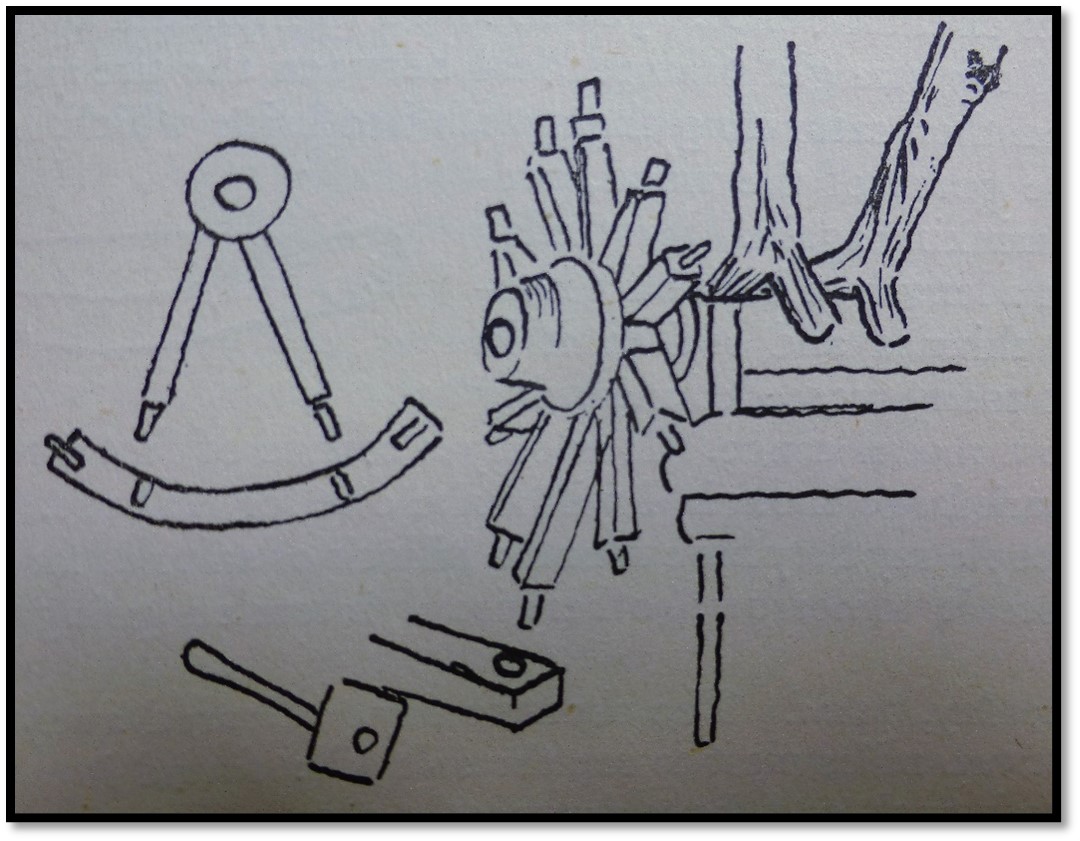
Thomas Baines sketch in his diaries of new spokes on the fore wheel
Watson’s trap gun goes off in the night but only wounds a hyena.
The amaNdebele ‘in defiance of the laws of hospitality’ have killed the common vulture that fed at their table.
Latitude 18° 33´ 36"
20-June Completed the repairs on the fore wheel by putting in the felloe pieces, the originals were not all alike, which made the task longer to complete.
21-June Drove wedges between the iron tyre and felloe all around and then saturated them in hot brine which leaves salt in the pores of the wood and prevents it shrinking again.
22-June Cleared up the camp and trekked 2 miles. Found fresh spoor of buffalo at a salt lick. Smoked out a beehive. Baines sketched a baobab in which there is a cavity that four men could sit in with a fire, but not stand up. There are pegs up the outside where natives have climbed for its ‘cream of tartar’ fruit. Reached the Umgweswie [Umsweswe] river in two channels over broken rocks with large quiet pools above and below. Baines shot some fruit off a Sausage tree (Kigelia pinnata)
Latitude 18° 29´ 07"
23-June The leading wagon went down the steep incline of the bank with the oxen in the second channel. Baines doing a sketch but sitting still for 5 minutes as Jewell took a photograph. He says he has an advantage over the photographer as he can finish his picture another time!
Mud spruit is reached at midday and by evening they have crossed the last spruit before reaching the Umvuli (Umfuli, present-day Mupfure) The servants set some dead trees ablaze in a clump of rocks, the glare of the fire lighting up the landscape showing them collecting and tying the oxen to their yokes, making coffee and meal cakes or ‘leather jackets’ and preparing mutton ribs for supper. During the night the largest tree fell, startling the oxen and causing the men to spring up with their rifles at the ready.
Latitude 18° 21´ 37"
24-June Trekked before daylight but left the road where it turns east for the Zinlundusi [Chirundazi] rivulet and continued north past a picturesque kopje of granite boulders. As they neared the Umvuli (present-day Mupfure) they came across wagon tracks coming from the east down the Chirundazi to the Mupfure drift. Baines was just wading across when Jewell brought the wagons up and the oxen, being in good condition, dragged the wagons across through the broad and heavy sands and across the permanent channel. Made a midday halt under the Paopisa trees (Portuguese name for Sausage tree – Kigelia pinnata) where Watson caught a small puff-adder.
As they headed west it was apparent that a wagon, perhaps George Wood’s, had gone in by the same route and come out again.
From a little gully running down to the Mupfure they saw the first shaft sunk by the miner Arthur Griete for Sir John Swinburne of the London and Limpopo Mining Company, rather more than 30 feet deep but finally abandoned. The wooden shaft props on the sides of the pit in good condition and the platform for the winch still in place, but the winch itself had been moved on west about 500 yards. The little house on the hill was still intact and had not been reached by the veldt-fires. A melon vine had spread itself over the servant’s house and sorghum grain was growing in the forge.
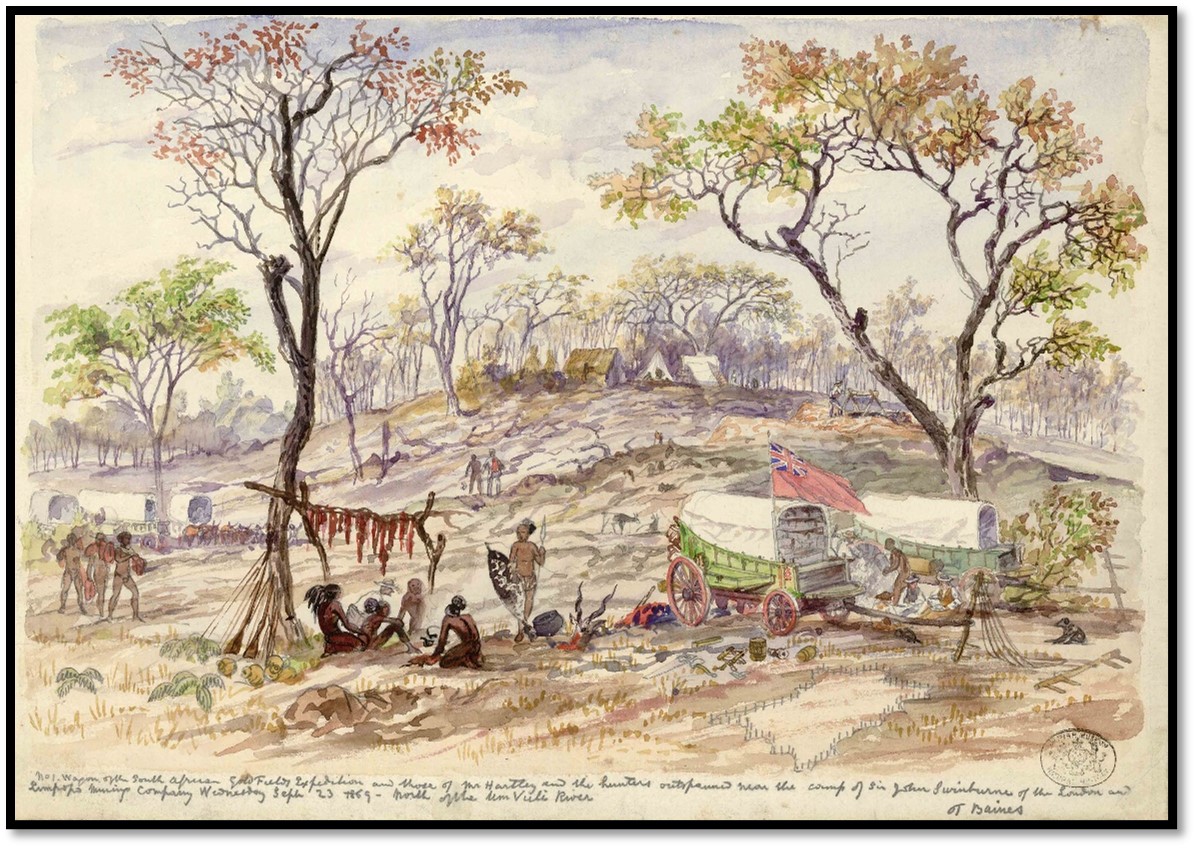
NHM (London) Baines Collection No 26: The wagons of the South African Gold Fields Exploration Company in the foreground, those of Henry Hartley and the hunters on the left, the shaft and house (that subsequently burnt down) built for Sir John Swinburne of the London and Limpopo Mining Company on the rise
In about ¾ of a mile they reached the northern edge of the Hartley Hills and outspanned under the ‘Southern tree’ about 200 yards south of the outspan where they made their Olienhout (wild olive) disselboom the previous year.
Latitude 18° 11´ 39"
25-June Baines sets up his working tent; another is put up for dining and general purposes between the wagons. Baines, Jewell and Inyassi then walk the claim of the South African Gold Fields Exploration Company
Starting at the Off-saddle tree [1] and going south along the line of old Mashona workings. Having reached the Mopane and Mpondo trees [2] they walk south east to an ant-hill where Baines had found a beautiful orchid the previous year. Then Baines asked Inyassi for the Impassa tree, but he had forgotten and Baines used his diary and took bearings and found the tree much to the astonishment of the natives. Then turning back they traced the boundary to the north-west angle of the Simbo [Chimbo] rivulet [3] renewing the marks and then turning east back to camp.
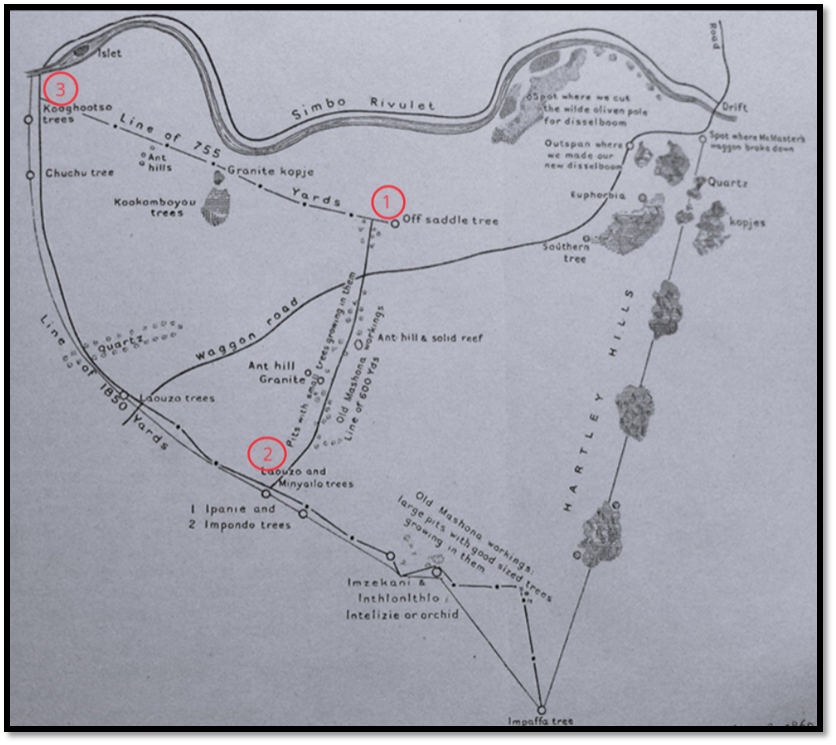
Thomas Baines: The claim area of the South African Gold Fields Exploration Company
Jewell had cut a pole for a topmast and they flew their red Ensign. Inyassi brought yams, Watson made a meat pie and crust. They discuss starting to build a house.
26-June After a bath and Sunday morning service Baines walked to the south of the hill and decided upon a small plateau as the best site for a house. It will have two rooms 14 feet square with a passage in-between 6 feet wide into which the front door opens. Each room to have a window to front and rear with unbleached calico serving as glass. Walls to be 10 feet high, the roof ridge 18 feet high giving the roof a pitch of 45° to throw off heavy showers. Baines does not propose thatch as it will not escape grass fires – Swinburne’s is already burnt down and a frame will be covered with tent-canvas. The wood used will be mopane with stout corner posts and smaller poles in-between and daubed with ant-hill clay and the same for the floor.
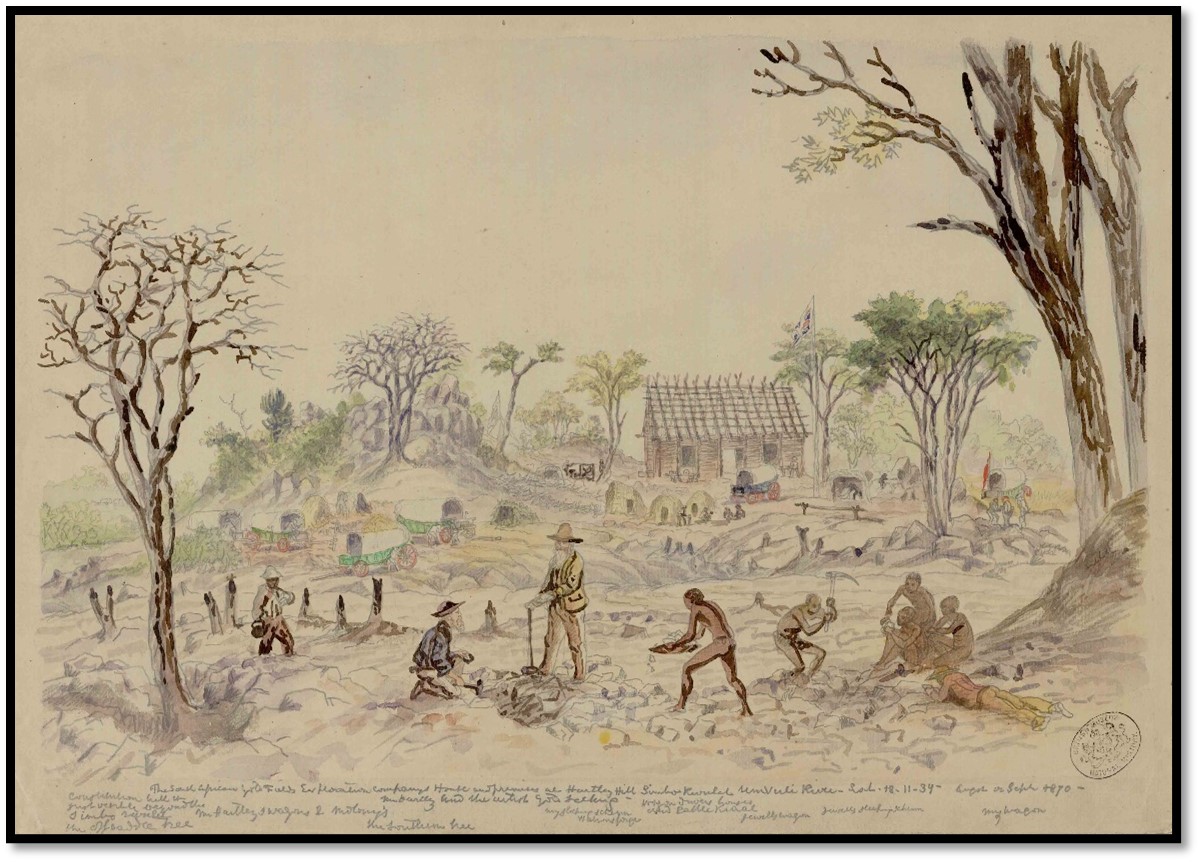
NHM (London) Baines Collection No 46: The South African Gold Fields Exploration Company house partially complete. Wood and Maloney’s green wagons on the left, Robert Jewell’s wagon with the blue body and red wheels in front of the house, Baines wagon with the red ensign on the right. Nelson and Watson breaking quartz in the foreground
27-June Watson, the drivers and servants have gone to cut poles. Baines and Jewell mark out the house with wood pegs and the remaining servants dig holes for the poles. A selection of the felled trees was made, two young oxen inspanned and the logs hauled by trek-touw to the building site. The four stout uprights were set up and then the gable poles, each 20 feet long. Watson shot 3 guinea-fowl they will eat tomorrow and he caught a jackal with a noose lashed to an upspringing sapling.
28-June All hands at work on the house. 12 corner posts and four posts 20 feet high to support the ridge pole are in place.
29-June Umfundusi caught a Bateleur Eagle in a snare, these are reputed to be great medicine by the natives. The frame of the house is taking shape.
30-June The ridge-pole put in place consisting of two 20 feet poles overlapping in the middle for 8 feet. A discussion with Watson concerning the ownership of skins. Baines saying they belonged to the company, but the company would not exercise its right to take them.
July 1870
1-July Baines fixes the rafters to the house while Jewell and Watson attaches battens to hold the poles together. Baines shoots a young ox for meat as he fears that if he goes hunting the house building will come to a standstill.
2 July The remaining rafters for one room are fixed with battens across them. Watson makes some trestle tables. The first veldt-fire seen burning to the north.
3-July Mackenzie brings in a wild-cat, that Charley skins for Baines. The veldt-fires seem to be spreading.
4-July Charley brings in a female wild-cat. Half the rafters for the second room are in place.
5-July Baines works on the roof whilst Jewell and Watson work on the walls. A specimen patch is wattled with clay that proves satisfactory. Tendulo cut his knee severing some tendons. Baines washes the wound and binds it with bandages and tells him to rest.
Baines plans to hunt the next day perhaps for 2-3 days, but while having midday coffee Inyassi reports shots and believes Nelson and Oude Baas Henry Hartley must be arriving. While discussing the news a loud report is heard in the distance and they fire three shots in return. Two horsemen come in, being Thomas Maloney[xxv] and Thomas Leask from their hunting camp on the Chirundazi, about 8 miles to the south-east.
They have sad news. William Hartley has died, also McDonald [James O’Donnell] his driver Toris [Pretorius] and another young boy. George Wood lost his young wife, her child and her mother, Mrs Fraser. Mrs McMaster, the sister of Mrs Wood, is the only surviving lady and she lost her child at Tati. Some of the deaths took place at Thaba Enzimbi [Insimbe – Iron Mine Hill) or the high land 25 miles east of the Umnyati (Umniati, present-day Munyati) drift.[xxvi]
Tendulo’s bandages are renewed in the evening. Watson is offered the option of going down to Natal over the next rainy season and accepts. Nelson wants to prospect to the west where fever is more prevalent.[xxvii] Baines has heard that Paul Jebe has also died of fever.[xxviii]
6-July After an early breakfast Baines sets out with Inyassi for the hunters camp on the Chirundazi. Just before reaching the Mupfure they met a native boy and horse sent by George Wood. They follow the track up the Chirundazi rivulet – not the more westerly track they came in and after a couple of miles saw the seven wagons drawn up abreast of each other. He says there was an air of melancholy at all the recent deaths. George and Swithin Wood and Kennedy were at the camp. Maloney and Giffard [James Gifford] were strong enough to go hunting for meat. Thomas McMaster and Thomas Leask were away on an extended hunt west along the Mupfure after visiting Baines’ camp.
Events and dates were confused, but it appeared that George Wood caught fever at the Munyati river and had gone south-east to Ntaba Insimbe and bought goats and sheep at Umtigesi’s (Umtigesa’s) kraal near the source of the Sabi (present-day Save) river and during the time he was away Mrs Wood, their child and her mother Mrs Fraser died of fever.
Willie Hartley with Maloney had crossed the Mupfure and Hartley Hill to hunt west of the Manyame river until Willie and James O’Donnell caught fever and returned and recrossed the Mupfure river. They met George Wood 20 miles south-east of the present camp and shortly after died along with the wagon-driver Toris (Pretorius)
7-July George Wood lent Baines a horse and together they rode back to the Hartley Hill camp, Wood bringing a tin of butter, salt beef and a 50 lb bag of Mashona rice. Jewell had put in the window frames and Watson had wattled part of it with clay.
8-July Baines goes hunting to the north-west crossing the Simbo (Chimbo) rivulet and 4 miles later the Sarua or Salagozaan ([Saruwe] river at its confluence with the Mupfure where Baines shot a blue or Stanley crane
(Grus paradisea) On the river itself a group of fifteen waterbuck are spotted, but Baines’ percussion cap misfired and Inyassi missed. A rhino was also seen on the other side of the river, but soon disappeared. Later in the afternoon Baines had taken off his shoes to shake out the sand when a sable antelope bounded by, Inyassi missed and the animal was gone when Golube handed over Baines’ gun. At sunset they collected grass for beds, made a scherm and roasted the crane for supper.
9-July they took a north-east course and reached the headwaters of the Saruwe river before turning south. Fired a shot at tsessebe 200 yards away and heard the bullet strike, but it escaped. They heard gunfire, that proved to be Jewell and Maloney. George Wood and the hunters had moved their camp north of the Chimbo and welcomed Baines with a cup of tea.
On reaching his own camp found that Maloney had brought his and Willie Hartley’s wagons and outspanned close beside theirs.
10-July They received visits at Hartley Hill from the Wood party who are slowly recovering. They are flying the red Ensign at half-mast in memory of those departed.
11-July Baines visits the hunters’ camp. Thomas Leask has broken a tyre on one of the after-wheels of his wagon and wants Watson to fix it by bolting or riveting a plate over the break as they do not have a forge to weld it. At present they have some rhino hide wrapped around the tyre that Baines believes will tighten and avoid the necessity of welding, but Leask fears otherwise.
Watson’s new hyena trap has a copper wire around the bait that when disturbed sets off the trigger.
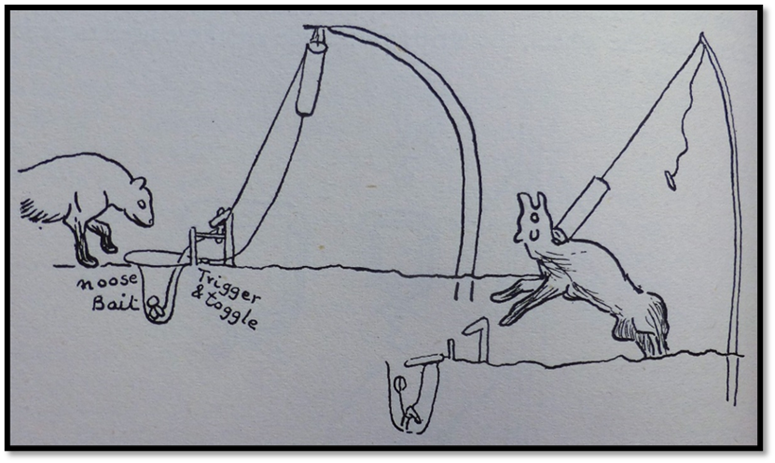
Baines illustration of Watson’s hyena and jackal traps
Once sprung a heavy piece of wood bored lengthways runs down the noose line and tightens the noose.
12-July Busy unloading the wagon and transferring stores to the house. Nearly all the hunters except Leask, Kennedy and Swithin Wood have been out hunting, but game seems scarce. Baines decides to take his and Willie Hartley’s wagon to Umtigesa’s kraal in the south-east to barter sheep and goats and sorghum and writes a letter to Watson with instructions and leaves him in charge. Another letter, also headed Hartley Hill, Simbo river, Latitude 18° 11´ 39", 12 July 1870 is for Nelson giving information on quartz reefs seen and saying the house is nearly complete and if he goes prospecting to leave a note on the direction and days he will be away.
13-July Baines says goodbye, Mrs McMaster has baked a loaf of bread. He leaves the house at 12:20pm reaching the Mupfure drift at 1:50pm and arrived at the now abandoned hunters camp at 4:30pm, a distance of 9 miles from the drift. A grass hut caught fire from the unattended camp fire and had to be beaten out before it spread.
Latitude 18° 37´ 49"
17-July A rest day, Baines mapping.
18-July Frost on the ground, crossed a stream from the east, probably a tributary of the Munyati and had a view of Ntaba Insimbe or Iron Mine Hill. In the afternoon fired a shot at a sable antelope after running ½ mile, but his hands were unsteady and the animal escaped. Crossed another spruit of the Munyati. Now on top of the watershed with Ntaba Insimbe to the north-west and crossed a tributary of the Sabi (present-day Save) on their right.
Latitude 18° 44´ 10"
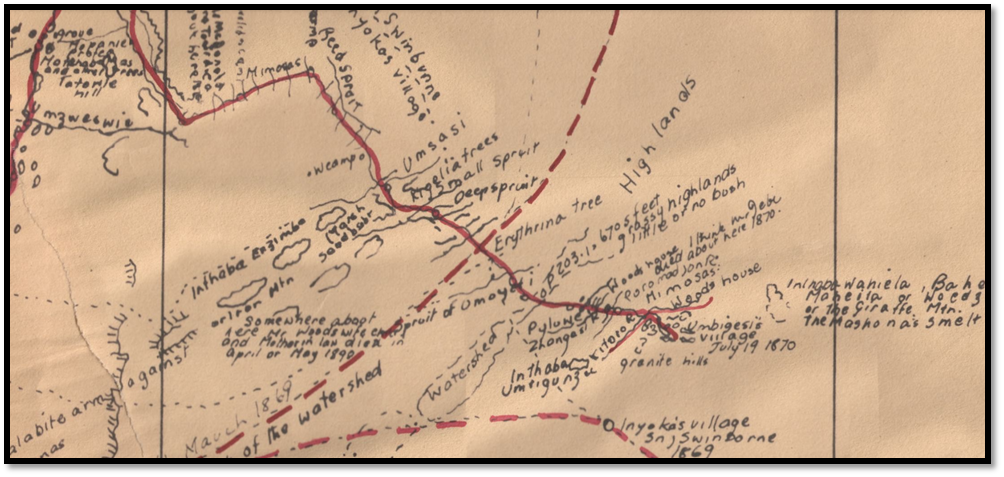
Thomas Baines map: https://exhibits.stanford.edu/maps-of-africa/catalog/pn565rk5366
Baines writes there is a strong wind from the south-east, it is cold and his map states there is little or no bush. [Many later travellers[xxix] state the same for the route to Fort Charter from the south]
19-July Trekking south of east down a valley with streams flowing to the Save river. They pass the scorched posts of a square house, probably erected by George Wood and small kopjes with grain huts on the summits. In the afternoon met 20-30 Mashona with war-axes and spears. Inyassi explained they were wanting to trade and some turned back as guides, the remainder went on to meet the wagons. Presently they wanted to stop and said they would bring goats but Baines said he wanted to meet their chief. They crossed the Kootooroo river, a tributary of the Save, with Ntaba Maheela in front of them [this must be Wedza or Hwedza Mountain]
Most of the kraals are situated in kopjes in the best defensive positions against marauding parties of amaNdebele with the smaller huts, that serve as granaries, perched on isolated boulders and very difficult of access. Baines describes their clay or dhaka foundations and says the weathered thatched roofs hide them very effectively. Drums beat at their approach and the people came to meet them understanding their arrival was peaceful.
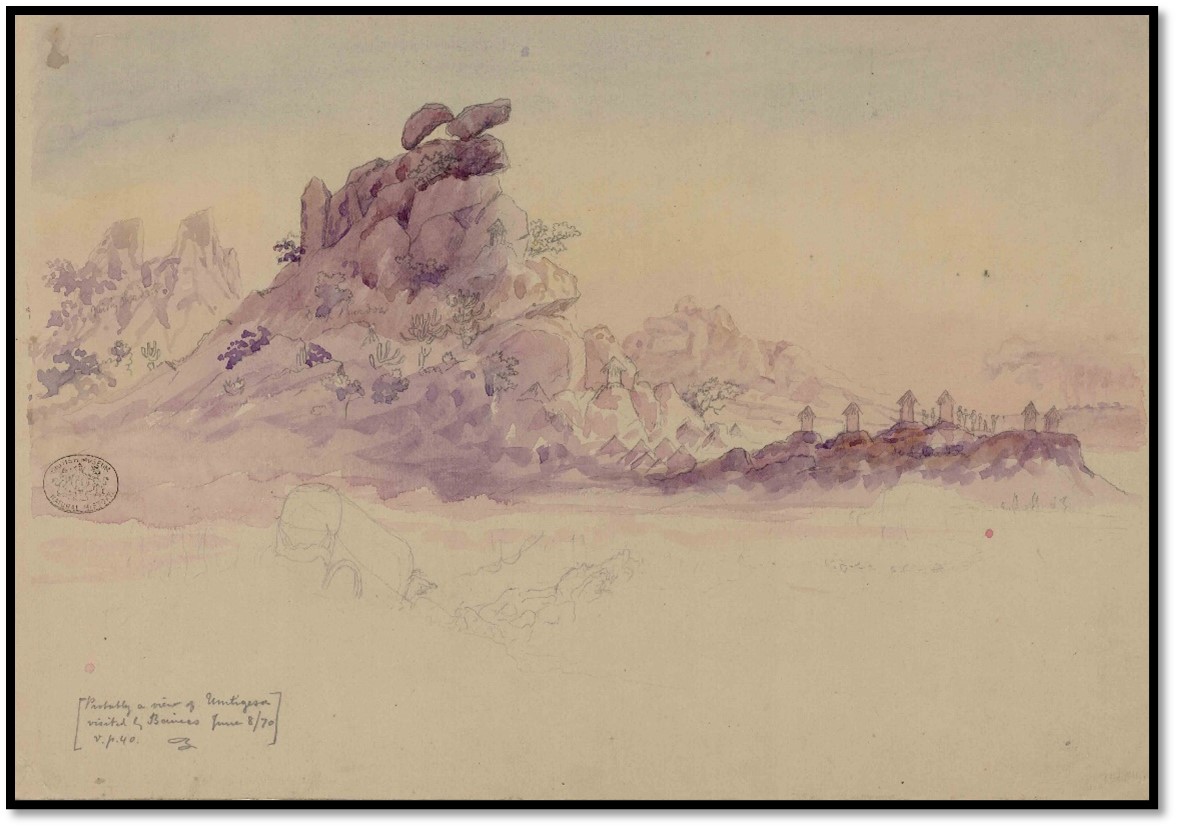
NHM (London) Baines Collection No 38: approaching Umtigesa’s village on Kootooroo, a tributary of the Save river
Soon they were shown the road that George [George Wood and party] had taken and his house on a kopje and they halted the wagon in the lee of a kopje and not far from the gorge where chief Umtigesa had his village. Mackenzie and Inyassi went to meet the chief whilst the others prepared the camp.
The chief sent down a basket of sorghum and mathambana (ground nuts) as a present and shortly after came down accompanied by about 50 companions. Baines writes that that they excel in working in iron dug from Hwedza Mountain including spear blades, war axes, hoes and knobkerries, made of iron. Armlets and anklets are skilfully made. The chief had two musicians playing mbiras or African pianos.
Baines visited Umtigesa he found the living pole and dhaka huts adjacent to the sheep and cattle kraals and that the chief’s hut had a wooden door on hinges.
20-July The chief visited early in the morning and was given coffee and a share of breakfast, he had brought fresh milk and a basket of rice for which he asked for umgasi beads (red with a white eye) This opened the proceedings for trading. Men and women with baskets of grain, meal and ground nuts bargained at the top of their voices. Prices for goats were higher than in Matabeleland and when the chief brought animals and gave an exorbitant price had to be asked plainly if he was making a present or driving a bargain.
The chief sat at Baines’ fire and if the crowd pressed too close got on the wagon and cleared them away.
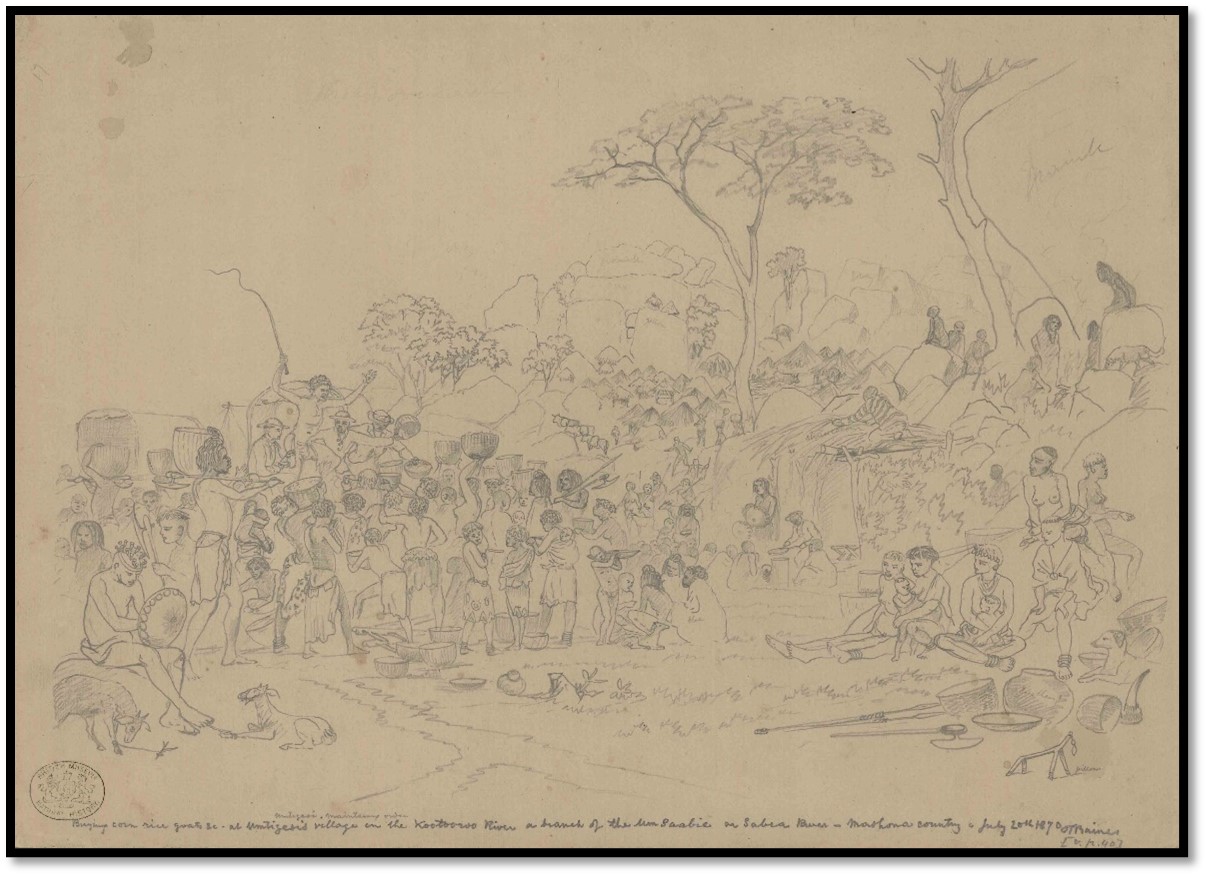
NHM (London) Baines Collection No 40: Buying goats and corn at Umtigesa’s village on 20 July 1870
21-July A dense white mist settled until midday when it was burned away by the sun. Their camp ground was the scene of much noise and bustle again and they begin to barter sheep and goats for brass wire, but for pack-oxen the Mashona wanted guns. Two belonging to the chief were bought for a Potts gun converted from flintlock to percussion cap, then another four muskets for about 20 sheep and goats and a couple of calves.
Chief Umtigesa celebrated his acquisition by holding his gun and dancing amid the applauding shouts of his people. Then he asked Baines to play his accordion and soon several hundred people were listening to the music with utmost attention.
Latitude 18° 48´ 03"
22-July Baines watches a Mashona smith making an iron hammer head 4 inches long x 3 inches wide x 1½ inches thick from a lump of iron ore that has been heated up in a clay furnace with a blast of air from goat-skin bellows connected to the furnace by clay tuyeres. The working of the bellows keeps up a continuous blast of air that makes the charcoal fire hot enough to soften the native iron ore from Hwedza Mountain. .
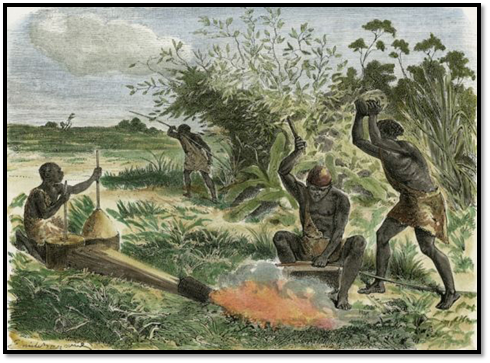
British Museum: Mashona smiths at work at a smelter site making iron tools
Baines writes that wire-drawing is accomplished by beating the molten iron as thin as possible and then hauling it through a hole in a block of wood. He says that nobody in Umtigesa’s village worked in gold and they appeared to have no knowledge on the subject.
In the afternoon chief Umtigesa himself came for some shooting lessons. Jewell had increased their flock of sheep and goats to 44 and took photos of the village and their camp.
23-July The smith finished the hammer-head for which Umtigesa was given beads, Jewell bought bows and arrows and spears. Two missing oxen were found by Umtigesa’s men, and as gifts was given a white blanket; Umtigesa’s interpreter was given a shirt. More than a hundred of Umtigesa’s people accompanied the wagons for some miles.
24-July A restless night as the trek oxen kept breaking out of their kraal. An ox was purchased for three pairs of brass amulets. One tribesman had a hakata set or divining bones[xxx] and Inyassi paid to learn how his wives, children and cattle were in Matabeleland.
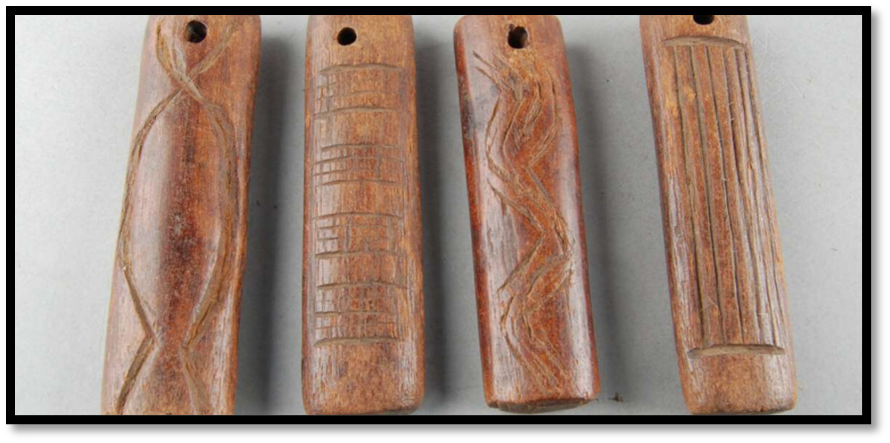
British Museum: Wooden Mashona divining tablets with different patterns
25-July Jewell shot the little black ox because it had proved too wild to train. They recrossed the watershed, but the views were obscured by the smoke from grass fires and outspanned on a tributary of the Umnyati (Munyati) A cold south-east wind as reported by many travellers, the oxen breaking away again.
26-July Found the fresh spoor of lion, probably the cause of the oxen’s alarm in the night.
27-July Frost on the ground when they inspanned. Golube reluctant to carry Baines across the Umgesi (Ngezi) that Baines writes is a stream “just too wide to jump and not worth the delay of taking off my shoes and socks to wade.” [this is probably near the old Charter Estate buildings] He spots a Sausage tree (Kigelia pinnata) near a Coral tree (Erythrina caffra) and says he has seen them both from this elevation of 3,633 feet down to sea level at the Zambesi river mouth.
In the afternoon Golube catches sight of Nyamazana (wildlife) and Baines shoots a roan antelope that proves a disappointment to the natives as it is very old and in poor condition. Despite this it is soon cut up and hanging from the wagon, again a cold blustery south east wind.
28-July A long hard pull through the sand, again much commented upon by later travellers, until they came upon Thomas Leask’s track from the north. Baines says he lights a fire on the old kraal at the tributary of the Umsweswe to guide the men and wagon into camp. They are obliged to kill some of the knocked-up goats and with the roan antelope there is a lot of meat. His feet are sore after walking 14½ miles through the sand.
That night the oxen are once again disturbed, a cry of pain from one and a shot from Mackenzie followed by the angry growling of a lion. Jewell and Baines put their shoes on and went out followed by servants with fire-brands and found Roman, one of the best oxen bought from Lee, chewed by the near elbow and clawed by the shoulder and flank and thigh, but apparently otherwise unharmed.
The lion prowled about, the servants built a new fire at the rear of the wagons using logs from abandoned huts, the dogs barking and rushing about and by 3am the lions moved away, their sounds getting fainter.
29-July Another frost on the ground with the camp sleeping in a little later than usual. About 2pm they reached the old camp [at the headwaters of the Chirundazi rivulet] but cannot find Willie Hartley’s grave where it is supposed to be despite a search. A short halt is made with the loose oxen and goats being sent on ahead, the wagons following when Macushlumba runs back to say a lion has taken one of the oxen. Baines and Inyassi push ahead and finds the oxen safe, except for the large red ox that has been slightly clawed.
Apparently the male lion had lain in wait in the long grass, but the large red ox, Roman broke free, actually trampling the lion and all hands now volunteered to hunt him. Charley and John Loantley were ordered to drive the wagons slowly, Macushlumba, Golube and Solomon to watch the flock and herd, Baines, Jewell and Mackenzie to hunt the lion with the dogs, but soon walking parallel with the wagons.
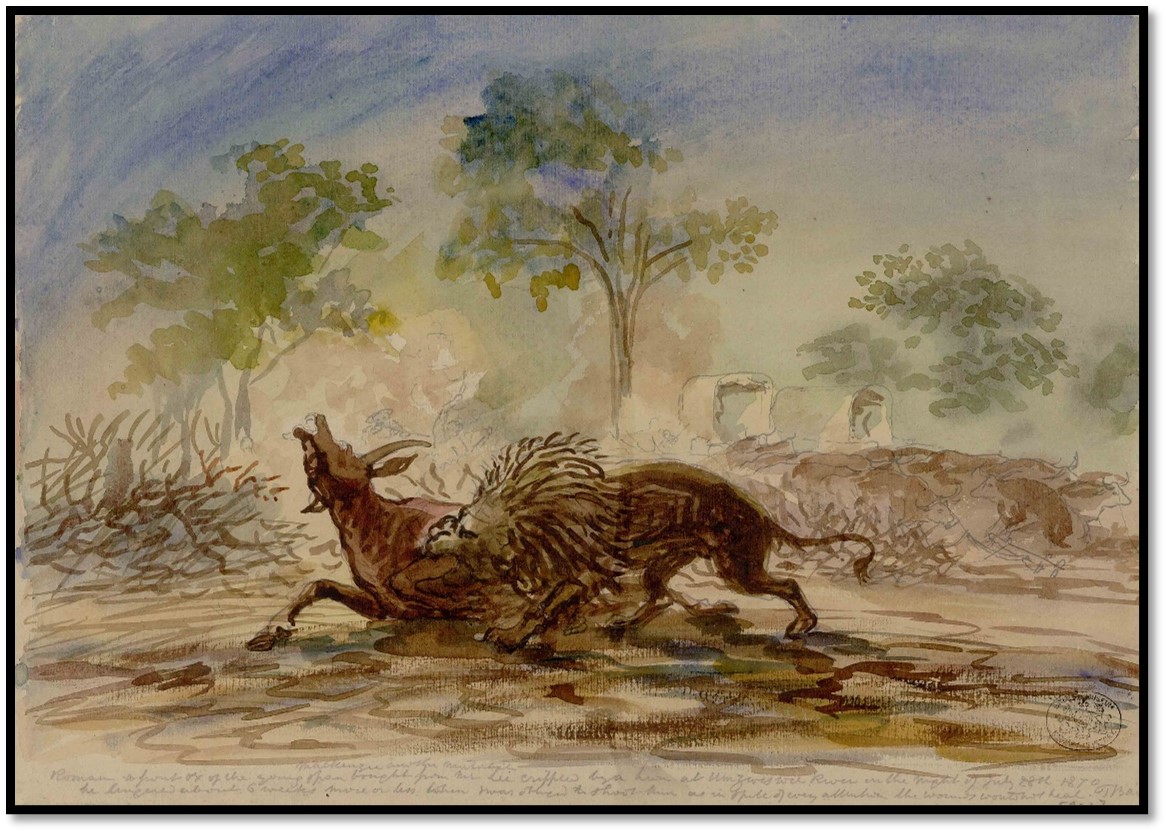
NHM (London) Baines Collection No 86: Roman the ox being mauled by a lion at the Umsweswe river on 28 July 1870
At sunset the wagons were drawn up close to each other, a scherm was made for the flock, the oxen brought in after a feed and tied to the trek-touw and fires lit. All prepared themselves for another lion attack, but none came and even the dogs were silent.
30-July An early morning trek brought the wagons to the deserted hunters camp on the Zinlundusi (Chirundazi) with Baines keeping close watch during the night trek. No new wagon tracks at the Umvuli (Mupfure) drift indicated that Nelson’s wagon had not yet arrived and everything was found ship-shape on reaching the house at Hartley Hill. Watson has cut red Milkwood trees to make wheel spokes and replace other parts of the wagon, the hunters have left for the Ganyana (Manyame) river. The Jennings brothers have returned from a hunt and are camped north of the Simbo (Chimbo) stream, Baines is sorry to learn that their companion MacGillivray [Henry McGillewie] has died of fever and is buried near the Sarua or Salagozaan [Serui] river.
31-July The space around the house built for Sir John Swinburne is cleared and Baines puts up his tent behind the house…he says there is just enough flat ground between the boulders to build a little one-bedroomed house for himself. The Jennings bothers visit and they go to look at the 15ft crocodile Watson shot in the Mupfure the day before at the confluence of the Umfuli (Mupfure) river and the Simbo (Chimbo) rivulet. Lions have been spotted about 300 yards from camp.
August 1870
1-Aug Baines sent Mackenzie and an ox span to haul in the timbers Watson has cut. Golube and Macushlumba build a small sleeping hut for Baines near the cattle kraal. Baines borrows two of Jewell’s copper boxes and lashes two poles to the handles and two poles underneath and seating himself in the middle paddles over to the crocodile and tied a line to it and had the carcase hauled ashore. He then sketches the animal and offers Inyassi a shirt for skinning it, but he would not, saying the king would kill him. Baines would like to take the skin, but there is too much fear, the liver believed to be tagati (witchcraft) and supposed to cause death at the will of its possessor. A long description taking several pages features in his diaries.

Baines sketch of his ‘slow canoe’ to retrieve the crocodile carcase from the Umvuli (Umfuli / Mupfure)
2-Aug The servants are finishing wattling the house with clay. Baines made a careful sketch of the crocodile’s head and then started cutting spokes for the wheel of Jewell’s wagon.
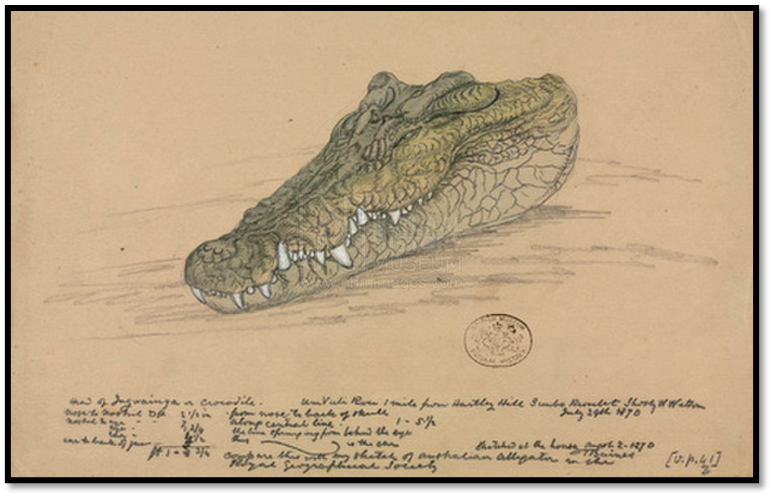
NHM (London) Baines Collection No 150: crocodile head from the Umvuli (Mupfure) river shot by Watson
3-Aug Wattling of the house continued. Baines refits the spokes in the wagon wheel and Jewell is developing photos. The Jennings brothers have gone east up the Umvuli (Mupfure) river.
4-Aug Charley and Baines bind up the wheel of Jewell’s wagon with raw hides. The servants working rather slowly on the house; Inyassi questioned Baines activities with Baines replying that the king had given him general leave to seek gold, to build houses and put up machinery and that he could go in any direction that he chose. Inyassi said he did not know about the gold, but if Baines went into the fly country where the Mashona dug for gold (Lomagundi, present-day Makonde) he would leave and go back to Matabeleland and all the others would go too. Baines replied that anybody who ran away would forfeit their pay.
In the evening the wagon drivers and voorloopers (leaders) came asking when Baines intended to return to Matabeleland. Baines told them he would go to Inyati before the rainy season, perhaps to Mangwe or Tati or even Natal. At that time they could either ask for their discharge or remain with the company.
5-Aug Some native hunters who have been in the fly country for a fortnight to shoot for Leask came back with nothing to show. Elephants are scarce, hippo so shy they cannot be found.
6-Aug The servants are beating skins, for voorslags.[xxxi] Roman the ox wounded by the lion has his wounds treated. Baines puts spokes in the other fore wheel of Jewell’s wagon and ties it up with raw hide.
8-Aug Baines cuts up timber for an axle-bed. He prepares to travel downstream on the Mupfure. In the evening Leask returns from the Ganyana (Manyame) river. They hear reports that Lobengula has attacked the Zwangendaba regiment.
9-Aug Arranged loads on four pack oxen, including blankets and equipment. These are put in sacks and balanced pannier-wise on their backs.
Baines visits a quartz reef with Mashona gold workings 3-4 miles from the house in the form of a large excavation. The air was thick with smoke from grass fires and they dashed through the thinnest part of the advancing flames and reached the blackened burnt ground. Fired at a waterbuck but the sights were set too high. Later fired at another waterbuck (Kobus ellipsiprymnus) at about 200 yards range and heard the bullet strike, the animal ran off but fell into a pool by the river and was killed with a second shot. Baines gives a good description of its size and colours. He had intended to camp about 2 miles further on at the edge of the tsetse-fly belt, but the buck needed cutting up, so they made a scherm on the riverbank for the night.
10-Aug During the night Baines’ blanket suffered large burnt holes from the fire. Charley and others were sent back to Jewell at the house with a pack-ox loaded with meat. Baines and his men followed a honey bird in a loop that ended back at the Mupfure river but do not seem to have found a bee’s nest. In following some cranes they came across a warthog (Phacochoerus africanus) that Baines shot.
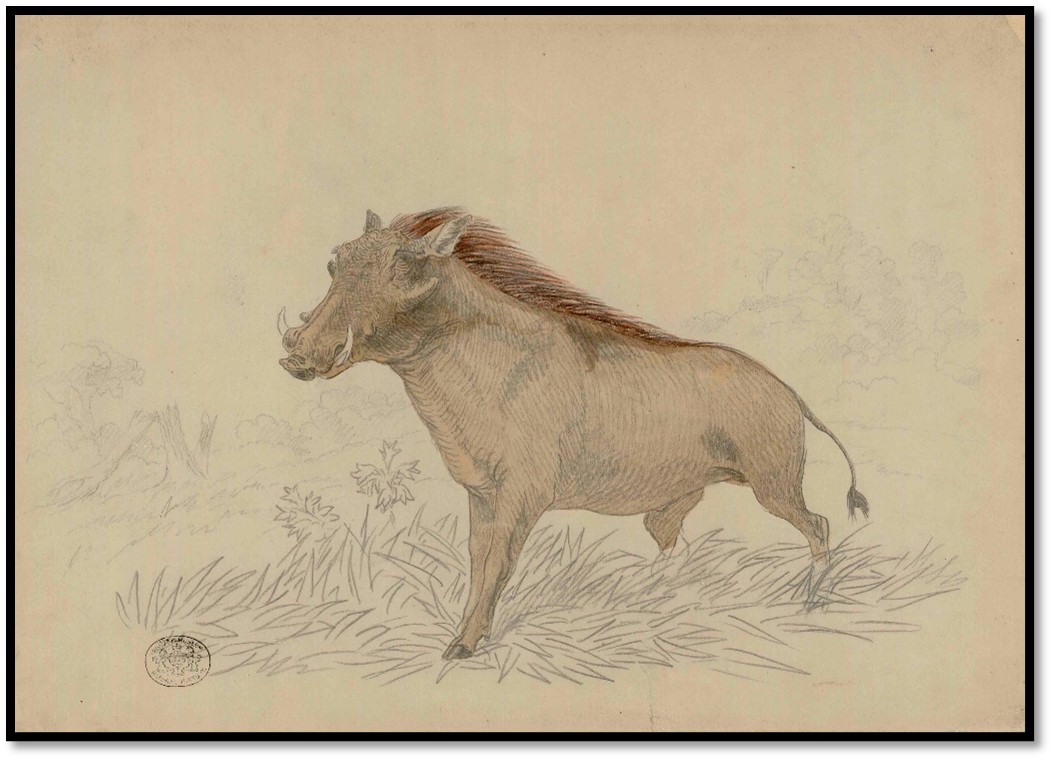
NHM (London) Baines Collection No 127: Warthog (Phacochoerus africanus)
The carcase was sketched and measured before being cut up. In the afternoon he coloured in the sketch and had a bath in the Umvuli (Mupfure) river.
11-Aug About 7am they heard a heavy gun and a few hours later Jewell appeared having wounded a waterbuck. Once the warthog flesh had been smoked it was loaded onto the pack ox named Umtigesi and the party travelled to the north-west. A number of quartz reefs and old workings were passed as they journeyed. Baines describes the river as 100 yards in width with banks 20 feet high and lined with Sausage trees[xxxii] (Kigelia pinnata) and Coral trees (Erythrina caffra)
12-Aug They are travelling on the east side of the river in a north-east direction until a tsetse-fly was identified when they turned back 1½ miles to a camping spot under a fine Sausage tree with a 14 ft trunk.
13-Aug Charley, John Loantley and Umfundusi are left with the horse and told to go back if they encounter any more tsetse-fly. Baines and Jewell with the others follow the river in a northerly direction until they arrive at a long reach with deeper water and wooded banks and keep a lookout for zeekoes (hippo) They come across the carcase of an elephant shot by Leask’s men that has drawn hundreds of vultures and 2-3 miles further on stop at a pool where Jacob saw a hippo.
After waiting patiently, a hippo makes an appearance and Jewell makes a good shot followed by others as the hippo surfaces to breathe. A crocodile was also seen, but the shots have made all the animals extremely shy and they are not seen again. Dinner is coffee, bread and mashambana (ground nuts) as all the warthog is finished.
14-Aug They continue walking alongside the river with a succession of rapids making progress more difficult and passing several quartz reefs before returning to the previous day’s pool for signs of a floating hippo carcase. Nothing is seen however and they return down the river towards camp taking shortcuts to avoid the windings of the river. Quartz reefs are passed with extensive groups of Mashona diggings, one was 10 feet deep with a tree growing from it.
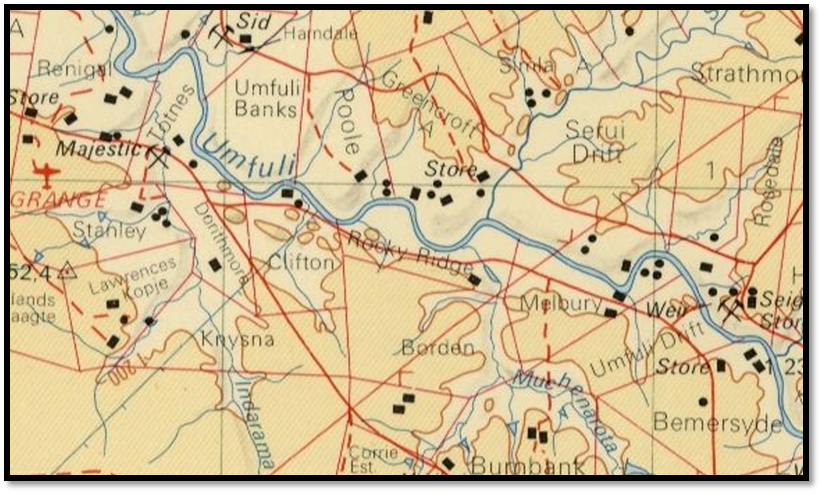
Map section from 1:250,000 map sheet SE-36-9 Hartley; this map is used with consent from Window on Rhodesia with the site name: https://www.rhodesia.me.uk The Umfuli (present-day Mupfure) traced for approximately 20 km NW from Hartley Hills
In the meantime Charley and his companions had returned to their Hartley Hills camp.
15-Aug The party return on a south-east course sometimes on the river bank and sometimes at a distance from its windings. Jewell spots a fine quartz reef about 10 inches wide in the bed of a rivulet. Shortly after Mackenzie shoots a waterbuck. Baines gives description and dimensions. Baines states that this trip has revealed new Mashona gold workings and quartz reefs that look as promising as those at Hartley Hill. Jewell photographs the return of the pack oxen.
16-Aug Charley is ill with fever and given two of Dr Coverley’s pills. Baines cut some spokes for the hind wagon wheels and cleans Roman the ox’s wound that is gradually getting better. Watson is working on the axle-bed, Mackenzie is cleaning wagon gear.
18-Aug Spokes are fitted to both hind wheels of Jewell’s wagon and lashed with raw hide. Baines is thinking of going west and meeting the wagons at the Umnyati (Munyati) drift. One of the Jennings brothers returns from the upper drift of the Mupfure and Henry Byles returned from a lone journey to the Manyame.[xxxiii]
19-Aug Henry Byles tells Baines about his journey from the Manyame to the headwaters of the Imbeela river that he says is ‘broken and quartzose and, in his opinion, likely to be auriferous’ before then crossing the upper Serui and down the Chimbo spruit. Then Byles leaves for the Hartley drift on the Mupfure, about 1½ hours or 5 miles away. A fierce fire on the Chimbo rivulet today, Baines rides over to Leask’s wagon to check that it is safe, which it is, as the grass had been previously burnt all around it.
20-Aug Two or three lions around most of the night keeping the dogs in full chorus. A note from Jennings and Byles saying Henry Hartley is not far off and that Lobengula had defeated the Zwangendaba regiment. Hartley arrived in the afternoon with two wagons and outspanned 200 yards from the house. It was a pleasure to meet him again although he was very saddened by the loss of his favourite son, Willie.
Nelson was supposed to have returned with Henry Hartley, but nothing had been heard from him since he went down through Potchefstroom. There was a letter from Edwin Oliver, the London secretary to the South African Gold Fields Exploration Company stating how pleased they were with Baines’ dealings with the chiefs.
A letter also from Sam Edwards saying that Matjen refused to give up the two guns he had taken from Nelson. Baines will inform Lobengula who he knows is annoyed at Matjen blackmailing travellers to Matabeleland.
Baines wants to go with Hartley to see all the quartz reefs he knows including the Portuguese house near the Quartz Mountain. Hartley has advised the king to fix a tariff of (say) £1 for each gold digger and £100 for each crushing machine that he thinks will be better than relying on an uncertain system of presents.
Hartley says the king acted with great patience against the rebels and tried to avoid conflict. But his offers of amnesty were treated with contempt and he was insulted with gross and indecent gestures even by the women and girls. There were numerous charges against the Zwangendaba kraal entrances that were repulsed by heavy firing, but the third assault broke in. About 300 of the king’s men were killed and the defeat amongst the rebels was dreadful. Umnyakangya, their former guide was killed, as was Umbeko. Ncumbata was there and his son Umthlabba took part in the fighting. Once the fighting stopped Lobengula forgave the rebels and told them what kraal to go to. Daniel Kisch and George Phillips were not allowed at the battle but tended many of the wounded later.
21-Aug Hartley came to breakfast and stayed the day to catch up with the news.
22-Aug Hartley wants to meet his son-in-law Thomas Maloney and Baines agrees to go with him and see the Portuguese house, Jewell also pleads to come. From Hartley’s surplus stores they buy meal, 100 lbs of coffee, 100 lbs of sugar, some steel bars, shovels and picks at a very reasonable price plus two horses at £45 each, both being guaranteed against horse-sickness. Baines gives a bill on Behrens, the company agent at Durban.
Baines shot the red Mashona ox as it could not be handled and the skin could be used for storing the quartz samples.
23-Aug Maloney, Leask and the other hunters arrive at camp from the Manyame river having been successful in getting ivory. Hartley and Baines look for payable quarts near the ‘off-saddle tree’ on the company’s claim.
24-Aug Baines goes to the old Mashona workings 150 yards south of the wagon road and collects quartz specimens. Thomas Leask brought over a wheel with a broken tyre for Watson to fix at his forge.
25-Aug The tyre is put back on the wheel, Hartley having welded the band as in his younger days he was a blacksmith. Hartley has aqua fortis (nitric acid) and they test some of the quartz specimens for gold, some of the metallic specks on their specimens testing positive.
26-Aug Thomas Leask said he would guide Henry Hartley to his son Willie’s grave, Jewell will take a photo and Baines his sketch book. A mile after passing Swinburne’s diggings they cross elephant spoor, Leask rides back to camp to call Gifford, whilst Hartley, Maloney, Jewell and Baines follow the spoor and trail of broken matchabeela (Msasa – Brachystegia spiciformis) branches. Hartley and Gifford point out Mashona gold workings and in a group of kopjes covered with euphorbia and aloes are quartz veins.
They off-saddle for 20 minutes before reaching the Umvuli (Mupfure) drift where they counted the spoor of eleven bulls crossing and going to the south-east.[xxxiv] Another break is taken for some salted eland beef Hartley has brought with him. They continue for another hour on horseback before Leask ‘intimated quietly’ to Baines and Jewell that Willie’s grave was off to the left. Soon after they crossed the Zinlundusi (Chirundazi) rivulet. They had ridden from 7:30am to 4pm and all were tired and thinking of off-saddling when Leask said quietly; “There they are!” and there were 3 bull elephants. To their right across an open valley were 5 more.
‘Oude Baas’ Hartley took the lead, Jewell and Baines fell back to let the hunters including Leask and Maloney lead the way. When they emerged from tall grass they saw the small herd in full flight. The hunters started line abreast and began to chase. Baines writes his horse took full advantage and would not be checked…his hat came off and being blinded by it, he lost hold of his gun! Then his horse collided with that of Klaas, Hartley’s servant, a tree caught and tore off his off-stirrup, at the same time dragging his saddle off. Fortunately Baines held onto the bridle and the horse came to a stop. He righted the saddle, collected his stirrup and remounted and kept better control over the horse now.
When Baines rode on he saw ‘Oude Baas’ chasing and firing at his elephant, but by the time he crossed the valley the others were out of sight, but shots could be heard and he followed their sounds. But he becomes quite lost for a while and lets the horse take its own course until he hears shots fired close-by and comes across Leask and Maloney and they ride together until joined by the others. 5 elephants have been killed of which ‘Oude Baas’ killed 2, Leask, Maloney and Gifford having killed 1 each.
They then rode west until reaching the track that followed the Chirundazi at Mud spruit where a scherm was built, dinner eaten and where they spent the night.
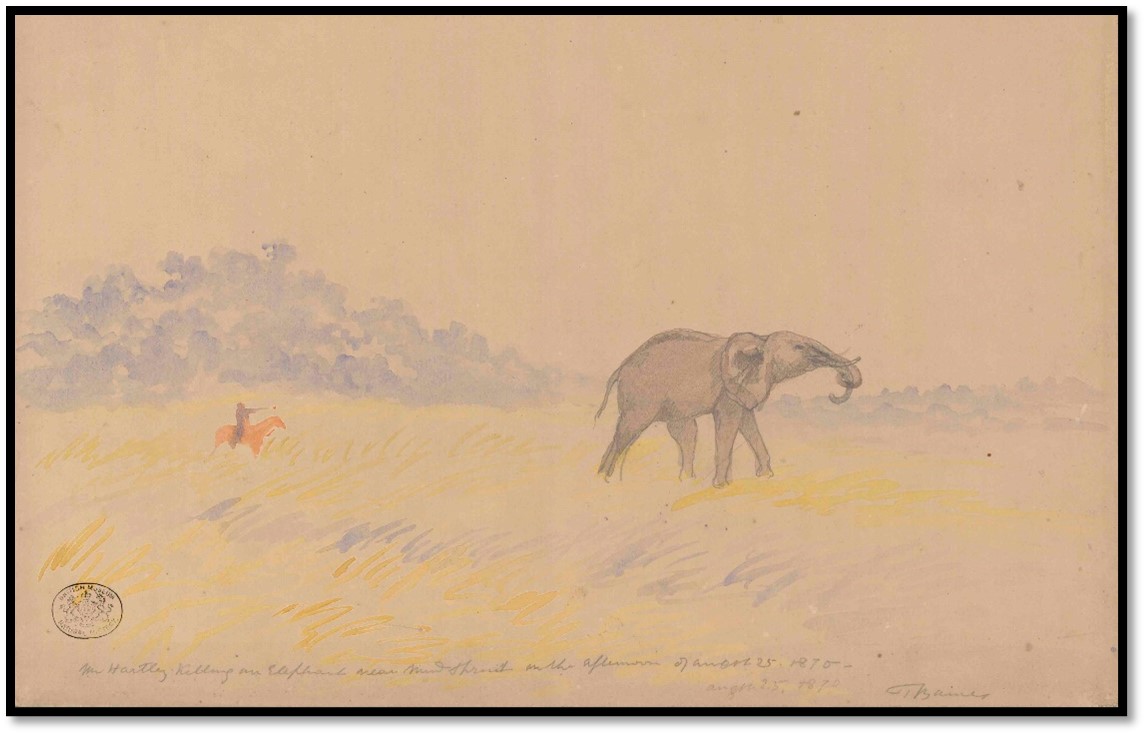
NHM (London) Baines Collection No 99: Henry Hartley ‘Oude Baas’ shooting an elephant near Mud Spruit 25 Aug 1870
27-Aug In the morning they rode out to see Hartley’s kills, then Gifford’s. Baines only had time for a quick sketch and some measurements as the hunters wished to visit all their elephants and Baines’ hat and gun also needed collecting. The servants were left to bring back the meat and ivory and they began their return, Hartley Hill being 28-30 miles away.
28-Aug Leask and Gifford come over for Sunday morning service. Remainder of the day in conversation.
29-Aug A little after sunrise Baines and Jewell accompanied Hartley and Maloney to the hunters wagons at the Mupfure drift where coffee, meat and bread awaited. Thomas Leask and Kennedy joined them and they rode to the hunters camp on the Chirundazi. [the camp Baines rode to on 6 July 1870]
They then turned east crossing the Chirundazi rivulet and after riding for 1½ hours they reached Willie Hartley’s grave. The huts and scherms and branches had not been burnt by the grass fires. Two Umghondie trees cast a shadow with the initials W.J.H. and the date 29/05/70 was still sharp and clear on the tree trunk. Leask took Hartley to the grave and then left him alone. Afterwards Baines made a sketch and Jewell took two photographs.[xxxv]
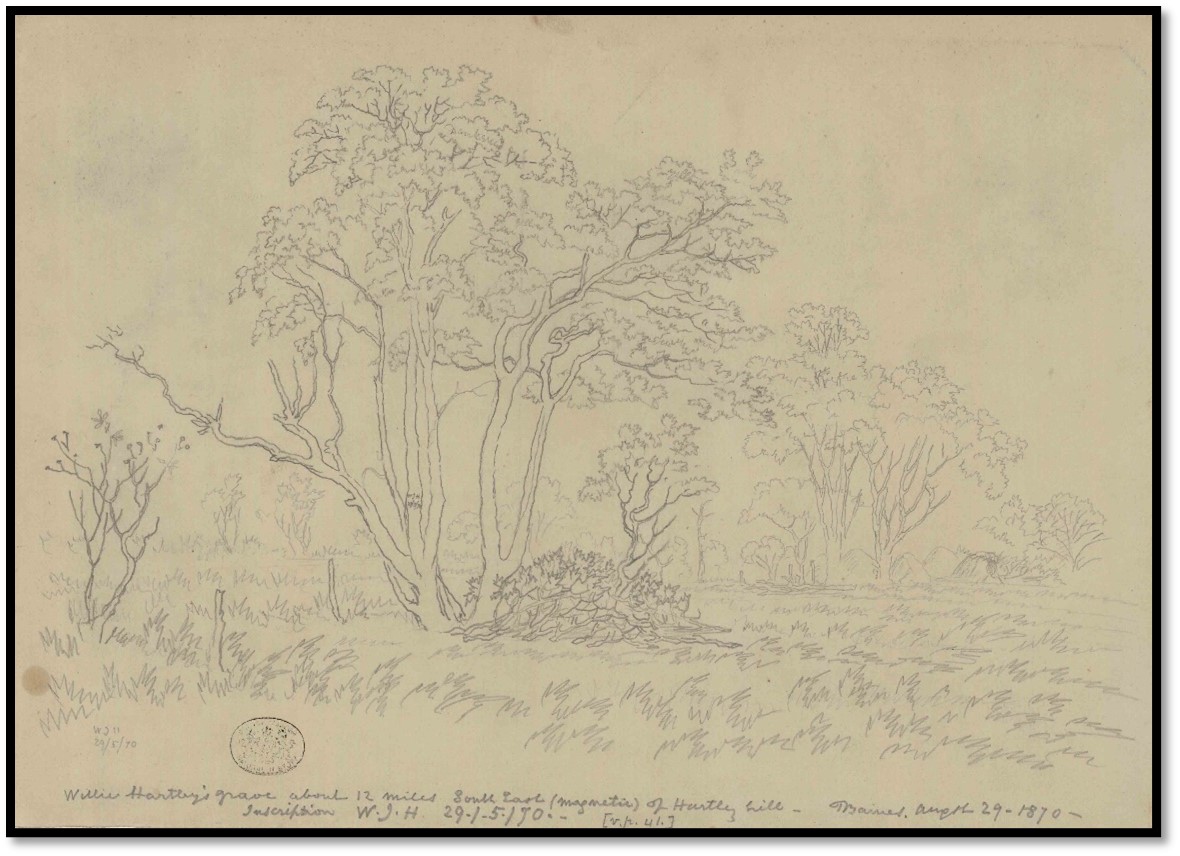
NHM (London) Baines Collection No 45 Willie Hartley’s grave about 12 miles SE of Hartley Hill
Leask and Kennedy then went to the south-east hunting for elephant, the remainder headed north-west for the Mupfure drift at the junction of the Chirundazi rivulet and Mupfure river. Maloney on the way shot a tsessebe. On reaching camp Baines started an oil painting of the grave-site that he intended to give Hartley.
Baines tells Hartley that he must send home sufficient quantities of specimen quartz to convince the directors of the South African Gold Fields Exploration Company that it was worth supporting the expedition otherwise that would forfeit their position as the only company in the northern gold fields. Hartley tells Baines that he can take specimens from Swinburne’s diggings as he had no permission from Ncumbata to dig holes and that the company should hire the country from the Umvuli (Mupfure) to the Ganyana (Manyame) rivers rather than buy – this would allay any suspicions of the amaNdebele regarding the land.
30-Aug Hartley and Baines plan to go up the Simbo (Chimbo) rivulet as Nelson wants to know if water-power could be used to power the quartz crushing machinery and Baines has heard there are Mashona gold workings on it. Baines has seen Mashona dry-stone walling (ruins) in the kopjes near their house and Hartley says the area is called madjen inumbi (hill of the cattle)
Baines asks Hartley if Kuruman is really dead. Hartley thinks so, he was killed at Umseligasi’s (Mzilikazi’s) orders and Lobengula was saved. Inyassi questions why Baines will accompany ‘Oude Baas’ Hartley…does he want to kill elephants?
31-Aug At daybreak they are ready for the trip. But the 3 servants refuse, saying they have come to dig for gold, not hunt elephants. Golube, who seems to be the ringleader is ordered to get Baines’ horse but sits sullenly by the fire until a stick is laid across his shoulders when he runs away. Charley brought the horse and Macushlumba, Tendulo and Jacob accompany him, Golube heads home to Matabeleland.
Soon after crossing the Chimbo rivulet they pass a quartz reef and then Constitution Hill. Hartley says that in 1867 his wagon was at the Serui river, 4 miles away, when one bull elephant went over the quartz reef of the old Mashona workings and across the Chimbo rivulet in the hills behind the company house and was killed here.
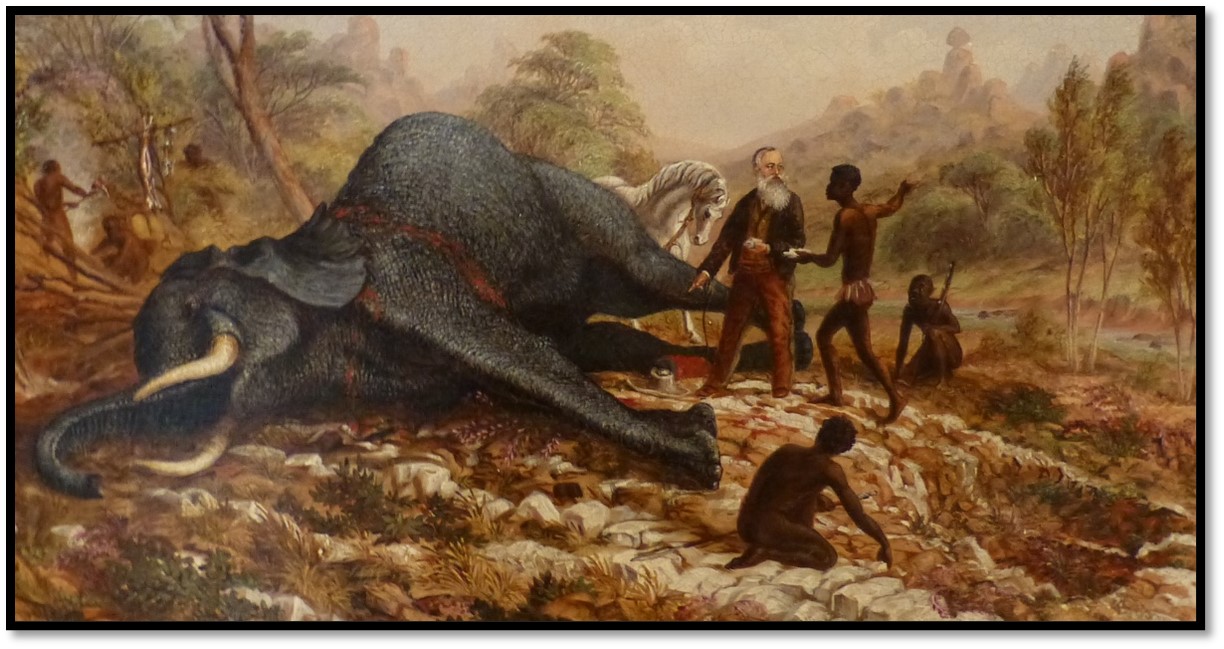
NAZ: Thomas Baines painting of the elephant bull shot by Henry Hartley at the old Mashona gold workings. In the picture Makhombo, who guided Baines to the gold workings at the Bembezana river on 7 October 1870, is picking out samples of quartz from the reef, whilst Inyoka, Hartley’s amaNdebele guide, points out the direction in which the Mashona survivors of amaNdebele raids have fled. Hartley subsequently brought Karl Mauch to the site.
Henry Hartley informed Karl Mauch who was travelling with him in 1867 and about 12 days later when the wagons were crossing the Chimbo drift Gifford took Mauch to the spot. Gifford picked up a 60 lb specimen and helped by Tom Hartley, Maloney and others it was carried ¾ mile to the drift on the Chimbo and put into a wagon. Karl Mauch records this event in his diary in great detail but claims it all as his own and no mention is made of anybody else’s contribution![xxxvi]
They then turn to the north-east and cross the Serui river, formerly called the Salagozaan because an old woman was killed here. They catch sight of a black rhinoceros that subsequently turns around “and with elevated nose charged right through the ranks of our followers causing some to drop their bundles and stumble over dead trees and one, at least to seek refuge among the branches to the great enjoyment of Inyoka.”
Herds of Sable antelope and waterbuck are seen but not fired at for fear of spooking any elephant in the area.
September 1870
1-Sep The Serui river is followed for several miles as it flows south-east, but the grass has all been burnt off and Oude Baas almost gives up hope of finding elephant and on spotting a rhino gave chase. Maloney took the lead firing several shots. This stopped when his horse took a tumble and Maloney sprained his wrist, the rhino escaping.
Baines did not have his gun, but his horse took the lead with a ‘splendid sable antelope’ running parallel to the animal just 40 yards away, before the horsemen pulled up at the sight of two black rhinos cows. One was already wounded, the other lowered its head preparatory to a charge. The 6-bore muzzle-loaders of Maloney and Hartley fired and the rhino squealing loudly ran a 100 yards and then fell. ‘Oude Baas’ notwithstanding his rhino accident the year before was on her with a knife, but Baines begged for a few minutes to draw a sketch. He then went on to the other female rhinoceros and sketched the off side, while the hunters began cutting the other side.
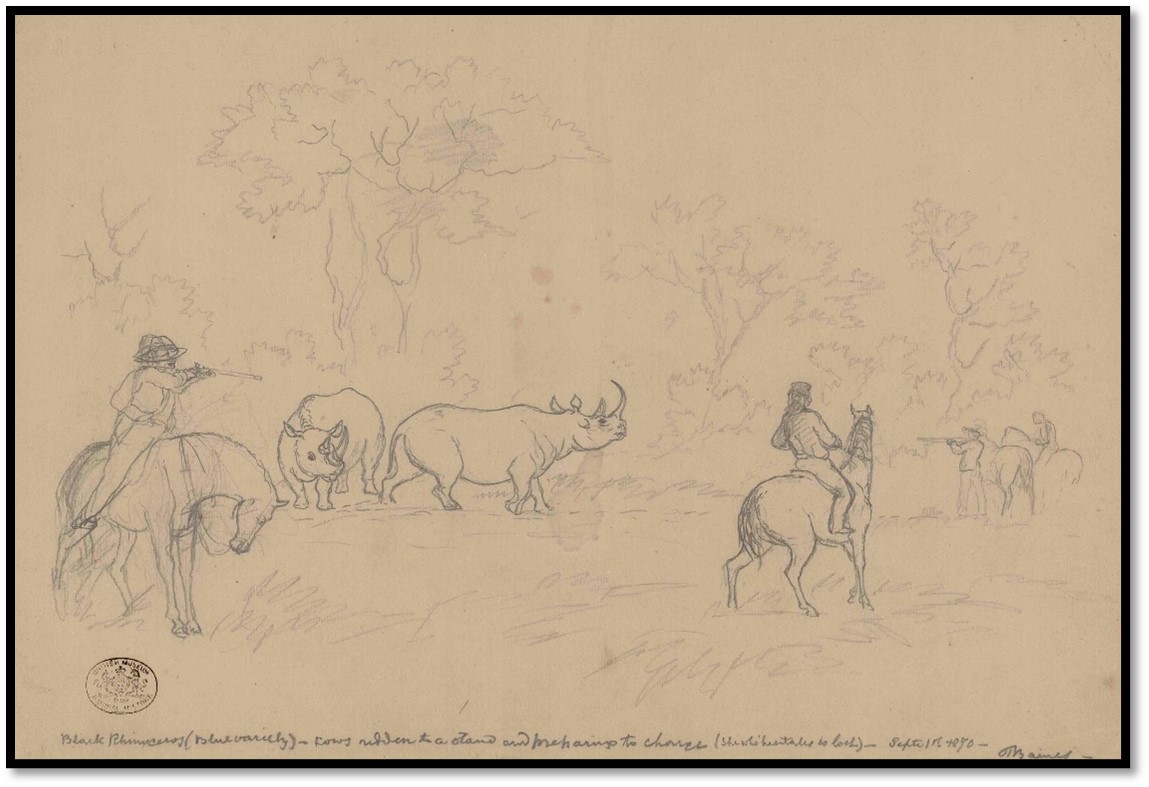
NHM (London) Baines Collection No 110: Two black rhinos ridden to a stand and preparing to charge
Turning south the hunters crossed the headwaters of the Chimbo before moving onto the Mupfure drift and then turning west for their camp arriving back about 4pm. Baines writes that Hartley recognises six varieties of rhinoceros by their form and colour.[xxxvii]
2-Sep Golube returns to camp, he is afraid of being eaten by lions on his way home. An argument ensues in which Inyassi and Jewell take part, Baines will not give Golube a whole blanket as he has broken his contract. If the servants spoke to him he would listen, but Golube stubbornly refused to work and must expect to be driven away or to be thrashed if he came near the fire, Jewell or Watson would do the same. Inyassi begged Baines to give Golube to him and Baines said if he kept out of the way and he did not see him that was acceptable.
3-Sep After breakfast Baines searched for ‘Sixty mile reef’ with Inyoka who pretends he does not know its location. Baines guides the party watching Inyoka’s reaction for guidance and finds a quartz reef and after turning back three more reefs. Hartley says Inyoka is being awkward, he will take Baines another time.
4-Sep Inyoka remembers the ‘Sixty mile reef’ location after being told he will incur no harm from Lobengula. Hartley proposes to take Baines to the Portuguese house [Maramuca, was a Portuguese trading station built by Gonçalo João and destroyed about 1680 that Peter Garlake excavated in 1965. However the description given later does not tally with that of Maramuca][xxxviii]
Inyoka says he knows of other Portuguese houses from when they came to trade for ivory although they did not enter Matabeleland itself. Baines knows that the children of Portuguese traders or their agents, vashambadzi, travelled as far as Wankie’s on the Zambesi river as he heard their guns when he was at Logier Hill, although he did not see them.
5-Sep Inyoka takes Baines to ’60 mile reef’ taking a southerly path to the first diggings and then on a 340° direction. He could not describe exactly where Gifford took the 60 lb specimen, but they all lay within ¾ mile of the company house. Baines reminds us that he is not a mineralogist, but some of the specks looked like gold and the Mashona definitely mined these quartz veins.
6-Sep Hartley, Maloney and Baines cross the Serui river and then go north-west, the air thick with smoke from grass fires. They off-saddle under some mopane trees and later under matchabeela and umkhondie trees (Msasa) which are ablaze in colour.
In the afternoon they came across a ridge of quartz with extensive shallow diggings going east and then more excavations to the north-west. They searched for samples, but no gold specks were seen.
Clearly they were now on the edge of the tsetse-fly belt as one was seen, but they are inactive during the night, so they camped at a spot with trees and water. Hartley discusses with Inyoka the location of the Portuguese house, but Inyoka now pretends ignorance. Hartley says Makonde told him his father said the houses were occupied as a trading station for gold and ivory when he was a young man so they were only deserted 60-80 years before [i.e. c.1800 – unlikely as Maramuca was abandoned as a trading post around 1680] The area was known as Malumpie or ‘of the white man.’
7-Sep Fresh elephant spoor was found leading south-east and then northerly, but after some time it was clear the elephants had ‘got their wind’ and the party had been scented and the elephants were moving away at speed. Hartley took his gun but Baines did not to avoid a confrontation with his amaNdebele servants. When the tracks scattered they gave up the chase, they were now within the ‘fly’ country and they gave up also the search for the Portuguese house.
At the Imbeela river [possibly the present-day Suri Suri (Shuroshuru) river that runs east and north of Chakari and very close to Maramuca][xxxix] they saw rhino spoor. They then set off for Hartley Hill which was reached after 10½ hours of riding. [the Suri Suri river is 37 miles in a direct line from Hartley Hill and further cross country. Horses travel at 4mph i.e. approximately 40 miles in 10½ hours]
George and Swithin Wood were at the house and said there wagon is near extensive gold workings that still have piles of quartz layered with wood, ready for roasting and the flat rocks nearby are worn from the crushing of the quartz.
8-Sep George Wood brought a porcupine quill filled ⅓ with gold. When he asked where it was found the Mashona replied: “Is it not everywhere?” Jewell and Maloney shot two zebra.[xl]
9-Sep George Wood invites Baines to visit his wagon, about 50-60 miles north to see the gold workings. Baines saddles up with George and his brothers Swithin and Thomas and they cross the Imbeela river and after a further 1 hour 40 minutes reach a group of ‘rounded tree-clad hills’ where they dismounted. Across a little ravine were the ruins of the Portuguese house.[xli] Baines says the dry-stone enclosure was about 50 x 60 yards and in places still breast-high, though elsewhere only an irregular line of loose stones.
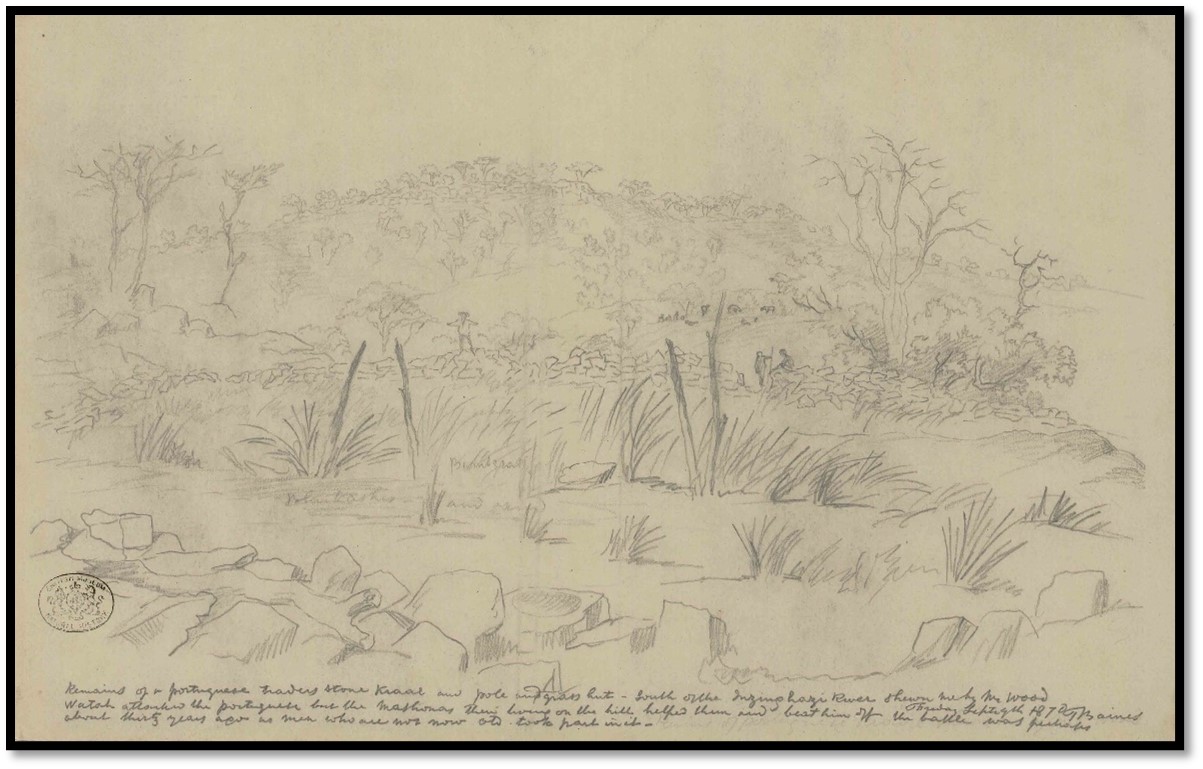
NHM (London) Baines Collection No 48: supposed remains of a Portuguese traders stone kraal
Some blocks of granite in the centre seemed natural, although one had become hollowed on top probably from grinding sorghum. There were still charred poles lying around from a hut that had not been covered in dhaka (clay) with fragments of pots scattered about. Local Mashonas told George Wood it had not been a regular house but a trading station used periodically by Portuguese traders or their agents, vashambadzi.
They said the traders had been attacked by Watah [Hwata] a tributary chief of the amaNdebele living further east in the Mazoe Valley and had driven off his followers although several Portuguese had been killed. The attack was said to have taken place between 20-40 years before. Extensive areas of quartz reefs are seen, but no specks of visible gold.
10-Sep They cross the Inzinghazi river, a tributary of the Ganyana (Manyame) river and after riding towards Hartley Hill and hearing a clamour of voices turn towards the sound. A duiker lay within the meshes of a net made from matchabeela bark that the Mashona had strung up in a line about 100 yards long.
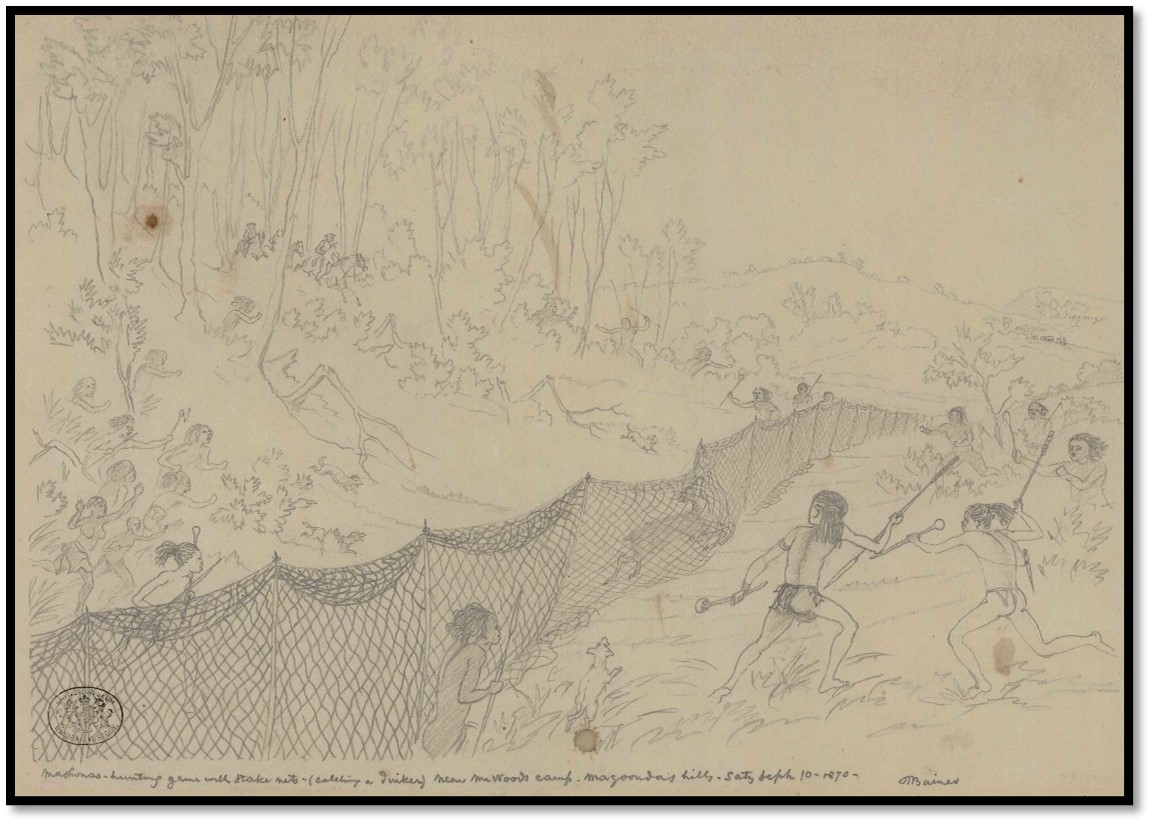
NHM (London) Baines Collection No 49: Mashona hunting game with nets at Maghoonda’s hills
In the late afternoon they reached Woods’ wagon on the eastern slope of a quartz hill with old Mashona gold workings on the northern slope. George Wood tells Baines of an elephant he shot south of the Imbeela river that had two hearts. The elephant was hit 13-24 times, one of the hearts was pierced but the elephant ran for another two miles. Wood wanted to preserve the hearts, but Gifford said it was impossible, so they roasted them for breakfast.
11-Sep Stayed in camp to let the men and horses rest – in two days they rode about 50 miles. Roast fowls stuffed with hippo fat for breakfast, eland steak and marrow for dinner with cold plum pudding after!
12-Sep While Wood repaired yokes and wagon gear Baines went over to the old Mashona diggings that are high up on the steep side of a hill, the rubble has stained the hill below. The samples he picked have a yellow tawny colour rather than the customary red that sometimes has specks of gold. Quartz outcrops occur elsewhere on the hill, but without tools he cannot dig into them.
13-Sep George Wood and Baines ride to the scene of the quartz-roasting site. They pass through a narrow poort (pass) and up the stony bed of a small rivulet and on a low ridge nearly halfway to Maghoonda’s kraal see the huts of the quartz-burners, one of which has two levels. The grinding stones are gone, as is the heap of burnt quartz he saw, but another heap lay calcined and scattered on the ground. Much of the quartz was the same as those Baines saw the day before with a yellow tawny colour showing he should not be disheartened by not seeing visible gold. A few small samples were taken to show Nelson.
Further diggings were seen with promising-looking quartz and Wood kindly gave Baines the quill of gold that Baines said would prove to the company directors that the Mashona, with their crude tools, could still obtain gold. Baines said he would very much like to watch the Mashona mining and roasting the quartz to obtain the gold.
14-Sep Wood making a new trektouw from eland skin, three strands being twisted around each other and stretched.
15-Sep George Wood said they would ride out but ate too many groundnuts and was ill with indigestion. His brother Swithin takes his place and together they ride east for 3 hours and then return to camp at sunset. Some good quartz reefs were seen. George Wood has asked the Mashona about gold-working, but they are reticent on the subject. Baines wonders if the gold mining is a relic of the old Portuguese trade or caused by their own efforts in the last few years. He thinks the presence of the amaNdebele may frighten the Mashona from saying anything on the subject.
Baines thinks they must respect the rights of the Mashona when they are working a quartz reef, but doubts that the amaNdebele will do the same. When asked questions, the Mashona evade the subject as if it was a crime. They think the stones belong to the king and neither they nor white men may burn them without the king’s permission.
George Wood thinks the art of gold-working probably exists closer to the Portuguese settlements of Tete and Sena but has died out in the Northern goldfields. The local Mashona bring them honey for barter.
Wood states that tsetse-fly was encountered previously where the Hunter’s Road crosses the Sebaque (Sebakwe) river but now the herds of buffalo are no longer present, the tsetse-fly has also gone.
16-Sep One of the Mashona bartering corn and eggs states that the people in a village to the north-west do gold trading with chief Watah (Hwata) and not the Portuguese. Baines does not think that the Portuguese or their Mambari (vashambadzi) go as far as the Mazowe valley. He would like to see a demonstration of quartz crushing but says when questioned the Mashona shrink from the subject and become ignorant.
From his earlier travels in the lifetime of Mzilikazi George Wood has observed that all the Matabeleland rivers from the Kumalo to the Gwailo (Gweru) and Ingwainya (Ngwenya) flow into the Gwaai river and those to the east of them from the Inkokwaasi, Quaequae (Kwekwe) and the Umvuli (Mupfure) flow into the Umnyati (Umniati, present-day Munyati) and then the Zambesi river. The Ganyana is the Hunyani, present-day Manyame river.
17-Sep Wood says that Umselegasi (Mzilikazi) was often puzzled by the difference between his own and Europeans customs but had the foresight to see when he should relax his powers a little.
Baines writes that none of the hunters go hunting on Sunday and most of the traders do not trade. He says that one trader stood out in Bulawayo and Mzilikazi summoned each on one Sunday to buy an ivory tusk. They all refused, except the one who immediately began to bargain before Mzilikazi said: “I do not sell on a Sunday.”
He says the old chief was fond of annoying the missionaries by keeping them at his kraal for several days at a time and offering them young girls to compensate for the absence of their wives!
18-Sep Preparing to leave Wood’s wagons and camp.
19-Sep The wagons are left in-spanning and they ride over elevated ground in which appeared ridges of stratified rock tilted on edge. George Wood wounded a sable antelope and later killed a zebra although he refused its meat. Baines makes notes on the stripes in great detail and general features of the animal. They halted on the first tributary running into the Ganyana (Manyame) river and then rode south and slept in an open valley that had escaped the grass fires.
20-Sep Wood lends Baines a saddle and horse and they continue with the servants cutting a wagon road through the trees. Suddenly they came across elephant spoor and for hunters this takes precedence over everything else. Joined by Swithin Wood they followed the spoor travelling to the south-west before the spoor turned and led them back to within ½ mile of where they started. The herd appeared to be cows and calves and so they gave up and off-saddled after 5½ hours of riding. Wood had roasted 4 chickens before leaving and these were had for tiffin.[xlii]
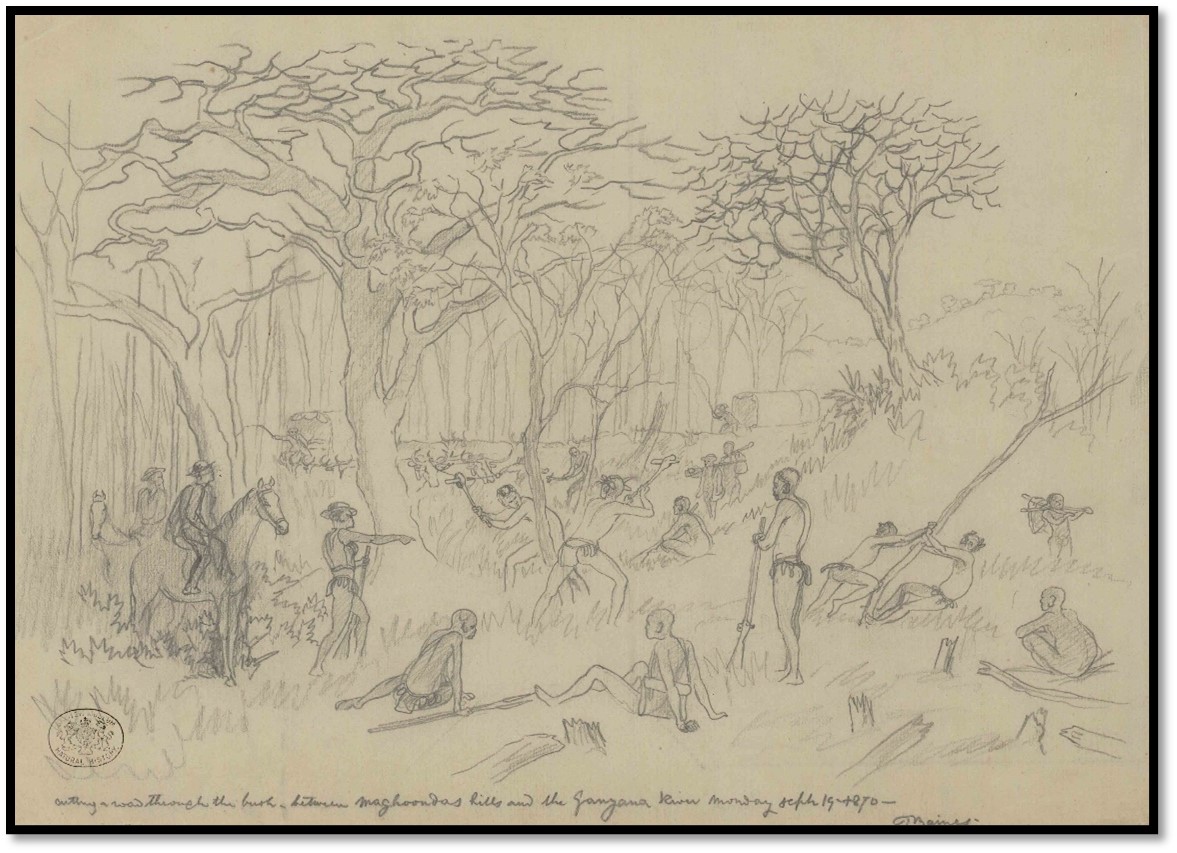
NHM (London) Baines Collection No 50: Cutting a wagon road from the Ganyana (Manyame) river back to Hartley Hills
The ants cleaned the bones as they threw them down and George Wood says if a house is infested with white ants soak straw in arsenic solution and put it down near their holes. The ants cut the straw into pieces and carry it down to feed their queen and when she dies they desert the nest.
21-Sep In the morning trek they pass makoonda and makobakoba (Mahobohobo - Uapaca kirkiana) fruit but they are not yet ripe. In the afternoon Swithin Wood and Baines go hunting and although they fired at two separate Sable antelopes, neither fell.
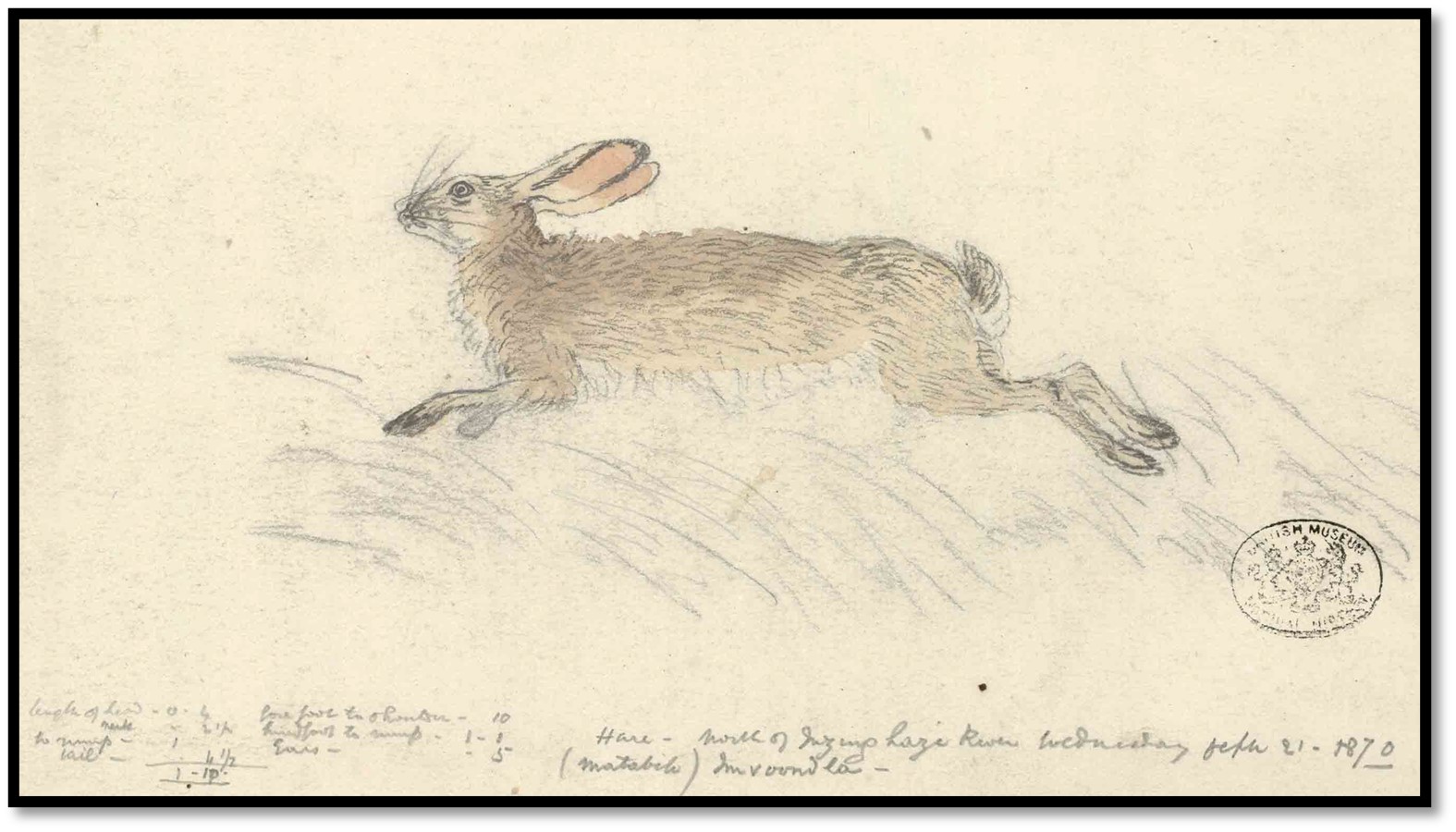
NHM (London) Baines Collection No 97: Hare caught north of the Inzinghazi river 21 Sept 1870
22-Sep They hunt for meat for the servants and 5 hours ride brings them to the Serui river and they trace a quartz reef for 500 yards. Some waterbuck are chased without result.
23-Sep The Serui is crossed and the Chimbo rivulet and the house and wagons at Hartley Hill are reached. Oude Baas has been gone about 6 days. Baines needs to pack up the quartz samples before following him.
24-Sep Wood inspanned to leave. He gives Baines 5 large pieces of salted beef and an old saddle from which Baines can fix his own damaged saddle. Baines gives him a bottle of fever medicine. One of Baines’ ox-span has lung-sickness and is shot to spare the others. The rest of the day spent packing the quartz samples in raw hide and labelling. There is a risk that other oxen-spans are infected and Baines’ oxen pick up the disease when they are out grazing.
25-Sep Charley brings a clutch of crocodile eggs, his face beaming with delight. They were found between the Chimbo rivulet and Hartley Hill only a furlong (200 metres) from the company house and above the pool in which they usually bathe! 47 eggs were buried 12 inches below the surface.
Gathering clouds are now beginning to signal the possibility of rain.
26-Sep They prepare to leave their house and Hartley Hill, the samples are packed and Baines has proof of the existence of gold, although he is sorry that the company mineralogist, Nelson, never arrived.[xliii]
Woods wagons were outspanned on the southern side of the Mupfure drift, the hunters were away. Leaving Jewell to bring on the wagons Baines went ahead and observed a small herd of zebra and then a Sable antelope that departed as soon as he went back for his gun. ½ mile ahead was a black rhinoceros and calf, but after creeping up to within 80 yards his cartridge misfired, probably because it had become wet.
That night they camped at Mud spruit where his horse Dutchman died last year and where ‘Oude Baas’ had shot his two elephant a month before. Baines writes: “I feel a kind of holiday enjoyment in being out alone with my men…”
27-Sep They travel to the Umgweswie [Umsweswe] river but camp overnight on the north side as the grass is burnt on the other side. Next day about 1:30pm they reach Hartley’s wagons at the crossing of the Umgesana (little Umgesi) [Gwazana?] ‘Oude Baas’ had chased elephant into ‘fly’ country and had actually seen a tsetse-fly sting his horse and then killed it. He washed the place with oil and ammonia. Inyoka says once this whole district was under the command of chief Umgesa.
Oude Baas and Maloney found a herd of 200 elephant, but few had tusks worth shooting. Hartley says: “a young elephant, 4 feet high or a little more with small tusks 3 – 4 inches long, charged the hunters repeatedly but they forbore from killing him and had some trouble in driving him away.”
28-Sep After two morning treks they reach the Umnyati (Umniati, present-day Munyati) drift. Baines and Hartley rode 5 miles north-east on the southern bank of the Umnyati and saw an extensive quartz reef and about 2 miles below the drift “we saw the Umgesi (Ngesi) coming from the north and had a fine view up its picturesque and broken pools for about a mile.”
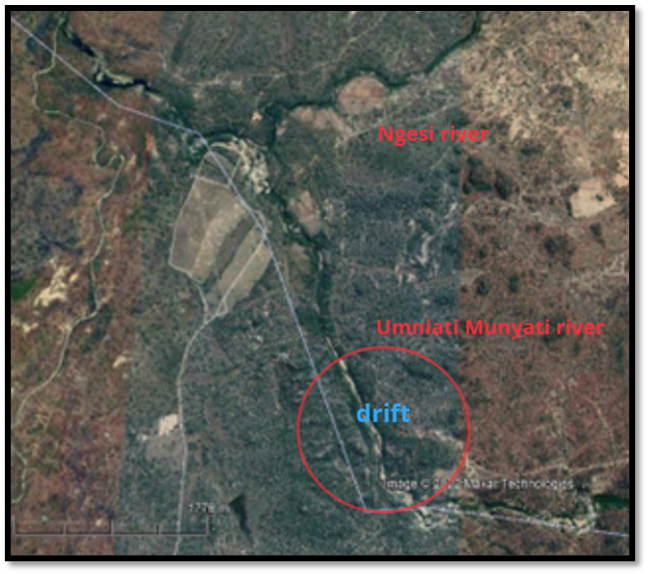
Umnyati drift and Hunter’s Road according to Thomas Baines
29-Sep Hartley does not believe the Umvuli (Mupfure) runs into the Umnyati (Munyati) and thinks it runs directly into the Zambesi with the Munyati running into the Gwaai river.[xliv] Baines, Maloney and Hartley once more ride down the Umnyati (Umniati / Munyati) about 3 miles then crossed to the north side in the shallows between two pools hoping to find zeekoes (hippo) and then turned back and rode north east and over the Umgesi (Ngezi) and waited at a pool for some time before a hippo was spotted surfacing and both Hartley and Maloney’s bullets appeared to strike. Then another is spotted higher up the river that Hartley shot.
The first hippo shot now floated to the surface and was brought to shore where Baines did a quick sketch before the skin was cut for sjamboks and the flesh for food, the wangstuck or cheek being kept as a titbit for the hunters.
30-Sep A search was made for the second shot hippo but it was not found. Baines discusses purchasing a gold claim area for the company. Hartley says the king and his councillors will be wary of selling land, the privileges the king has granted Baines in terms of exploring, digging and erecting houses and machinery have been very generous.
Jewell and Watson arrive in the evening with the wagons. The dryness of the air has caused the woodwork on the wheels to shrink and one has had to be wedged and lashed with hide and many of the spokes are loose.
October 1870
1-Oct Baines updating his maps, Jewell wedging and lashing another wagon wheel, Watson mending Baines’ saddle. George Wood arrived in the afternoon and has been ill with fever, Swithin followed with the wagons.
2-Oct The servants consider themselves homeward bound and anything that advances the journey is done as if by magic, any duties not advancing it are considered a chore!
3-Oct Serenaded by a troop of lions between 4-5am. Everything packed, the oxen inspanned and the wagons on the move by sunrise. The Umnyati drift crossed in 20 minutes by 8 wagons.
Baines asks Hartley about the quartz reef on the Impembesi [Bembezana] river that was found by the Oude Baas when he was chasing elephants and that Karl Mauch was then guided to by Makhombo; but at the same time fresh elephant spoor and dung is seen going west. Baines writes that the gold diggings were discovered whilst Hartley was chasing elephant and when a man believes that his duty and pleasure run side by side, very little further argument is needed.
The elephant spoor led them west with stripped off bark and leaves showing they were feeding as they went. The dung became net nieuw (very fresh) and they were watering the horses at a spruit when some elephants were spotted by the flapping of their great ears. Baines did not take his rifle as the king had not granted him permission to shoot elephants. Oude Baas shouted to the hunters to move left and right of the herd to keep them together and drive them until exhaustion. The great troop of cows accompanied by calves, at least a hundred in the herd, shuffled along their heads carried high and their trunks hanging half-curled. Something else that Baines notices is their absolute noiselessness when moving and no path is left for the following horsemen as larger tree trunks are avoided.
An elephant hunter never dismounts to fire or stops his horse to reload. Baines followed George Wood who never ceased firing. One elephant answered Wood’s call by turning around and charging with expanded ears, elevated head, sharp twinkling eyes and trunk held at the ready. Our pursuer screamed with rage and they galloped for 150-200 yards before Wood fired again and the elephant continued on. Maloney crossed from the right driving a bull and more shots were fired. Swithin Wood then appeared driving another bull before our bull staggered, went down on his hind legs and fell on his side. Oude Baas came now with a fifth bull and another shot from George Wood put him down, another was left on his feet, but virtually dead.
After a chase of a couple of hours another troop of bulls was encountered and Baines stuck with Oude Baas whose well-trained horse ran parallel to a bull elephant and about 40 yards away as his master reloaded. After a further shot the elephant staggered another 100 yards and then rolled over on his shoulder. Guided by shots they found their friends busy with another large bull and after it fell they off-saddled. Baines measured the last as 12 feet high at the shoulder. 8 bulls had been killed and each had its entrails pierced to slow down the decay of its flesh from the stomach gas and Baines begged a tail as a memento of the chase. They had been in the saddle from 8:40am to 1:40pm; 5 hours of hard riding for horses and hunters.
4-Oct After breakfast they saddled up and road north-west until they crossed their tracks of yesterday and also the old road [Hunters Road?] by which the wagons formerly came in, in some parts 6-7 miles north-west of the current one. The makoona trees (Mabola plum or hissing tree; Parinari curatellifolia) had fine ripe fruit with many lying on the ground – elephants are very fond of them. They climbed a granite kopje and had a view to the fly country north of the Umgweswie [Umsweswe] and to the south-west.
Hartley once shot 4 bulls whose tusks weighed 360 lbs. On one day at the Crocodile river he shot 14 elephants whose tusks weighed 400 lbs. One elephant had a broken tusk of 100 lbs and another of 122½ lbs. He says the latter 8 feet long and perfectly straight is used as a pillar for a font at St Peter’s at Rome.
5-Oct They trekked at sunrise crossing the path of a snake in the sand that was nearly a foot wide {probably a python] Outspanned at the Sebaque (Sebakwe) river at their old scherm. Tomorrow Makhombo will guide him to the spot he took Karl Mauch. “If the hammer drops out of my hand with amazement, I shall consider it a most intelligent hammer and a better gold-hunter than I am myself.”
6-Oct Hartley and the hunters search for elephants, Baines goes to seek the goldfields on the Impembesi (Bembezana) river with Makhombo as guide and Inyassi and five men as attendants. Taking a path to the north-west they were diverted by a bee’s nest in an anthill that needed to be smoked out on the principle that ‘honey in the mouth is better than gold in quartz.’ They crossed the Sebakwe and another rivulet and saw outcroppings of rose-coloured quartz. They crossed an open valley and two swelling ridges covered in matchabeela and other trees.
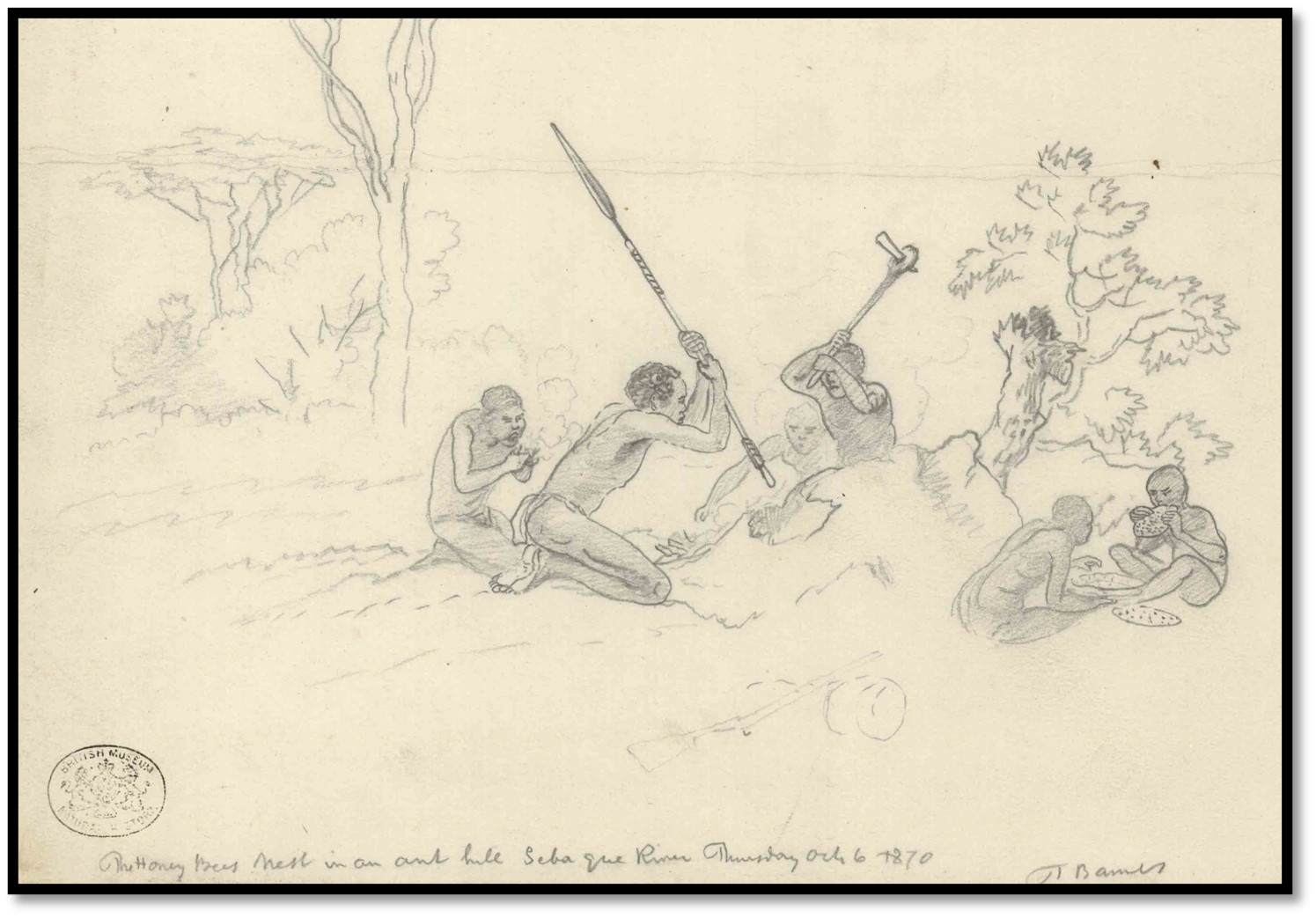
NHM (London) Baines Collection No 53: Honey bee nest in an ant-hill, Sebakwe river 6 Oct 1870
Baines and Inyassi had just fired at and missed three kudu when the men called out Inkhombi (rhino) Baines fired at 100 yards and hit the animal in the ribs, a second shot hit the hind leg and the men ran in and stabbed with their assegais. A further shot in the shoulder left the rhino exhausted and helpless and it was finished off with assegais. There are detailed measurements and description in Baines’ notes and he made two sketches.
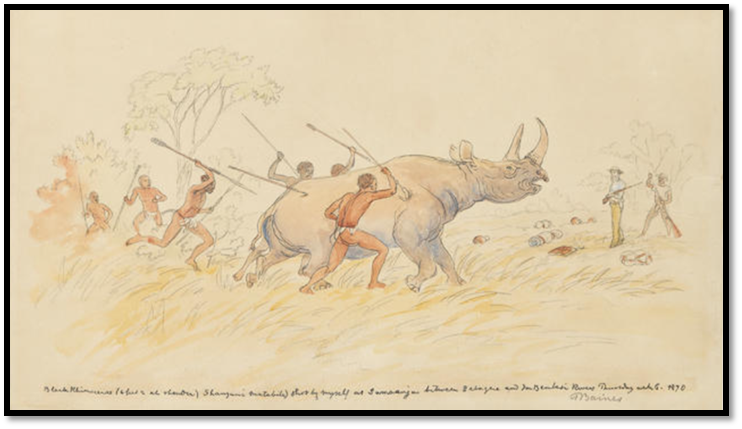
NHM (London) Baines Collection - Black rhinoceros shot at Samarinja between the Sebaque and Bembezaan rivers 6 October 1870
A message was sent to Jewell at the wagons before they built a scherm and a good fire. Charley arrived after dark with the pack-oxen, hyena and jackals howled and snarled all night at the carcase, but no lions came.
7-Oct Charley and Jacob took the rhino meat back to the wagons and Makhombo led them north-west until they came to the diggings he had shown Mauch. The principal pit was perhaps 25 ft long, 15 ft wide and 10 - 12 ft deep with trees growing out of it. Here he was told Mauch broke the stones and seemed to first grasp the vastness of the gold fields. Baines also took samples, looked carefully at them with the microscope and tested any little specks with nitric acid, but failed to definitely identify gold.
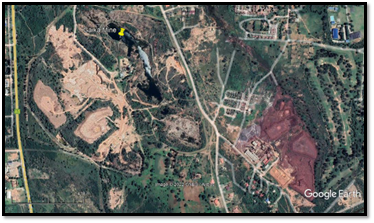
Google Earth view of Gaika Mine, the original open-pit is now under water. Present-day diggings surround the site and are subject to a chaotic mix of artisanal miners and ZANU-PF connected security forces
Over a little gully to the north west they came across another quartz reef that extended for ½ mile from which he took further samples. From there they travelled north-west to the Bembezana[xlv] where they found an ostrich nest with 13 eggs. They found another old working nearer the river and looked for promising samples, but none are found and at 3pm they recross the shallow sandy bed of the Bembezana stream ‘just deep enough to give us a pleasant foot-bath.’
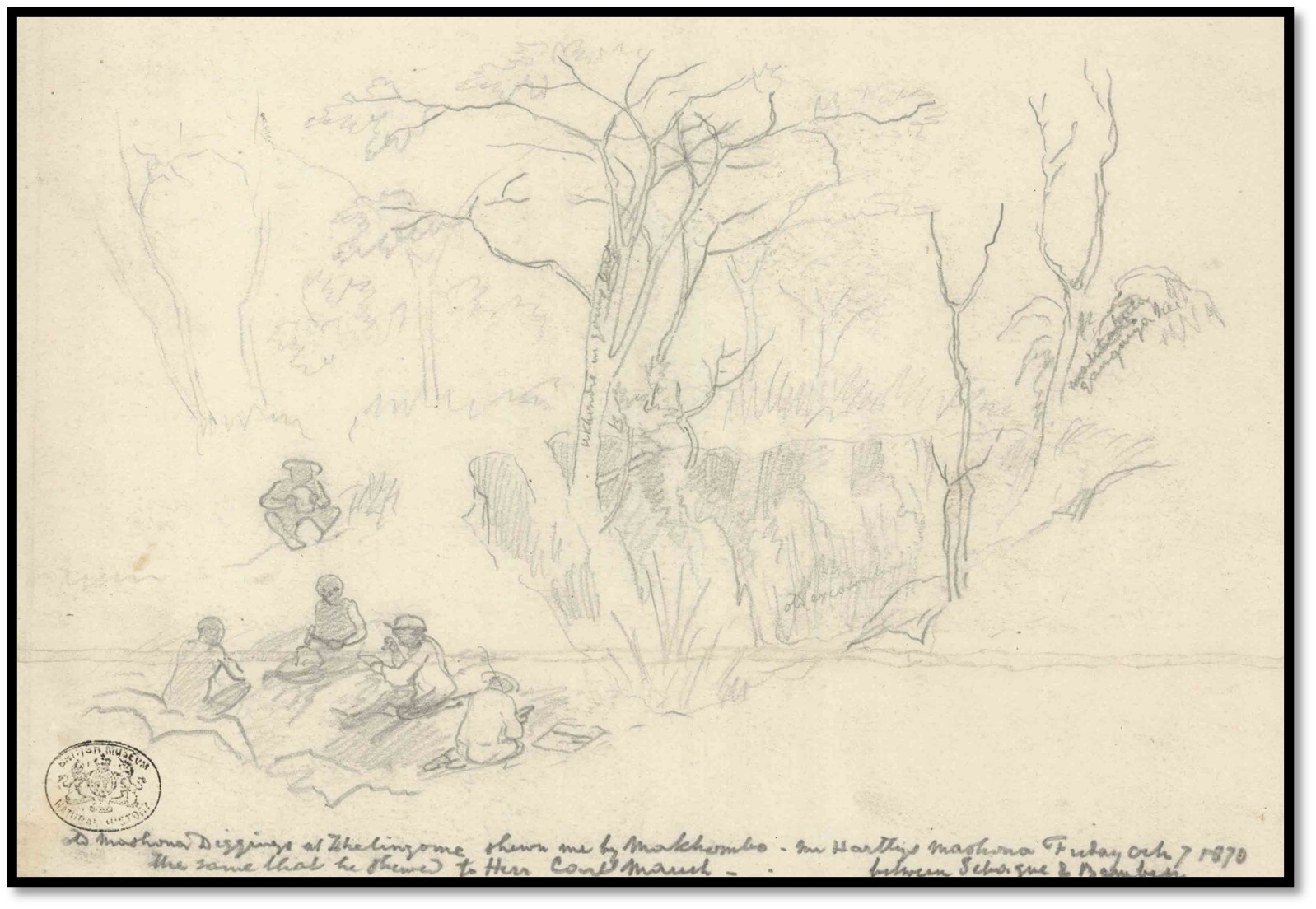
NHM (London) Baines Collection No 54: the Old Mashona diggings at Zhelingome that Makhombo guided Baines and before him Karl Mauch – discovered by Henry Hartley and probably the present-day site of Gaika Mine
A buffalo is spotted and Inyassi and Baines stalk the animal for ½ mile up the stream. Baines first bullet hit the left thigh, the second, third and fourth balls are into the shoulder. As soon as the buffalo fell it was assegai’d by the amaNdebele. Baines sketched the old bull and took detailed measurements.
8-Oct They travel south east carrying the buffalo meat and near the Monyokwi rivulet shot two Bush pig. Again they are measured carefully with a sketch drawn and the wagons are reached by evening.
9-Oct Jewell and Baines ride over to Thomas McMaster’s wagon and he accompanied them back to Hartley’s camp at the Sebakwe river. The hunters had killed several more elephants.
10-Oct Baines rode back to his wagon. Inyassi was now being awkward and saying the king had not told him to go and look for holes. He worked himself into excitement and would pick a quarrel with Jewell – Baines took sticks and other weapons away from him. When Baines told his men to take his things they prepared to do so until Inyassi ordered them not to obey Baines. Baines did not want a quarrel at this stage of the expedition and on their way to Matabeleland, but Inyassi was insisting they disobey Baines. A fracas broke out between the two, Inyassi brandished an assegai that Baines wrested from him and Inyassi then ran off taking Jewell’s gun with him and two of the men following him. Inyoka was told of the affair by Umfundusi and said that Inyassi was in the wrong.
11-Oct Inyassi came back to camp and said he was leaving. Baines through George Wood told him by so doing he would forfeit everything. Inyassi tried in every way to shift the blame to others, but at last accepted responsibility on condition that he was not beaten, Baines said he had forced it upon himself, but was forgiven as long as he returned to duty and the others also returned. In the map reproduced in The Gold Fields of S.E. Africa this site is called ‘Mutiny Camp.’
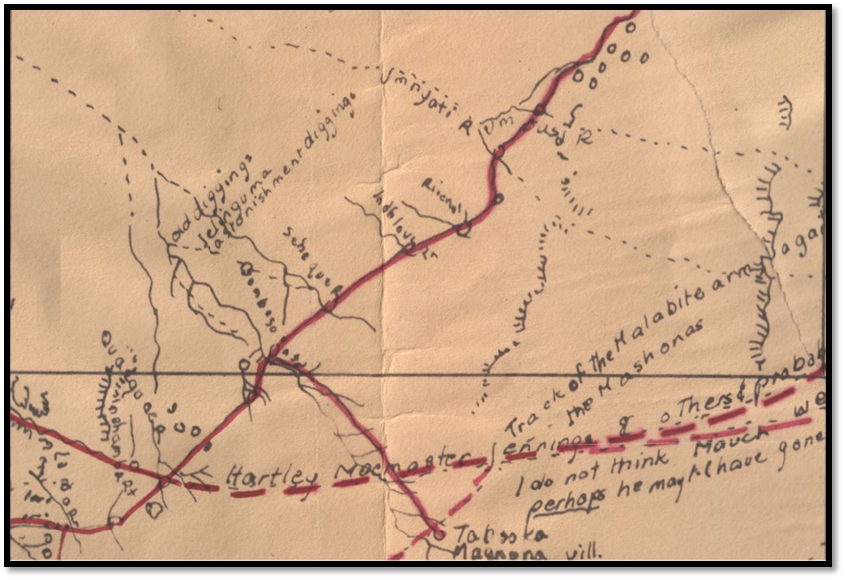
Baines map from https://exhibits.stanford.edu/maps-of-africa/catalog/pn565rk5366. The ‘old diggings’ are likely to be the present-day Gaika Mine site with the wagon road to the south.
Heavy rain that night.
12-Oct Most of the day mapping. Macushlumba, one of the runaways, brings two piglets for which he is given a coloured handkerchief and the piglets are put into a box with straw. Hartley and Wood’s hunters sent into ‘fly’ country come to the camp and are given food. Firing to the north proved to be another party of foot-hunters firing a salute.
The hunters tell Baines that below the Sebakwe and Bembezana “there is a krantz or cleft on each side of the river making an impassable poort.” [Sebakwe poort now part of the National Trust of Zimbabwe at 18°50´52" S, 29°44´37" E - https://ntoz.org/properties/sebakwe-poort/]
13-Oct Thomas McMaster brings his wagon over with a number of ostrich eggs that he is trying to hatch.
14-Oct Baines sketches the head of a Roan antelope (Hippotragus equinus) and gives detailed measurements and description.
15-Oct Jewell and Maloney arrive. Seeing Inyassi hanging about the wagon Baines calls him and tells him not to be afraid to come and say good morning as usual. One of the piglets has died and is preserved in salt for the Zoological Society.
16-Oct Two of the oxen are missing. The cracking of whips is heard and Hartley and Wood’s wagons arrive at Baines camp, George Wood driving in a kudu cow (Tragelaphus strepsiceros) followed by Mackenzie bringing in a steinbok (Raphicerus campestris) and both are sketched. Baines writes that the male horns of the steinbok, just 3½ inches long, are so sharp that sailors and tailors use them for piercing eyelet holes.
Oude Baas says he was once dangerously wounded by a little blaawbokje. (Common duiker – Sylvicapra grimmia) He was carrying it, determined to take it home alive and it drove its little sharp horns into his lower jaw, just missing the throat.
Mashona natives bring three young ostriches, not a day old. Baines wraps them in a blanket but thinks they may die before morning. The oxen come home under their own steam. He writes that Watson whilst out fishing “has seen crocodiles so close and so often that we begin to fear for some of our dogs and look upon our next bath with less confidence.”
18-Oct They trek nearly 12 miles to the first outspan on a south-east course. In the afternoon they pass a good-sized quartz reef. Four tracks are crossed that at first they believed were made by elephants, but then realise it is an amaNdebele army on a plundering expedition towards Ntaba Insimbe and chief Umgesa’s district. The district they are now passing through has been heavily cultivated for sorghum grain and every granite boulder has a small pole and dhaka thatched hut that serves as a granary. The village headman was Tabooka and with 3-4 more kraals was under command of Inyoka, Hartley’s guide.
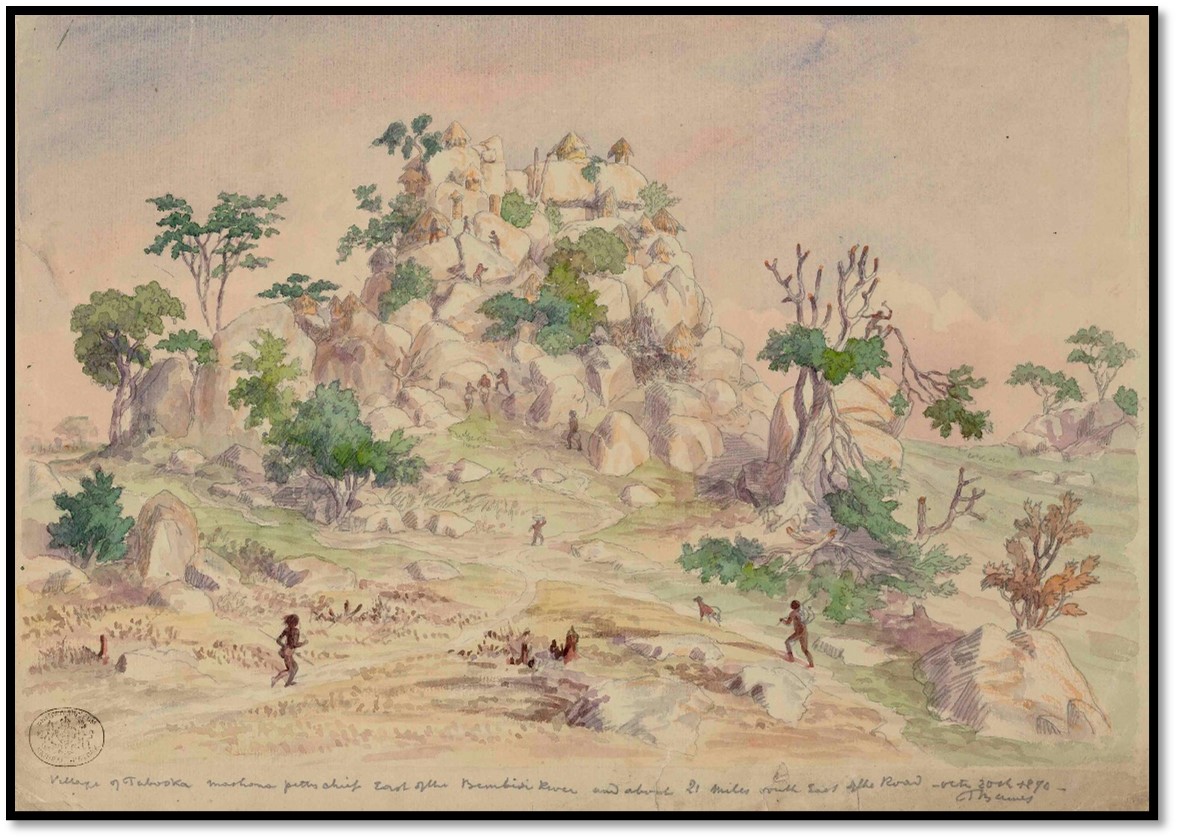
NHM (London) Baines Collection No 56: Tabooka’s kraal east of the Bembezana, 21 miles SE of the Hunter’s Road
19-Oct Hartley and Jewell bartered as much sorghum and African rice (Oryza glaberrima) as they could get, also 3-4 sheep and goats and some beer (outualla) made from makoona (Mabola plum) fruit.
20-Oct Umfundusi brings a hornbill, Baines calls it a toucan (Toki Toki) that he found in a hole in a tree walled up with clay [this is characteristic of hornbills] In the evening Oude Baas tells hunters stories of the size of trees toppled over by elephants.
21-Oct All the servants at work on the drift of the Impembesi [Bembezana] and Baines mapping.
22-Oct Started trekking about 8am. Watson and Baines shoot a Bush pig. They pass 2-3 quartz reefs and dry-stone walling from Mashona defences and reach Pamoanga rivulet.
23-Oct Hartley’s horse Grey Camelback is unwell and dies about midday. Hartley and McMaster put on a good dinner, even the puppies and ostrich chicks help themselves.
24-Oct They are disturbed all night by skirmishes between hyenas and leopards and the camp dogs; Hartley’s well-proven watch-dog Vuilbaard (Foul-beard) is missing. Opinion seems to be that he was guarding the carcase of his comrade Camelback by the river and that a crocodile has probably seized him. He never walked on a journey, but as soon as the cattle inspanned, would jump onto Hartley’s wagon and lie on his master’s bed.
They outspan at the Lunda rivulet and go south hunting elephant, but a large white rhino is encountered that both Maloney and Wood wounded, Baines following close behind: “…just as I was close upon the great clay- coloured beast lumbering along with its ungainly head so low that it seemed as if he must trample on his lower jaw at every stride, his curved horn pointed forward like a galliot’s bowsprit and his tail curved like a great pig’s over his stern, steered suddenly to the left…” Baines is almost alongside the rhino when Hartley fires and in another minute the animal begins to stagger, then falls struggling hard before rolling over on his near side. Baines stops Hartley from cutting up to make a sketch and take measurements. Both the ears and tail had been bitten off, probably by hyenas in calfhood.
McMaster had shot an eland and the servants were left to carry as much meat as they could back to camp. Baines says he has given up looking for quartz reefs now that they are approaching inhabited country.
25-Oct Baines walked in front of the wagons to the Ingwainya (Ngwenya) river and saw a good quartz reef near the outspan.[xlvi] He and Jewell ride after game and encounter a white rhinoceros but the cartridge did not fire when he was close up to the animal and it made off into the bush.
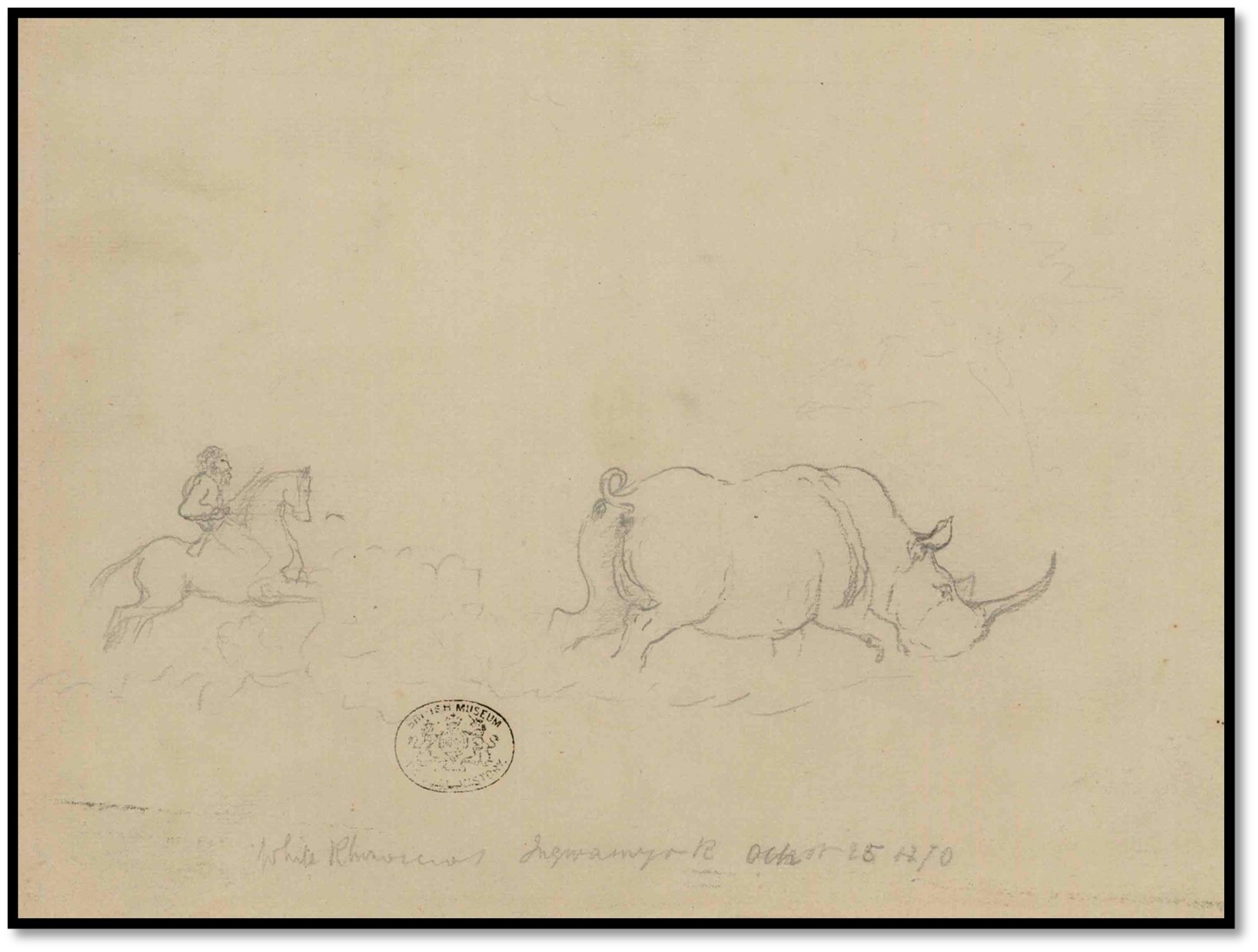
NHM (London) Baines Collection No 119: Ngwenya river 25 Oct 1870
The Gwailo (Gweru) river was reached about 3 miles above the drift and when they met the wagons they were climbing up the west bank.
26-Oct Crossed the Umvungu (Vungu) and Umbanga rivers where Baines had heard there was a Portuguese house, but his servants say they have no knowledge of its location.
27-Oct Crossed the Changani (Shangani) and Shongwe [Longwe?] rivers where Mackenzie tore off the near side of Jewell’s tent-sail against an over-hanging tree.
28-Oct Charley went off the track and broke the disselboom, which they subsequently shorten and fit. Watson finds a new pole that they tow behind the wagon until they have time to shape it. They pass Intembin or Picaroon kraal and inspan between the hills. Jewell and Baines ride 6 miles to Inyati mission where they enjoy a meal and tea with Revd and Mrs Thomson and their first-born boy.[xlvii]
Thomson tells them many wounded from the Zwangendaba battle came to have their wounds dressed at Inyati mission with others left for dead on the scene of battle. Next they visited Revd and Mrs Sykes and were given their letters and newspapers. One letter from Nelson explaining why he left for England and the other from the Durban agent Behrens on the subject of their credit running out.
Baines rather naively remains hopeful the company will grant Nelson the necessary supplies. He comments that he has kept expenditure to the absolute minimum and the drafts given to Behrens give him a lien over Baines’ own salary.
29-Oct Mporto, Lobengula’s brother comes to see Baines who asks that his congratulations be sent to the king before he comes himself. Mporto replies: “you have no cause for anxiety. The king has given you the country and he has now beaten those who were his enemies and he will not allow petty chiefs to trouble him or you.”
Jewell, Watson and Baines dined with Revd Sykes and presented him with a copy of the full-sized map for the use of Inyati mission. Both Sykes and Hartley want paintings, but Baines will not accept payment, Sykes painting can be a gift from the South African Gold Fields Exploration Company and Hartley can give meal or other supplies useful to the expedition.
30-Oct Thomson held a Sunday service in English there being six visitors plus the mission families.
31-Oct Baines mapping as he wants full-sized copies for the company directors, the colonial government and the Royal Geographical Society.
November 1870
1-Nov Jewell rides over to the Zwangendaba battlefield to get photos. Revd Thomson lets Baines use his room for mapping.
2-Nov One of the inoculated oxen is lung-sick but may get over it.
3-Nov Maloney and McMaster arrive in the night, Hartley in the morning, but they have had no luck elephant hunting and only shot a solitary hippo on the Umvungu (Vungu) river.
5-Nov Mapping today helped by Mrs Thomson
6-Nov Golube came for his pay but was refused because he deserted. In return he stole the sheep and goats. Mporto when told, said he would get them back. The lung-sick ox died. In the afternoon Thomas and Mrs McMaster had their daughter christened Euphemia.
7-Nov They leave Inyati mission at 1pm crossing the Bembesi river at 4:15pm. Evening rain.
8-Nov Rain continues. There are reports that natives at a kraal they had passed had killed one of Hartley’s oxen and beaten up the herd boy. Their own 12 loose oxen and herd boy have not arrived.
9-Nov Jewell and Baines ride back at sunrise. Hartley’s ox was still alive. The herd boy had lost the oxen and slept at the kraal. After a long search the 12 oxen are found safe and the herd boy drives them back to the wagons, Watson has not turned up.
In the afternoon Baines rode north-west to Kototoi’s kraal and hired some men to go back to the Bembesi river and search for Watson in all the villages and in the evening Baines did the same himself. Jewell volunteered to do the same the next day as Baines wanted to be at the king’s when Hartley and Lee were there. He writes: “It is now about half an hour past midnight and as Oude Baas is a particularly early bird I may as well have three hours sleep before he rouses me.”
10-Nov Still no sign of Watson. Baines travels with Hartley and comes across the McMaster’s wagon which has capsized at the river, fortunately without hurting Mrs McMaster or the children. The hunters went out and killed 3-4 wildebeest and they received a mail-bag, amongst which was one with a deep black border containing news of the death of Baines’ mother at 76 years. Sad though he was, Baines was pleased his sister had been with their mother and ‘her end was peace.’
Also a letter from Oliver, the company secretary in London stating the directors approved of Baines’ efforts and they would raise new funds for the expedition. Nelson had not yet seen the directors when the letter was written. Baines hopes that the company will now give Nelson the support they need and not delay in sending him back. Baines hears there is a falling out between Arthur Levert, the manager at Tati of the London and Limpopo Mining Company and the king.
In the evening they reach the Umkhosi or King river having some trouble getting the wagons across as it is still raining and the river levels are up, the McMaster’s wagon only coming through late.
11-Nov The wagons pass Umzinyati village and Thomson asks Hartley and Baines to see the site he has chosen for the new mission at Hope Fountain.[xlviii] Ogden,[xlix] who will probably do most of the construction, was with them and Baines believes it will be an excellent site.
On their return they found Watson present. He had lost his way in the fog, then burnt his shoes whilst sleeping at the fire leaving him with burnt and blistered feet and could not walk. Jewell found Watson at Elibaine’s village and brought him back.
In the afternoon they were at the king’s village at Gibbeklaik where they found Daniel Kisch, George Phillips, Robinson, William Francis, Finlayson, George Spearman, Richard Watson, Carter, George Gordon and five or six others, but not John Lee. They had barely said greetings when they were all called to the king’s kraal. They waited at the fence of the king’s hut before being invited in by Umthlabba, then crept in through the low door and seated themselves on the floor after exchanging greetings with Lobengula.
This was a friendship meeting and not business, although some topics were discussed. Baines was asked if he had broken stones to which he replied ‘Yes’ but that he was not as skilful as Nelson in interpreting them. Watson was teased by the king’s sister, Ling En (they call her Lina) for his burnt feet and sorrow expressed for the loss of Willie Hartley. Beer was served and Gordon in error touched the central post of the hut for which he was told to go out and wash his hands.
12-Nov The king made a circuit of the wagons. Lee arrived and visited the king. There is some dispute between Lee and Hartley not yet resolved.
Dinner at Kisch’s tent and a few songs accompanied by a non-alcoholic drink made up by John the French cook (Jacques Beaulieu)
13-Nov Revd Thomson held two Sunday services in Baines’ tent the grand ‘Old Hundredth’ psalm and ‘the evening song’ being sung by 18-20 manly voices. Dinner with Lee, Baines and Hartley with Revd and Mrs Thomson.
14-Nov The king came to Baines tent and Lee, interpreting for Thomson, asked the king to grant the London Missionary Society and not him personally the land at Hope Fountain. The land at Inyati mission had been granted to Robert Moffat as a personal favour by Mzilikazi. The king called Umthlabba and another councillor for a debate. They asked if it was customary to ask for land instead of accepting what the king gave them. Thomson said he had asked the king, been told to choose and then returned to request the king. They wanted to know what advantage would come to the amaNdebele. Thomson told of improvements made to social and industrial life by Christianity. The king thought God had made each nation as he wished; the white men skilled in all work, the amaNdebele possessing cattle and well accustomed to the chase and war. If the amaNdebele would fill the same place as the white men, why had they been left so long in poverty and ignorance? Clearly he needed time to think about the subject and Lee dropped it for the time being.
Kisch shows Baines a copy of the agreement made between Levert of the London and Limpopo Mining Company and the king that gives Levert the mining rights between the Shashe and Ramaquaban rivers and ownership of the metals and minerals in the Tati district. Tribute is payable of £60 per annum and the document is witnessed by Captain Elton and others and marked by the principal councillors. Levert has thrown open the district to individual miners giving himself the right to make a claim for every one they choose for themselves. The king and his councillors believe that permission to dig for gold is like Lee’s right to hunt elephants and conveys no rights over ownership of the land.
15-Nov The army is expected in and about 9am Baines and the others see the advanced guard coming over the distant hills with herds of oxen arriving at Gibbeklaik. About noon the army entered the great kraal sending messengers ahead to announce their arrival and then running in, two abreast. They faced the king, two deep, the shields overlapping until they formed rather more than a semi-circle and numbering 1,200 – 1,400 men. With their shields in the colours of their regiments, some black or black and white and others red and white and wearing large capes of black ostrich feathers and head plumes they looked as formidable as one could wish to meet.
The king, anointed and painted by his doctors and medicine men came out in a kilt of strips of fur, a lavender-coloured flannel shirt and a felt hat and took his seat by the entrance of his inner kraal, the white men and Mrs Thomson sitting near and witnessing the sight. The army commander came forward first and gave a description of the raids. They had taken the direction indicated by their king, killed 186 persons, 84 being women and captured close to 3,000 cattle. However they failed to link up with the larger body that followed and pillage the country more to the north for which they were reprimanded by the king.
After an awkward silence, the regimental commanders were allowed to come forward and boast of their deeds and then various men who had distinguished themselves came forward and leaping and crouching behind their shields, charging and stabbing in the air with a decisive stroke for each of their victims. Baines in the meantime made a sketch of the king.
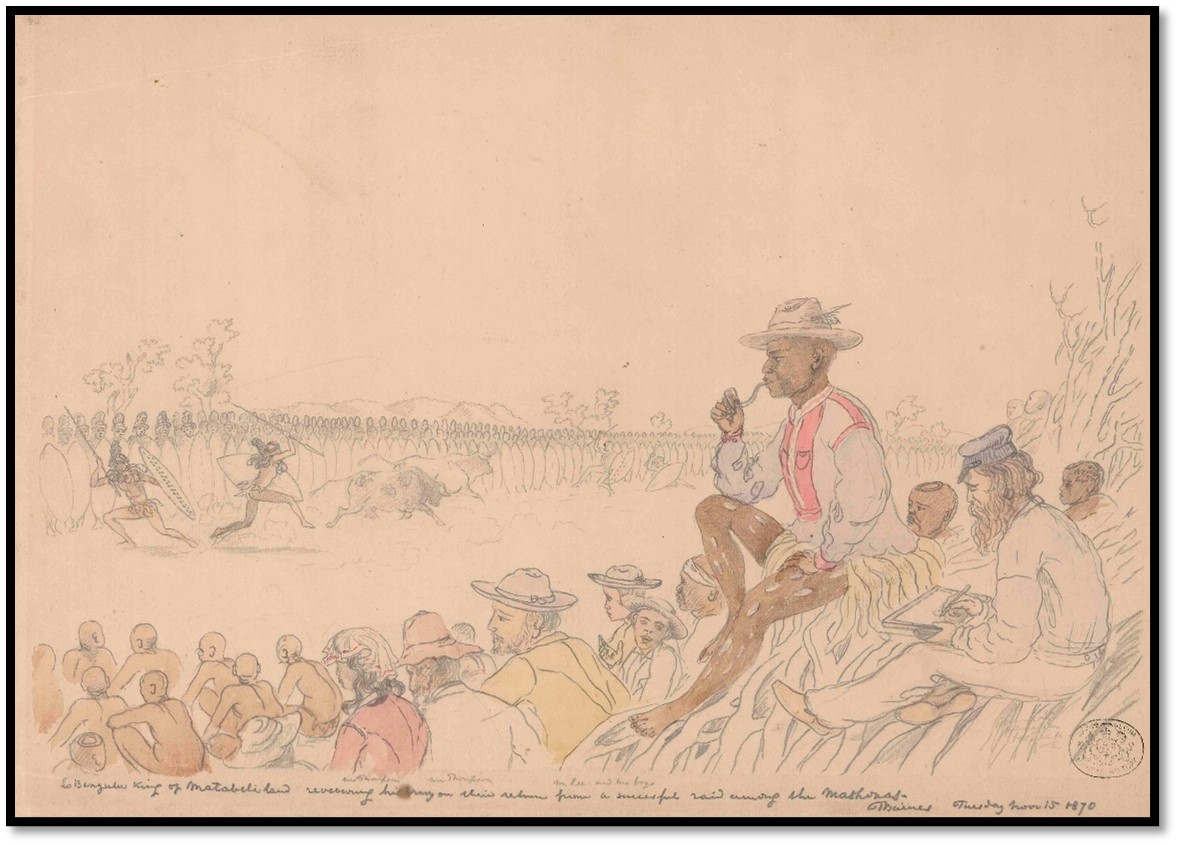
NHM (London) Baines Collection No 60: King Lobengula reviewing his army, Baines sketching with Mrs and Revd Thomson, John Lee and his sons all seated below
16-Nov The cattle were brought into the great kraal and divided. “In the evening we had a general assembly at Mr Kisch’s, our tent and flags for decoration being lent for the purpose and everyone giving cutlery such as he possessed and not crockery, but tin plates, pannikins and kommijies, while Mr Kisch, as host, with delicacies which we, as explorers, had long been strangers to and with the aid of John, his accomplished French cook, regaled us in a manner that left nothing to be desired on the score of plenty, or to be blamed by the staunchest advocate of teetotalism. The pudding was there in all its delicious excellence, but the brandy sauce was impossible. The King and his favourite sister honoured us with their presence, greatly enjoying the feast and conducting themselves with perfect propriety with the slight exception of the latter wiping her fingers on the canvas of the tent…His Majesty's bodyguards sat round outside, singing his praises and we gave him three hearty cheers as he departed.”
18-Nov The king visited after breakfast and asked to see Baines’ sketches, smiling when shown the above sketch. He was surprised that Baines had shot almost every kind of game except elephant because he had not asked the king’s permission. The crocodile attracted his attention and he asked pointedly if Baines left the body and Baines confirmed this as the amaNdebele believed a crocodile liver can be used to deadly effect by a sorcerer.
Messengers arrived to say the army was ready and the king left and the visitors followed. Again messengers announced each regiment’s name and they marched in and took up their stations. The semi-circles were larger and denser than before, perhaps 1,600 – 1,800 men. Some had green branches stuck into the holes in their shields where they had been pierced by assegais. Their commander, Umtigan, described their feats that included killing 192 men and many women and they had lost 22 men.
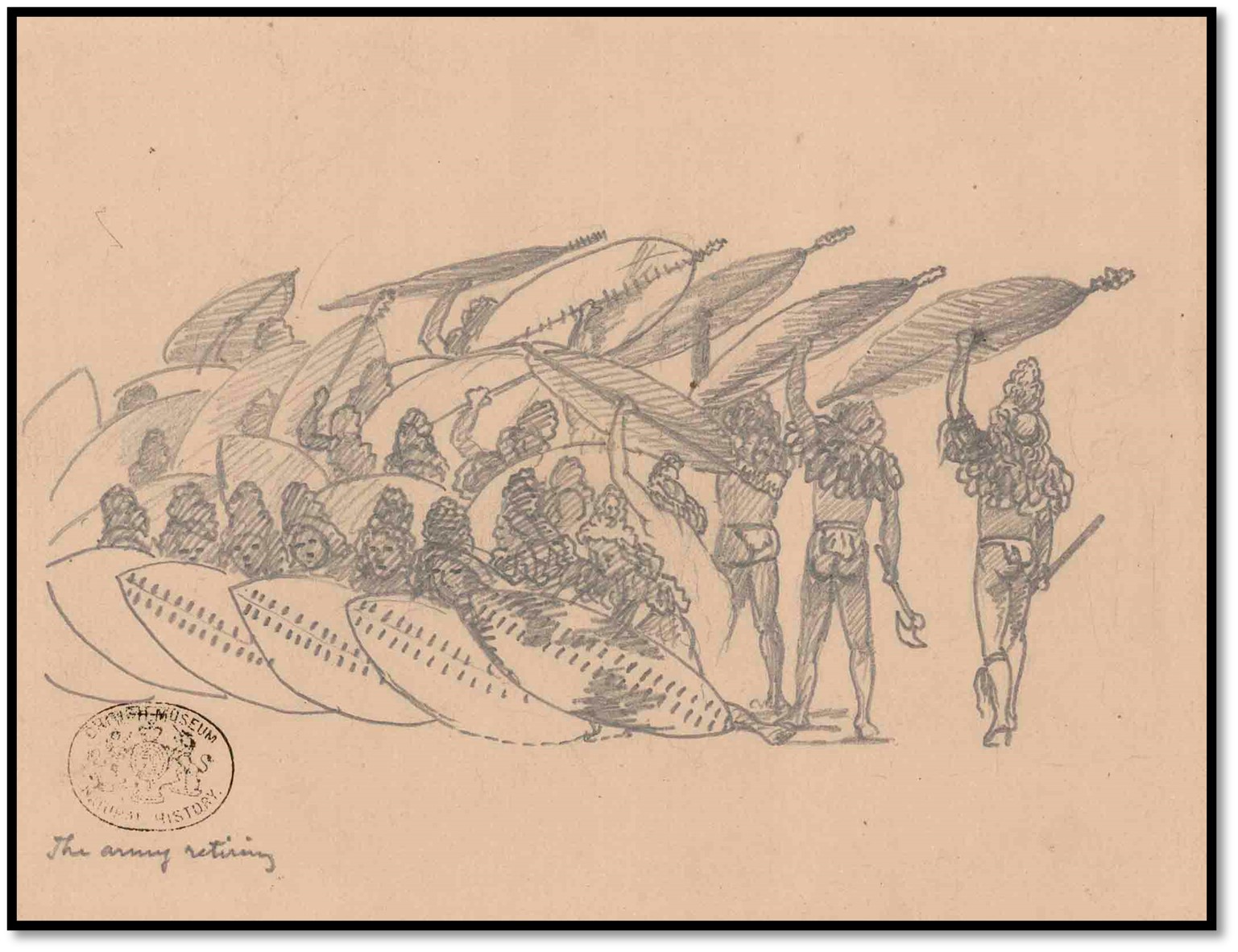
NHM (London) Baines Collection No 66: Lobengula’s army returns
The king told Lee that he was upset that Levert claimed territorial rights to his country in the Tati district when he had only given rights to dig for gold. Baines believes this unfortunate misunderstanding will greatly complicate their own dealings with the king and decides to stick with the verbal permissions given by the king rather than ask for a written agreement.
Heavy rains at night with cold and cutting winds and all the dogs took refuge in Baines’ tent.
19-Nov Continued rain and Baines had the lung-sick ox killed for meat. A white man has brought in a ‘loathsome disease’ hitherto unknown [venereal disease ] and infected an amaNdebele girl. The king told the culprit he thought he ought to kill him but would sentence him to cure the girl.
20-Nov The king came around to see Lee and Revd Thomson and asked to see the quartz samples. Baines showed him a piece in which a speck of gold was visible and Lee explained how small the quantities of gold were and the labour required to extract it. The king asked why Baines did not go on working and Lee said it was because Nelson had not returned. They asked the king if he was fully satisfied with the way Baines had acted and the king said he was fully satisfied with no reason to complain and that he would not withdraw his permission unless something wrong was done.
The king asked for the painting of Willie Hartley’s grave and when shown it said: “will not the sight of it keep his heart [Henry Hartley] very sorrowful?” and Baines said white people wished to keep memorials of those they loved.
Revd Thomson and Lee discuss the ‘loathsome disease’ and believe any infected persons should be compelled to submit to cure and should not cohabit with others until cured. The king seems more sorrowful than angry and declares that if a black man introduced it he would have him killed on the spot but does not want to break friendship with us. They agree the culprit should be ostracised by not inviting him to dinner with them.
21-Nov Still raining, Baines moves his tent to fresh ground. After hearing that John Spearman[l] had been attacked by a lion whilst out collecting poles for the king’s new wagon-shed Baines and Revd Thomson prepare medicines and bandages but it turns out to be exaggerated as a lion attacked the oxen, but no one was hurt. However one of their horses was gored by a bull and they washed and sewed the wound.
Lee spoke to the king about Revd Thomson’s request to establish a mission at Hope Fountain. The king said “his heart was sore” as he had welcomed white men into his country and now they wanted to take it from him. He claimed that Levert of the London and Limpopo Mining Company was claiming the Tati district, land that the king never intended to give. He says: “I gave Mr Levert a cow to milk and he might have milked her dry, but now we wants not only the milk, but claims the cow as if he had won her by conquest.”
A grant however is given for a mission at Hope Fountain. The ground remains the king’s but is granted as a residence for Revd Thomson and his successors, the London Missionary Society to have use of it for as long as they require it, but to revert to the king if they cease to use it.
Revd Thomson, Richard and William Watson and Baines visit Umnombata (Ncumbata) to discuss a translation of the Bible. Ncumbata believes the Zulu Bible should be revised to suit the amaNdebele.
Lee and Baines discuss the anguish the king feels at signing a written agreement with the London and Limpopo Mining Company and decide it is not the time to request a written agreement with the South African Gold Fields Exploration Company and it would be better to trust his verbal promise.
22-Nov Revd Thomson received a very penitent letter from the culprit with the ‘loathsome disease’ who has been told to cure all the infected girls.
The day is spent decorating their tent and collecting supplies for the dinner – four bottles of wine were contributed by Carter. Jacques, Kisch’s cook used the small tent next to their own for cooking. The poor weather meant the king and his sister did not come, but their meals were sent to them. Mrs Thomson was present, Hartley proposed a toast to the health of the king, Baines toasted Queen Victoria and a toast to Jacques was drunk with ‘He’s a jolly good fellow.’ Jewell toasted the missionaries, Revd Thomson toasted Hartley and Baines. Then Baines toasted ‘All who support commerce’ and songs filled the remainder of the evening finishing with ‘Rule Britannia’ and ‘God Save the Queen.’
Carter and Spearman went out with a detachment of amaNdebele after a lion. They each got a shot in before the warriors assegai’d the lion and another lion was killed in a similar way nearby. The carcasses were brought in, the hunters hauling the wagon as oxen get wild when they smell lion. The king gave the two warriors who struck the first blow an ox each as a reward.
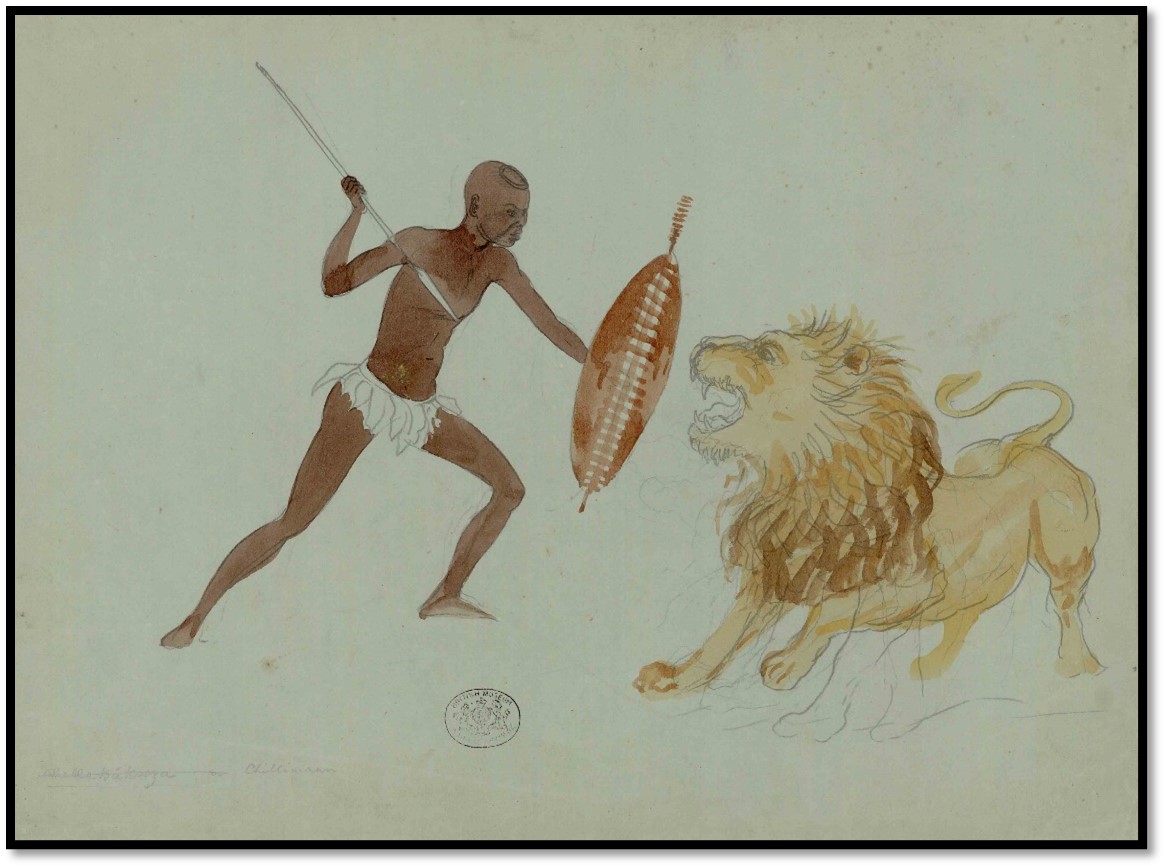
NHM (London) Baines Collection No 88: lion being assegai’d
23-Nov Heavy showers forcing Baines to sleep on a table. The king came down to talk business and Baines was pleased that Lee, Hartley and Revd Thomson were present. Baines describes where he has travelled and all that he has done.
The king was critical of Baines for trading pack-oxen for two guns at Umtigesa’s kraal on 21 July 1870 saying that he was strengthening the king’s enemies. The king then asked if Baines had found gold and he replied ‘yes’ but could not say how rich these deposits were and the samples he had taken would be tested. Lee explained that the king had said that Baines had his permission to dig for gold but that this did not in any way take away his right to his own country. Hartley confirmed he believed this concession to the South African Gold Fields Exploration Company conferred all the privileges it required to work the gold fields. Baines thanked the king and gave his word not to abuse these privileges and that the territorial rights always belonged the king, Hartley and Revd Thomson were witnesses to his promise.
They discussed whether John Lee could take the oath of office to serve on behalf of the Transvaal Republic. The King said Lee held authority under Mzilikazi and now himself and that he could not take office in the service of another power. They discussed the proposed treaty of friendship between the king and the Transvaal Republic to replace the one that had existed with Mzilikazi. The king said he welcomed friendly relations, but that an ambassador should be sent rather than through Hartley who had his own business to attend to and could not give his whole time to diplomatic affairs. Some time was also spent discussing an accusation by a Mr Joubert that Hartley had delivered a gun entrusted to him by the Transvaal President as a present for Lobengula but without the case. Hartley said that at the time there was no gun fit for purpose in the Transvaal Republic, so he bought one, without a case, in Bamangwato.
There was discussion about the tribute the South African Gold Fields Exploration Company would pay for the privilege of digging for gold. Hartley had proposed a yearly fee of £100 for each quartz crushing plant or a salted horse and bridle and saddle. The king said he would not fix a price or take a fee or bargain about the amount of a present. Baines said he would make a present on entering the country that he hoped would please the king.
24-Nov They began striking the tent and packing the wagons. Lee said goodbye to the king, he was anxious to get back to Mangwe as his wife had recently died and he needed to get back to his children.
Inyassi had been given a percussion musket for his services, today Baines gave him a bar of lead and caps and told Jewell to give him powder but he was dissatisfied with the quantity and spoke ‘rather saucily.’ Baines spoke to him and gave him more caps. However Watson heard that Inyassi had been to the king and said he had been given a gun and nothing else, also that Baines had beaten him and exceeded the permissions given by the king.
25-Nov Lee and Hartley saw the king. Lee had mentioned several matters in private conversation that Hartley understood had displeased the king including ‘the treaty of friendship’ that ought to have been brought by an ambassador of the Transvaal Republic and not by Hartley who had entered the country as an elephant hunter. Hartley had asked the king the reason for his displeasure and the king replied that he hoped the matter would be settled amongst themselves. The king’s last words to John Lee were: “Look now! Oude Baas has made a mistake, but you have also gone too far with him.”
George Philips tells Baines that the wounded horse that Baines and Revd Thomson stitched up on 21 Nov has died. Hartley, Baines, Jewell and Watson went to say goodbye to the king, Watson being warned not to get heated if the difficulties with Inyassi were brought up. The king wanted to buy a salted horse from Hartley but would not give a price in ivory that Hartley would sell at.
Hartley asked if he could shoot elephant on the way out and the king said: “you had better let the elephant alone because you will not trade with me and you had better not come back again” but covered his face with his arm and there was a good-natured twinkle in his eyes that could not be hidden. Hartley replied: “do you take away from me the privileges your father gave me and do you not wish to see me as a friend again?” When they left the king said: “Oude Baas when are you coming in again?”
At the wagon Baines told Watson to give Inyassi a lecture on his bad manners. He would have got more by speaking properly than by being impertinent and telling falsehoods to the king. On being told Inyassi was very humble and was given a shirt and pair of trousers.
The king came as they were in-spanning and said goodbye very kindly.
Baines has a good conversation with Hartley in his wagon and says that although Hartley is often impatient with him he acknowledges the way Baines deals with the natives. His own staff, Jewell and Watson, are also often impatient with Baines but he tells them the interest of the company are too important to be sacrificed on petty quarrels.
Baines tells Hartley that he should be rewarded if the quartz reefs he has pointed out turn out to be rich in gold in addition to the company shares that Baines has already recommended. George Wood should also be given 100 company shares for his help.
They hear news that the Australians have obtained 43 oz of gold from 5 tons of quartz at their Tati claim, a very good result as hardly anybody is now left at Tati as the diamond fields have proved more attractive.
At the Kumalo river they find Charlie Meyers and Mrs Zietsman with her family of pretty girls, Paul Zietsman is away buying goats.
A very officious letter from the Portuguese governor of Quelimane arrives addressed to Thomas Baines, representative of the South African Gold Fields Exploration Company complaining that Baines has made treaties with the native chiefs in Mashonaland and saying these can only be legally made with the Portuguese authorities and protesting on behalf of the Portuguese government. It says further that the territory north of the Limpopo river is part of the district of Sofala and no companies can operate in Matabele or Mashona territory without the permission of the Sofala district governor.
Baines replies denying that the Portuguese have territorial rights as it was only ever occupied by a “few widely scattered and solitary individuals” and that the houses they built have long been abandoned. The country is held by Lobengula, king of the amaNdebele who acquired it under their late chief Mzilikazi and Lobengula has given Baines and his company permission to explore. It finishes by saying that his excellency the governor of Quelimane should contact the South African Gold Fields Exploration Company if they have further queries and gives their address at 41, Threadneedle Street, London.
26-Nov Trekked as far as ‘Top of the Hill.’ Hartley with Ogden and Watson shot a wildebeest.
27-Nov Trekked as far as Manyame’s kraal even though it was Sunday because Hartley was anxious to get home.
28-Nov During the morning trek Baines asked Hartley what he thought he should do if Nelson did not return. Hartley said he knew some practical miners in the Transvaal. From Manyame’s kraal they rode on to John Lee’s new house at Mangwe.
29-Nov Baines describes Lee’s house as 50 ft long, 16 ft wide, with a reception and dining room and two bedrooms at each end with verandas in front and behind. The walls are stout mopane poles plastered with lime and a thatched roof. The walls cost 7 oxen and the roof the same.
Baines asks Lee if there would be any risks to the company if he goes down to Potchefstroom or Natal in the summer as the king has given his permission for him to return next year, Lee thinks not. Baines is keen to find out on what basis the company will fund its explorations and to see Reid, their new Potchefstroom agent.
30-Nov Lee asks Baines to write to Revd Thomson to marry Sara Lee, a daughter and David Jakobs. There are numerous Dutch families present at Mangwe and dances and festivities enlivened by fusillades of blank powder into the night. Baines sketches the couple.
Yesterday the Australians who are at the Tati district passed Mangwe on their return. They had been to see the king to find out if Levert’s permission to mine was sufficient or if they needed it directly from the king. It appears their request has been granted by the king in person as he has sent two amaNdebele back with them to check their claim boundaries and report back to the king. Baines concludes that the king denies the right of anyone but himself to give permission or mining rights to others.
December 1870
1-Dec Baines buys a present from Elstob’s little store[li] – half-a-dozen handkerchiefs for the bridegroom and overtook their waggons at the Kwesi (Inkwesi) river and later Hartley’s wagons although he was away hunting.
2-Dec Baines’ confirms the 43 oz of gold from 5 tons of quartz from one of the Australians returning from the king’s. In the afternoon he is at Old Tati, which had a deserted appearance, most people have left for the diamond fields.[lii] Coward’s house, Bunting Lodge, is destroyed, Burrell’s has burnt down and others are empty and falling to pieces. The London and Limpopo Mining Company are finishing a new store. Acutt, the secretary lives in the house built by Kisch that now belongs to Levert, away in Natal. They have received the same letter as Baines received from the Portuguese governor at Quelimane.
The question of claim rights at Tati seems to have settled down. Levert hoped by throwing the country open that it would avoid the confusion from every digger negotiating individually with the king. The king believes this would deprive his territorial rights to the Tati district and therefore refuses to recognise Levert’s claim. The question of interpretation from one language to another adds confusion as many white men have just a smattering of the local language Ndebele and misuse terms or do not know the exact English equivalent.
Acutt shows Baines a dark blue quartz with visible specks of gold and a breakfast cup full of gold weighing 27 oz.
3-Dec Continued business with Acutt. There are reports circulating that a Boer killed one of Matjen’s people and he has blockaded the road to the Transvaal and killed the Boer. There is now a Boer commando ready to attack him and an amaNdebele force on its way to enforce Lobengula’s control. Baines hopes the Boers are not involved as they might then claim the Tati district.
In the evening they enjoy songs and merry-making at Dr Coverley’s house and Baines is asked to make a sketch of Harley’s grave for his relatives. There are only 8-9 white men left at Old Tati and about the same number of Australians at Todd’s Creek about 30 miles up the Tati river.
4-Dec Heavy rain. August Griet, the miner who dug the shafts at Hartley Hill, shows Baines very rich rock samples that may be as much as 1,200 oz to the ton. Dr Coverley is taking specimens for Edwin Oliver, the London company secretary.
5-Dec Hartley is making a potion from the root of the wittegaat boom or white stemmed tree that is supposed to be a remedy for the bite of tsetse-fly, the horse being washed with it and made to drink it.
During the morning Baines sketches the grave of Harley, who died of fever on 7 April 1870. A monument with stone walls 2 ft thick has been erected, the small cemetery at Old Tati contains the graves of Thomas James,[liii] a miner originally in Bailey’s New Zealand Party, who opened up Halfway Reef with Rockey and there is also the grave of the McMaster’s child.
Griet says he has sent home 84 oz of gold mostly from the Blue Jacket Mine, 3 miles east of Old Tati. Those present at Old Tati are Dr Coverley, Brown, McDonald, Griet, Arkle, Ogden and Franklin. There are 3 men at the Blue Jacket Mine and 9 at Todd’s Creek.
6-Dec Robinson arrives from Bamangwato and reports all is quiet.
7-Dec The wagons are ready and business is concluded with Acutt of the London and Limpopo Mining Company. In the evening a singsong of only 10 men, of whom 6 will leave soon.
The king’s wagon has returned from Natal with news that the man who claims to be Kuruman is not him and therefore Lobengula is the undisputed king. Baines is pleased the matter is resolved.
8-Dec Acutt swapped two oxen for two of Baines that are out of condition. He is sending 27 oz of gold with Baines. In the afternoon they left Old Tati, Dr Coverley riding with them as far as the Shashe river that is running about 10 inches deep.
The treks between 10-Dec to 22-Dec are omitted.
23-Dec They arrive at the Marico river whose muddy waters are running at about 3 miles per hour and is now 75 yards wide after the recent rains. Jennings got through with some difficulty with a horse and they believe Maloney has gone to another drift some distance upstream. Hartley has some 3½ inch rope, bought for mining purposes, they take out the buikplank (the bed of the wagon) because it has side-boxes fixed to it and chocks at the ends, they attach half-aums (water casks) as floats and John Jennings swims with his horse taking a line with him.
The large chest in the centre of the raft was filled with ivory, perhaps 300 – 500 lbs and the men on the other bank told to Trek maar (haul away) The men grew more confident after a few trips and when the raft’s bows tipped and swayed when the men hauled too suddenly there were shouts of laughter at those on board from both banks. Heavy goods, such as mattresses, blankets, bedding, rifles and muskets were piled up alarmingly high and hauled over and then the horses were driven across. The oxen halted at the water’s edge until those at the back forced those in the front into the water and they swam to the opposite bank. Yokes and gear were loaded with boxes of maps and papers, but halfway across it became obvious the reims used for lashing the raft had become soft in the water and loosened and the raft became unbalanced. At the same time the hauling line snapped, followed by the line to the other bank.
The raft was now adrift, Mackenzie carried the small line from the other bank, two of the Jennings brothers stripped and swam to the raft, Watson and Baines found an overhanging tree and various articles were handed to them before the raft floated on. Yokes and gear slipped off the raft until it jammed itself under some trees, a line was attached and the raft then hauled to the other side. Jennings then swam over with the return line and the remaining drivers and voorloopers (leaders) were transported to the other side. The oxen were inspanned and the wagons hauled over one by one. One of the wagons floated to the deepest part of the river and was more difficult to manage , but by sunset all were got over in safety and the raft was lifted from the water and the buikplank was refitted to Baines’ wagon. By midnight all the wagons were reloaded with their cargoes, Baines’ double-gun being lost when the raft had tipped over.
24-Dec An early trek and by the end of the second trek they had nearly reached the Limpopo river. Two wildebeest shot supplied some welcome fresh meat.
25-Dec Baines writes until nearly midnight and soon after Oude Baas rouses the men and the oxen are inspanned. At the Stony pool or Klip Kuil they stop and everyone sleeps until sunrise, although Oude Baas was already scolding the men for neglecting the horses. He had found an ostrich egg and with wildebeest heart fat and other ingredients made a pudding.
26-27 Dec Trekking.
28-Dec Arrive in Rustenberg. The town is neatly laid out in squares, the houses mostly white-washed and flat-roofed are few and almost hidden in orchards with quince, peach, fig and pomegranate trees overhanging the roads, on each side run water furrows as in nearly all Dutch towns. In the central square the houses are larger with thatched roofs. In the afternoon trekked over Oliphants Nek to Hex river.
29-Dec Trekked along the south face of the Magaliesberg and Jewell and Baines rode ahead to Witte Waters Rand and the Hartley’s farm named after his birthplace at Thornton, Yorkshire. Their enjoyment of the hospitality only saddened by the loss of Willie Hartley.
30-Dec Spoke to Hartley about a wheel-wright to repair Jewell’s wagon.
31-Dec Hartley and Baines go by spring cart to see Bronkhorst, the wheel-wright where there was racing and target-shooting at Mynheer Grobelaar’s. 25 men were present and the fun was to fire a gun close under their horse’s nose to see if he was startled. Dr Coverley, Jewell and Watson endured the same ordeal.
Baines says there was a good assembly of ladies, many with slender forms and many were just as remarkable the other way! One lady was introduced by Hartley, whose waist he said he used to span with his two hands: “Goodness, how short must his fingers have become or how the waist has enlarged!”
Baines is sorry Bronkhurst cannot repair the wagon.
January 1871
1-Jan A feast of a New Year’s dinner at Hartley’s farm.
2-Jan Jewell and Baines estimate the stores required for the next season and the replacement of their oxen as they are getting worn out. In the evening Hartley jnr. played the piano and they enjoyed a sing-song including an Old Tati version of Doodah.[liv]
3-Jan They cannot leave before Mrs Hartley has finished baking a large loaf of bread. They leave Hartley’s at 4pm. Jewell and Watson go south-west for the main road at Blaawebank, Baines goes south-east through the poort to Fred Hartley’s and then south to the Jennings at Bluebank.
4-Jan Rode 14 miles and overtook the wagons at Hol Fontein and then reached Wonder Fontein another 12 miles on and they visit Mrs Vorster who gives them a hearty welcome.
5-Jan A long early trek to Stompoor Fontein and then Potchefstroom. Baines stops at the mill to get his corn ground; the miller put his horse in the stable, Baines in the house, gave each a good feed and Baines a glass of grog as well!
In the town he saw Forssmann, the Portuguese consul who said the Portuguese government would take possession of the company claim and the land too, “when we have made it valuable.”
Reid, the new company agent, had letters from Edwin Oliver, the London company secretary, stating he must get a written agreement from Lobengula. Baines in his entry on 18 November states he and Lee think it is wiser to stick with Lobengula’s verbal permissions for the time being. Baines visits Levert who is still ill and gets him up to date on the current state of affairs.
6-Jan The wagons are brought into the town. Baines is disappointed that there is still no arrangement to pay John Lee. Baines meets Forssmann, the Portuguese consul and the governor of Quelimane who seem confused. They believe Baines has been in Manicaland, but he has not been that far east and they say they have been fighting amaNdebele when they have only encountered Mashona.
7-Jan The governor of Quelimane visits Baines and shows him a map of Portuguese possessions that includes Lake Nyassa, Lake Ngami and Bamangwato down to Namaqualand. Baines points out that Portugal has never occupied the northern goldfields and there are not even any Portuguese traders in Mashonaland. The governor says the emperor of Monomotapa gave the Portuguese the whole of the country two or three hundred years ago. Baines suggests the gift has never been utilised and the country never occupied. They talked of possessing the country as far as the Portuguese Panjamey (Ganyana, Hunyani, present-day Manyame) but Baines maintains there is no use talking about these distant boundaries when they only occupy Sofala.
Baines writes that the consul has more sensible views advising that the Portuguese open its seaports at Inhambane and Sofala to commercial traffic. Baines thinks the South African Gold Fields Exploration Company should consider a 100 or 200 ton screw-steamer running between Natal and Sofala to move equipment and supplies.
8-Jan Most of the day writing letters and attending Sunday service. Visited Levert twice, but he was still ill and sleeping.
9-Jan Settled with Reid, the new company agent. Bought two after-oxen and supplies for the road. Left a letter for the governor of Quelimane stating the company claim is not in Portuguese territory. The president of the Transvaal Republic has been thinking of a visit to the diamond fields but everyone advises against this and the people of the town refuse to serve in a presidential honour guard. He is even refused passage over the miller’s bridge over the Mooi river outside the town. “Do you know that I am the president of this state?” “And do you know” said the stout miller: “that I am a free burgher of this state and the bridge is mine?
References
J.P.R. Wallis (Editor) The Northern Goldfields Diaries of Thomas Baines (1869-1872) Volume 2. Chatto and Windus, London 1946
Thomas Baines map: https://exhibits.stanford.edu/maps-of-africa/catalog/pn565rk5366
Natural History Museum (NHM) London for painting and sketch images (https://www.nhm.ac.uk/)
Notes
[i] Dr Coverley, manager of the Glasgow and Limpopo Company
[ii] Henry Hartley (1816-1876) Hunter, trader, prospector, guide and Transvaal agent. Greatly esteemed by all early travellers and good personal friend of Baines.
[iii] Sam Edwards (1827-1922) an old hand who served at different times as hunter, trader, explorer, transport manager, interpreter, guide, mine manager and British agent. He had served as transport manager to the London and Limpopo Mining Company at Tati. In 1881 he tried to get a mineral concession from Lobengula and was given the abandoned Tati concession for an annual £50 rental and stayed here for the next ten years as managing director of the Northern Light Company and served as Lobengula’s ‘immigration officer’ in much the same way as John Lee. Very popular with travellers and good friend of Baines.
[iv] Karel Lee, a son of John Lee, was employed by a hunter by Eduard Mohr as a hunter in at Mangwe in 1869 and accompanied the party as a driver.
[v] Arthur Levert (Lieutenant ? - 1874) was second in command of the London and Limpopo Company and in charge after Sir John Swinburne left in South Africa proving to be the better manager and obtained a mining concession from Lobengula. Poor health from malaria forced him to return to England in in June 1871
[vi] James Frederick Elton (1840-1877) was ex Bengal army, travelled in Mexico and in 1868 met Baines in Natal. Known for his exploration of the Limpopo river, travelled widely in Southern Africa including as British Consul in Portuguese East Africa and played an active part in suppressing the slave trade. In 1870 he had some connection with a Tati mining company. Died exploring the Shire river area on 19 December 1877.
[vii] Captain Echalez was a transport rider for the London and Limpopo Mining Company at Tati
[viii] Makalakas is a general description used to describe the people who were conquered by the amaNdebele when they arrived in Matabeleland
[ix] James Cruickshank, an ex-sailor based at Hopetown who traded in Matabeleland in ivory and rhino horns. By 1871 he was trading at Shoshong and in 1875 James Dawson looked after his Shoshong store when he was away. Still resident in 1877
[x] The Portuguese name for the Ganyana – Hunyani (present-day Manyame)
[xi] Ncumbata, the amaNdebele regent between Mzilikazi’s death and the coronation of Lobengula as king
[xii] This website has a number of articles on Thomas Leask including Thomas Leask’s Life and Diaries describing Matabeleland and Mashonaland in the 1860’s / Thomas Leask’s two journeys to the Zambezi in 1868 and 1869 / Thomas Leask (1839 – 1912) and “my last hunt” to Hartley Hills in 1870
[xiii] Paul Zietsman, hunter, trader, farmer and tanner visited the Victoria Falls in 1865. Hunted with Mohr and Karel Lee in 1870 and travelled into Mashonaland in 1870 as far as the Manyame river, stopped hunting in the same year
[xiv] The Northern Goldfields Diaries of Thomas Baines Vol 2, P303
[xv] The Northern Goldfields Diaries of Thomas Baines Vol 2, P282 state the installation was on 22 February 1870, but this was incorrect
[xvi] Present-day Serampore in the Indian state of West Bengal known then for its cloth manufacture
[xvii] Daniel Kisch, trader and London and Limpopo Mining Company storekeeper until he knocked down Sir John Swinburne and resigned to become Lobengula’s secretary
[xviii] The diaries state Hartley, but an email from Ian Mackay gave the answer. Baines is referring to the death of Harley, a well-educated Scot in the employ of the London and Limpopo Mining Company who died of fever at Tati on 7 April 1870.
[xix] In more recent times many small gold mines have been producing north of the Umzingwane river and south of present-day Bulawayo. Baines writes in his diaries (Vol 2 P337) that that south of the watershed is as worthy of examination as the north.
[xx] Frederick Elton wrote Journal of Exploration of the Limpopo River that was published in Proceedings of the Royal Geographical Society of London , 1871 - 1872, Vol. 16, No. 2 (1871 - 1872), pp. 89-101
[xxi] Rev Thomas Morgan Thomas was succeeded by Rev J.B. Thomson in the Matabele Mission at Inyati
[xxii] Stone and Lawson cancelled their Victoria Falls journey and went in 1870 to the diamond fields to work a claim
[xxiii] Dumas river not identified, it is the amaNdebele pronunciation of Rev Thomas’ name
[xxiv] Probably a hooded vulture or a lappet-faced vulture – there are six vulture species in Zimbabwe
[xxv] Henry Hartley’s son-in-law
[xxvi] For fuller details see the article The search for Willie Hartley’s grave under Mashonaland Weston this website
[xxvii] Hartley Hills had endemic malaria during the rains. See the article The story behind Derick Hoste who died of blackwater fever at Hartley Hills in 1893 under Mashonaland West on this website
[xxviii] Paul Jebe features in the article Karl Mauch, explorer and geologist and the man who claimed to be the first European to visit Great Zimbabwe under Masvingo Province on this website. Jebe left Inyati mission in March 1870 with George Wood’s party and died of fever in early April 1870 somewhere between Umtigesa’s kraal and the Mupfure river, unfortunately destroying his notes and diaries in delirium before his death. Baines has indicated on his map the approximate place he died north of the route to Umtigesa’s (See 18-July entry)
[xxix] See the article Lord Randolph Churchill’s visit to Rhodesia in 1891 under Mashonaland West Province on this website
[xxx] The divining bones or wooden tablets are thrown together , when moving a kraal, in case of a lost relative, before going to war, to predict the result of a journey, and in cases of sickness.
[xxxi] the fine thong at the end of a whip
[xxxii] The author of this article has seen the same trees on the Mupfure river in present-days
[xxxiii] Henry Byles had gone to the Manyame river on 9 April 1870 with Willie Hartley, Maloney and O’Donnell. They all caught fever except Byles and Hartley and O’Donnell both died on 29 May. He joined the Jennings party at the Manyame and returned to Hartley Hills with them on 3 August. He made a solo journey to the upper tributaries of the Biri, Serui and Chimbo spruits returning on the 18 August as Baines records
[xxxiv] Elephant males are excluded from the maternal herd when they reach adolescence and join ‘bachelor herds’ consisting of a mix of elephant bulls
[xxxv] See the article The search for Willie Hartley’s grave under Mashonaland West province on this website
[xxxvi] See the article Karl Mauch, explorer and geologist and the man who claimed to be the first European to visit Great Zimbabwe under Masvingo province on this website
[xxxvii] Today in Africa two species of white rhino are recognised the southern white rhinoceros (Ceratotherium simum simum) and the northern white rhinoceros (Ceratotherium simum cottoni) and one species of black rhino (Diceros bicornis)
[xxxviii] See the article Maramuca, a Portuguese Feira dating from 1660 – 1680 under Mashonaland West province on this website
[xxxix] Maramuca site is approximately 12 km north-east of Chakari, the site of Dalny Mine
[xl] Where Baines states Quagga he clearly means Plains Zebra (E. quagga) as the Quagga (E. quagga quagga) was extinct in the wild.
[xli] This description does not describe Maramuca which was deserted from 1680. Also there is no mention of crossing to the west of the Mupfure in the direction of Maramuca. The description ties in with a location much further to the east, perhaps on the watershed west of the Manyame river and much closer to Hwata’s territory in the Mazowe valley.
[xlii] Tiffin is an Indian English word for a type of meal. It refers to a light breakfast or a light tea-time meal at about 3 pm.
[xliii] [1] C.J. Nelson the company mineralogist for the South African Gold Fields Exploration Company had left Tati on 5 January 1870 with Hübner to reinforce the Durban agent Behrens plea for more support from the company’s directors. This was not forthcoming and he left the company joining Swinburne as manager at Tati of the London and Limpopo Mining Company.
[xliv] Hartley is incorrect. The Umvuli (Mupfure) runs into the Umnyati (Munyati) at 18°16´21" S and 29°24´41" E and they become the Sanyati river
[xlv] The diaries say Bembesi, but this cannot be correct, it must be the Bembezana stream that joins the Sebakwe river a little north-east of Kwekwe. All the evidence would point to the Gaika Mine site being the workings that Baines was shown by Mangoma. Roger Summers in his book Ancient Mining in Rhodesia states there were extensive old workings carried out by Mashona miners at the site. The Gaika site north-west to the Bembezana stream is only 9 km and there are meanderings that go “a little to the south of west” as Baines describes.
[xlvi] Artisanal miners do work the gold reefs around Fort Ngwenya. See the article Fort Ingwenya and Cemetery under Midlands province on this website
[xlvii] John Boden Thomson only arrived at Inyati mission on 29 April 1870 and soon moved to Hope Fountain mission. Later moved to Ujiji on Lake Tanganyika where he died
[xlviii] See the article Hope Fountain Mission under Matabeleland South on this website
[xlix] Henry Ogden built the Thomson’s house at Hope Fountain and travelled out of Matabeleland with Baines and Hartley returning in 1875 with trade goods
[l] Tabler writes Joe Spearman
[li] Elstob’s store did not stay in business long, he started cattle trading using goods supplied on credit by W. Francis from Shoshong
[lii] The first diamond found in South Africa was the Eureka discovered on the banks of the Orange River near Hopetown by 15-year-old Erasmus Jacobs. Their neighbour, Schalk van Niekerk, who identified it as a diamond. The first find was alluvial but by 1869 diamonds were being found far away from streams and waterways in yellow earth and in the following years underground in hard rock.
[liii] Thomas James killed when hot ashes from his pipe ignited blasting powder at the Halfway Reef.
[liv] The Tati Doodah song – here the first of seven stanzas:
De Griqua Maidens sing dis song - Doodah, doodah,
De Tati Gold Fields all go wrong – Doodah, doodah, da!
We fiddle and dance all night,
We smoke and sleep all day,
We get our gin from de Popo store
And drink all care away.
Chorus: We fiddle and dance all night, etc.
When to visit:
n/a
Fee:
n/a
Category:
Province:
